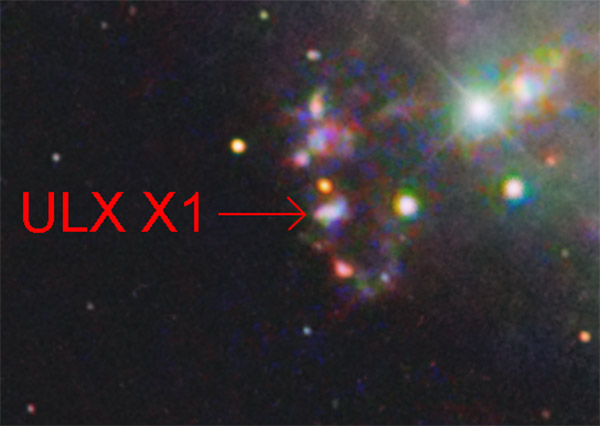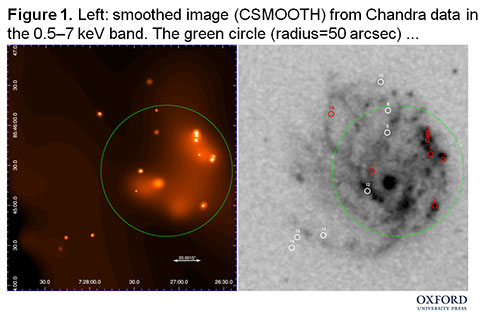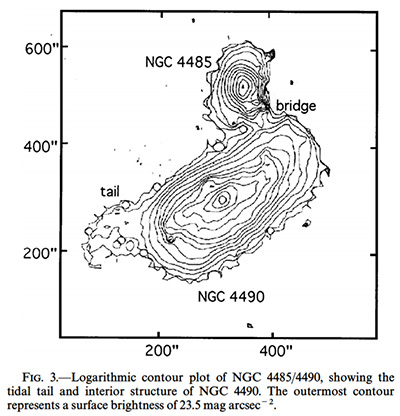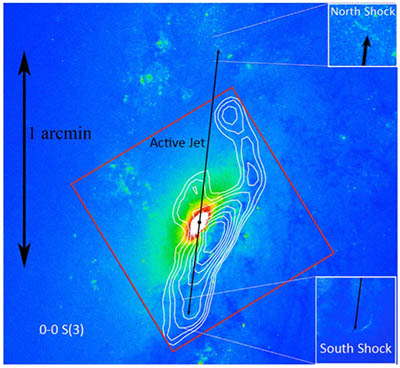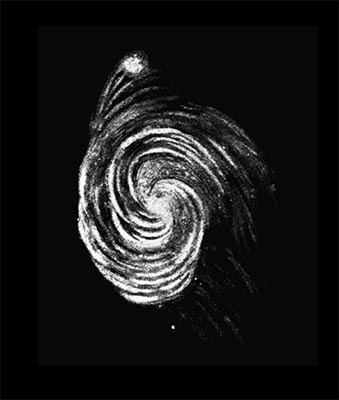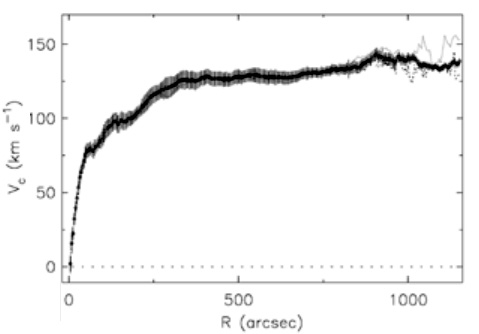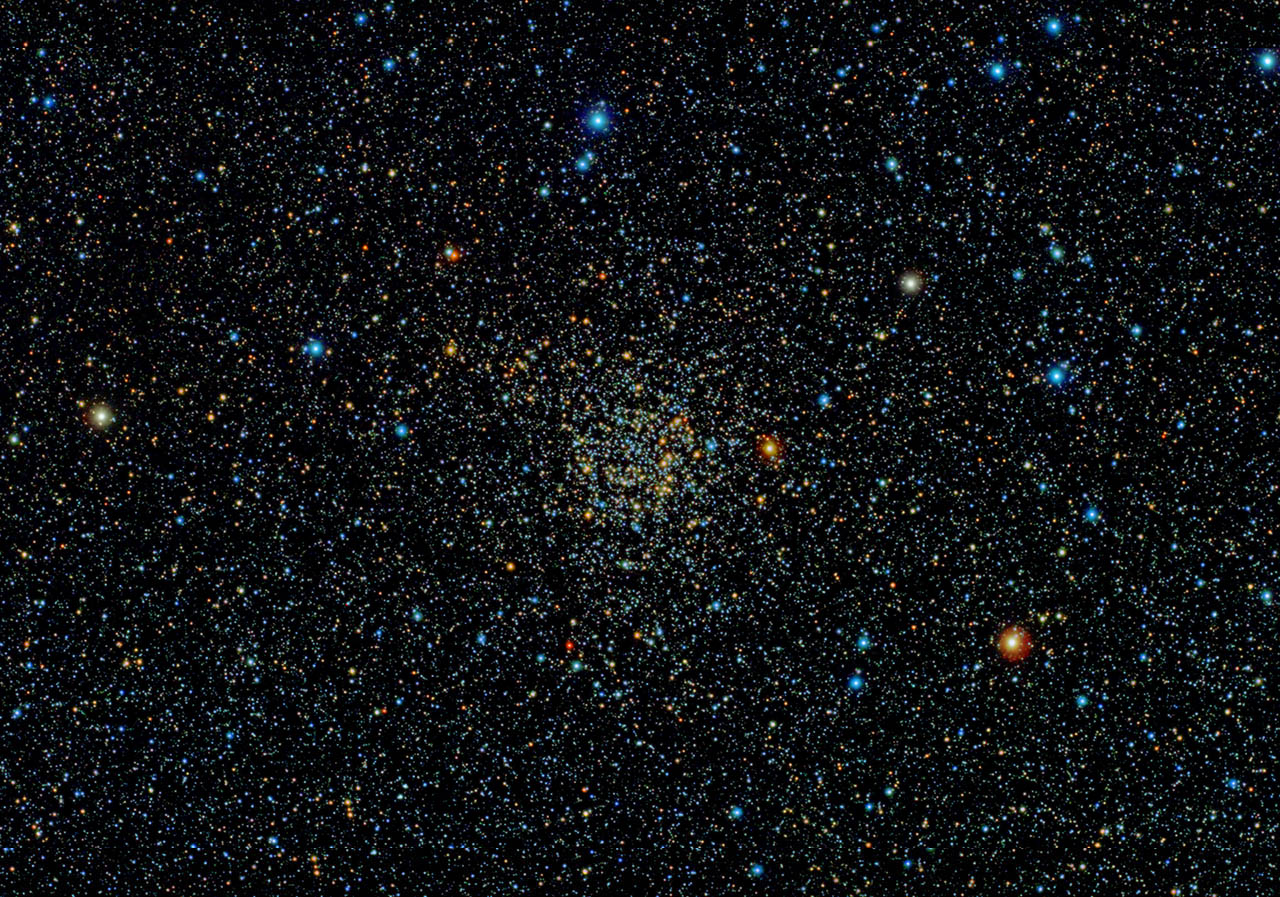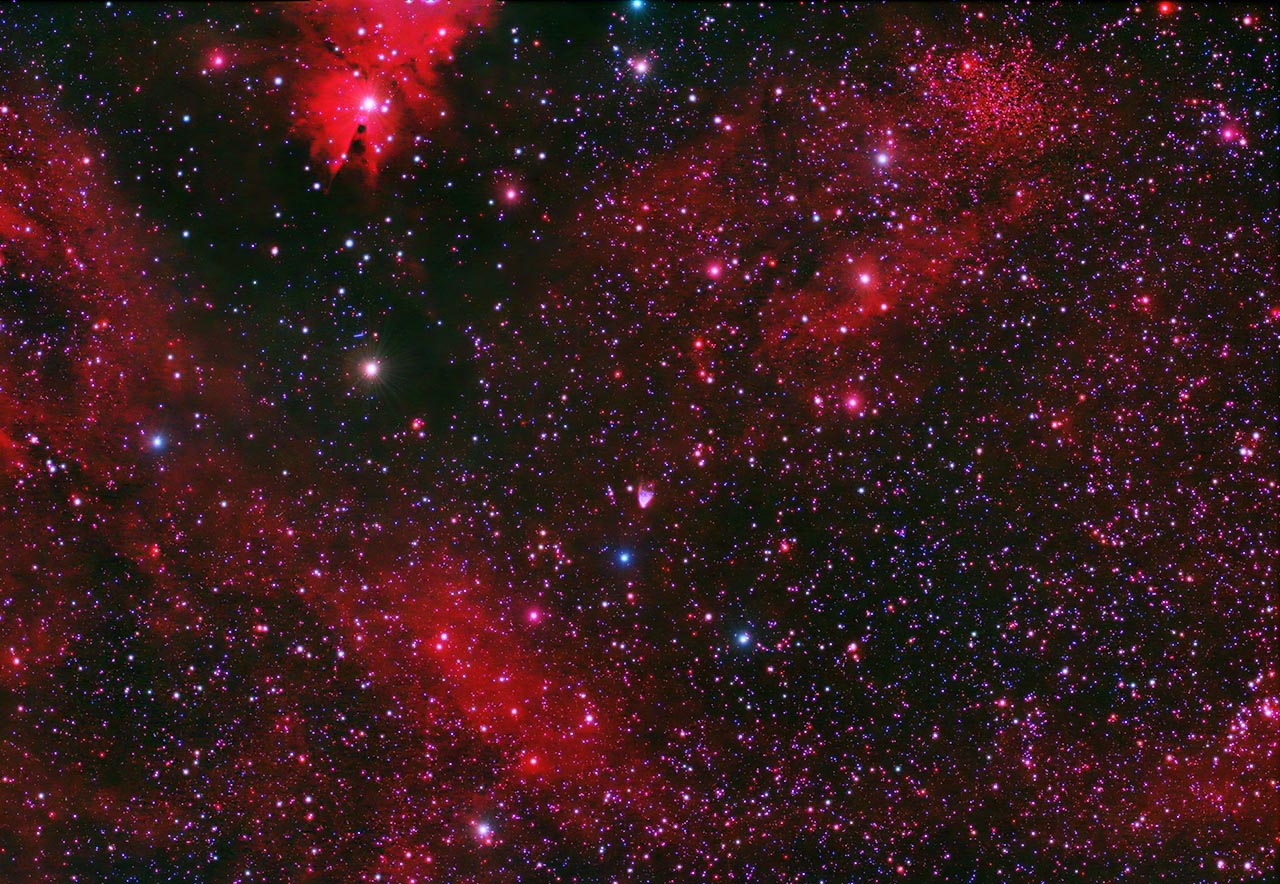ARCHIVE 2019-2021 |
UPDATE 2022 - SInce 7th January 2022 we are now located in Norfolk. These are the last images from Lancashire, UK. Living in Lancashire does make imaging a challenge. Our incessant damp cloudy weather is legendary and coupled with light pollution probably as bright as can be found anywhere (I am 15 miles NW of the centre of Manchester) makes for testing times! Add to that flight path one with constant aeroplanes, which is why it has been suggested as possibly the worst place on Earth for imaging. But there is some good news. With modern light pollution filters we can still produce excellent results - at least when the clouds clear - but of course it's not easy. It would be so much simpler to log onto a robotic rent-a-scope and let them take the image for us. But if you are up for the challenge and the achievement of taking your own images, with your own equipment, in your own back garden, then I hope the following offers some encouragement. Yes it's difficult but we can do it. I shoot the luminance and the colour simultaneously - there are not enough clear spells to allow the luxury of shooting separately. Shooting LRGB with one telescope would take years! So two telescopes and two cameras was the obvious solution . Also necessary is having a dome slot wide enough for both to have a clear line of sight. The luminance is usually taken with the RCOS + Apogee Alta and the colour with the Takahashi + Canon DSLR. Despite their disparate focal lengths this works reasonably well as my current Canon has 4.3 micron pixels (plate scale 2 arcsecs/pixel) and the Apogee 18 micron ones when binned 2x2 (plate scale 1.3 arcsecs/pixel). I find binning essential to maximise signal and improve the signal-to-noise ratio. The images are all taken from my back garden and appear in order of me processing them - we have plenty of cloudy nights for that. I use a combination of IRIS and Maxim for processing with final tweaks in Photoshop. To get rid of the light pollution takes much trial and error. IRIS scores here with several options but processing often comprises many nights work - certainly always longer than the actual taking. The exception are images taken with an h-alpha filter which is a superb light pollution filter. It also permits imaging with strong Moonlight present - isn't it funny how it always seems to be clear at full Moon!
|
|
|
|
17th October 2021The Sign of things to come - the Milky Way over our Norfolk Bungalow |
Unguided shot looking over our new (old) bungalow in Horstead, Norfolk. This spot looks the best for an observatory but that is some time in the future - too many other jobs to do first. There is light pollution from Norwich clearly evident in this view towards the left horizon. Still nowhere near as bad as Lancashire!
|
|
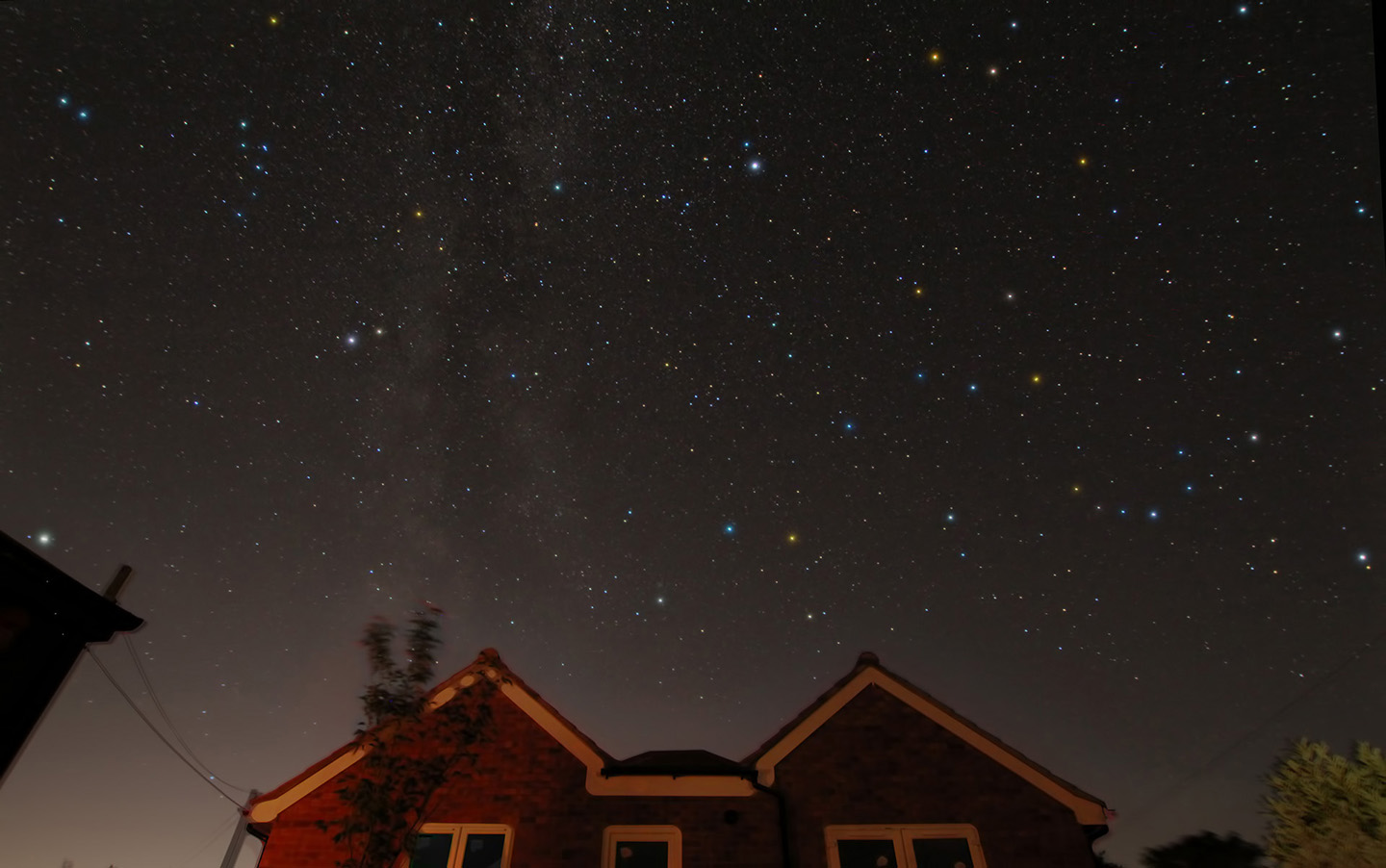 |
The Norfolk Bungalow
|
|
3rd May 2021Last Image from Lancashire - The Box, Hickson 61 |
An intriguing group of 4 galaxies forming an eye-catching rectangle or box - hence the name. However, in reality we are not looking at a true group - one is an interloper. The colour and detail gives a clue in that the blueish galaxy (61b) is the odd one out. It is relatively nearby at around 25 million light years. The other 3 probably form a background trio at 180 million years but distance estimates for 61c place it a bit nearer at 140 million light years. Galaxy 61a is the brightest and looks like an elliptical but is in fact a lenticular S0 type ie a disk galaxy without spiral arms. Galaxy 61d despite being the smallest actually has the brightest nucleus and was classified by Markarian as 761 in his catalogue of galaxies with excessive UV brightness. a = NGC 4169 S0
|
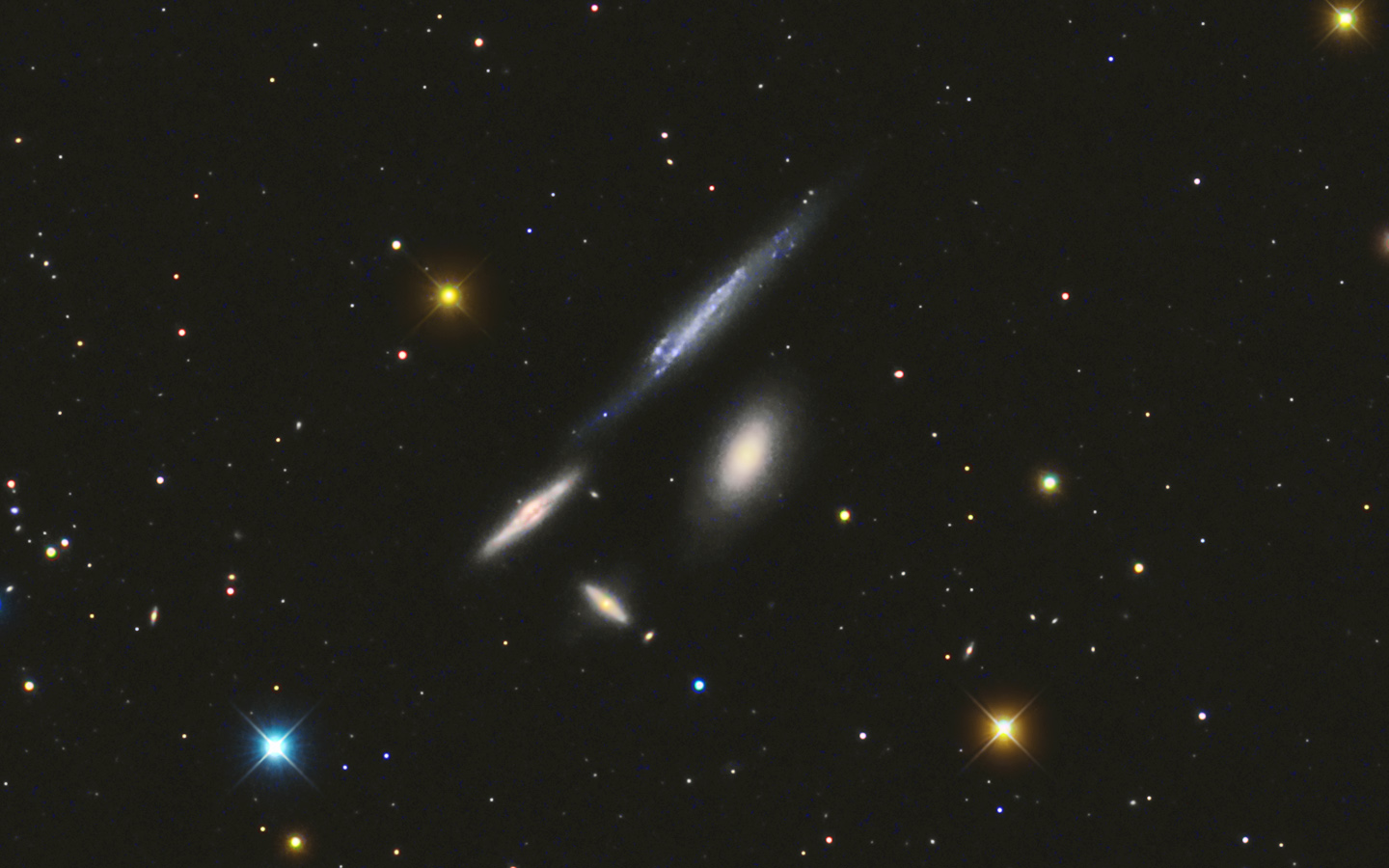 |
The Box
|
|
15th April 2021Dwarf Galaxy Holmberg II |
Another galaxy renownd for its Ultra Luninous X-ray source. This time it is a more local dwarf irregular galaxy in the constellation Ursa Major. It is an outlying member of the M81 Group of galaxies and is around 10 million light years distant. II hosts an ultraluminous X-ray source whose location is shown right. Generally suggested that it is caused by an intermediate mass black hole pulling in surrounding material. The galaxy is probably most famous for a Hubble Space Telescope image taken in H-alpha highlighting the many (red) star forming regions. My image is broadband so the emission nebulae are mixed with young blue stellar regions. Holmberg II was discovered by Erik Bertil Holmberg.
|
|
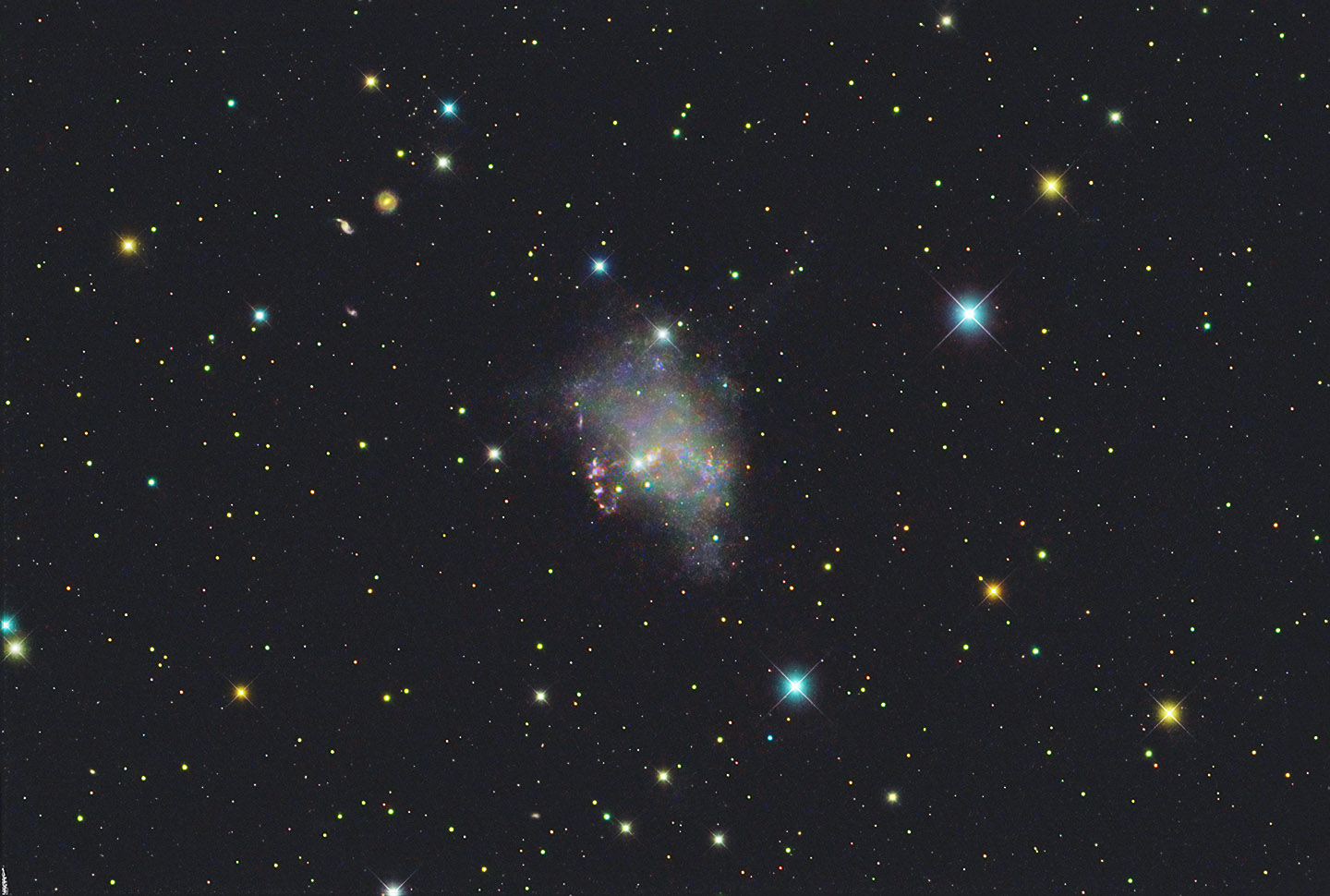 |
Holmberg II
|
|
1st April 2021The NGC 2300 Group of Galaxies |
Although close in the sky to several prominent galaxies in Ursa Major this sparse group is much further away at around 100 million light years. It is dominated by the elliptical galaxy NGC 2300 (classed type S0) and the distorted spiral NGC 2276. Together they comprise Arp 114 and are located in the constellation Cepheus. NGC 2276 is by far the most interesting and classed as an Sc spiral undergoing a starbust phase. However, it is most famous for its X-ray sources categorised as of the ultraluminous X-ray source (ULX) type. Wolter et al using the Chandra X-ray detector found no less tha 8 ULX type. The Chandra X-ray Observatory (space based) is the world's most powerful X-ray telescope. See image right and reference:- NGC 2276: a remarkable galaxy with a large number of ULX, Anna Wolter, Paolo Esposito, Michela Mapelli, Fabio Pizzolato, Emanuele Ripamonti Monthly Notices of the Royal Astronomical Society, Volume 448, Issue 1, 21 March 2015,
|
|
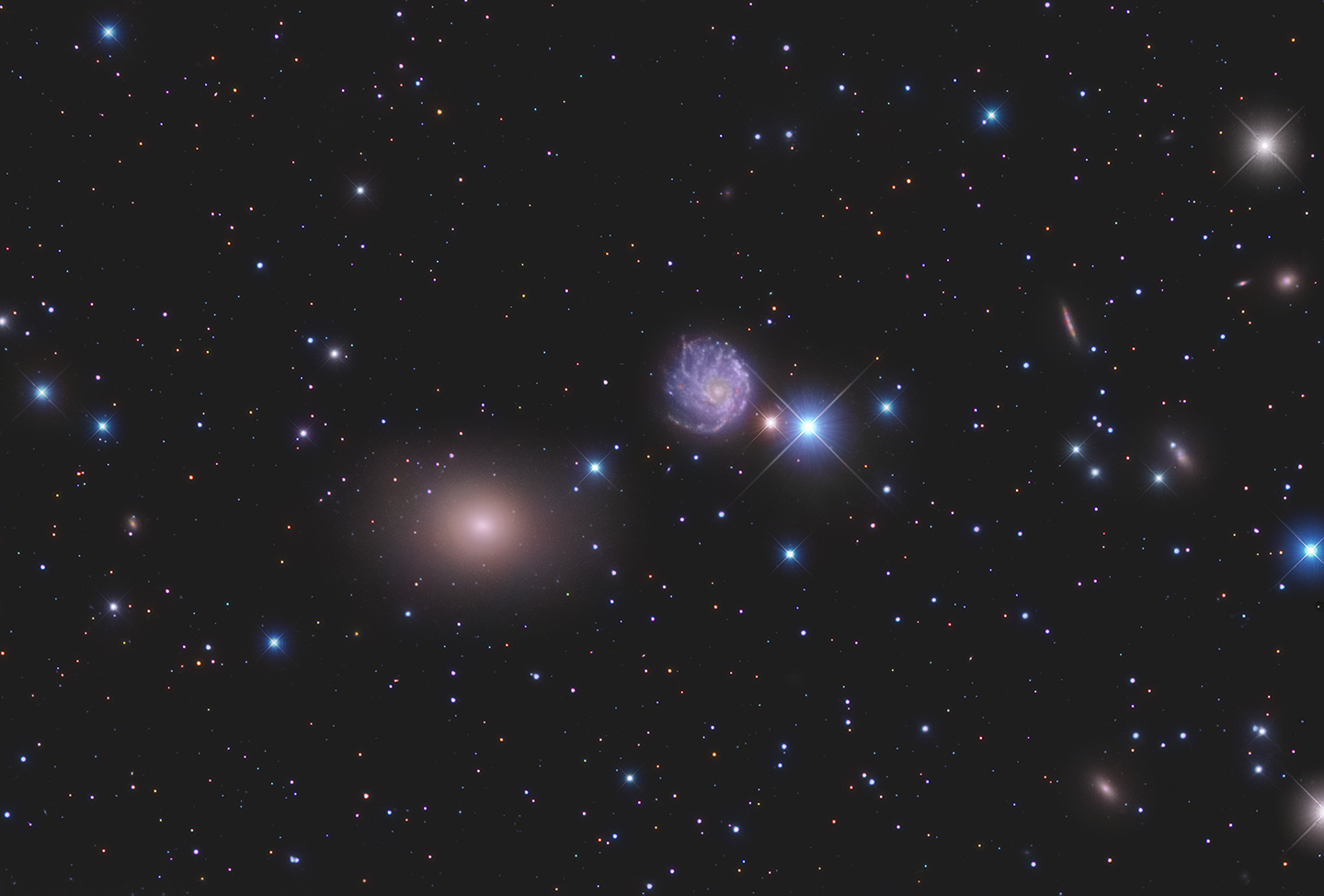 |
NGC2300 Group
|
|
14th March 2021The Lemon Slice Nebula, IC3568 |
I was attracted to this one not by its name but by its claim to be the most northerly planetary nebula in the Milky Way. Its appearance is very bland and is almost perfectly symmetrical - presumably ejected by a single star rather than one in a binary system. What about its name? Aren't lemons yellow? It is all down to a Hubble Space Telescope image - one of the very few images of this object. For the Hubble image they used false colour with the nebula depicted mostly yellow. Hence the (erroneous) descriptive name. Oops! Fairly bright (mag 11.6) but small nebula requiring only shortish exposures to record it... and its true blue/green colour. Located in Camelopardalis.
|
|
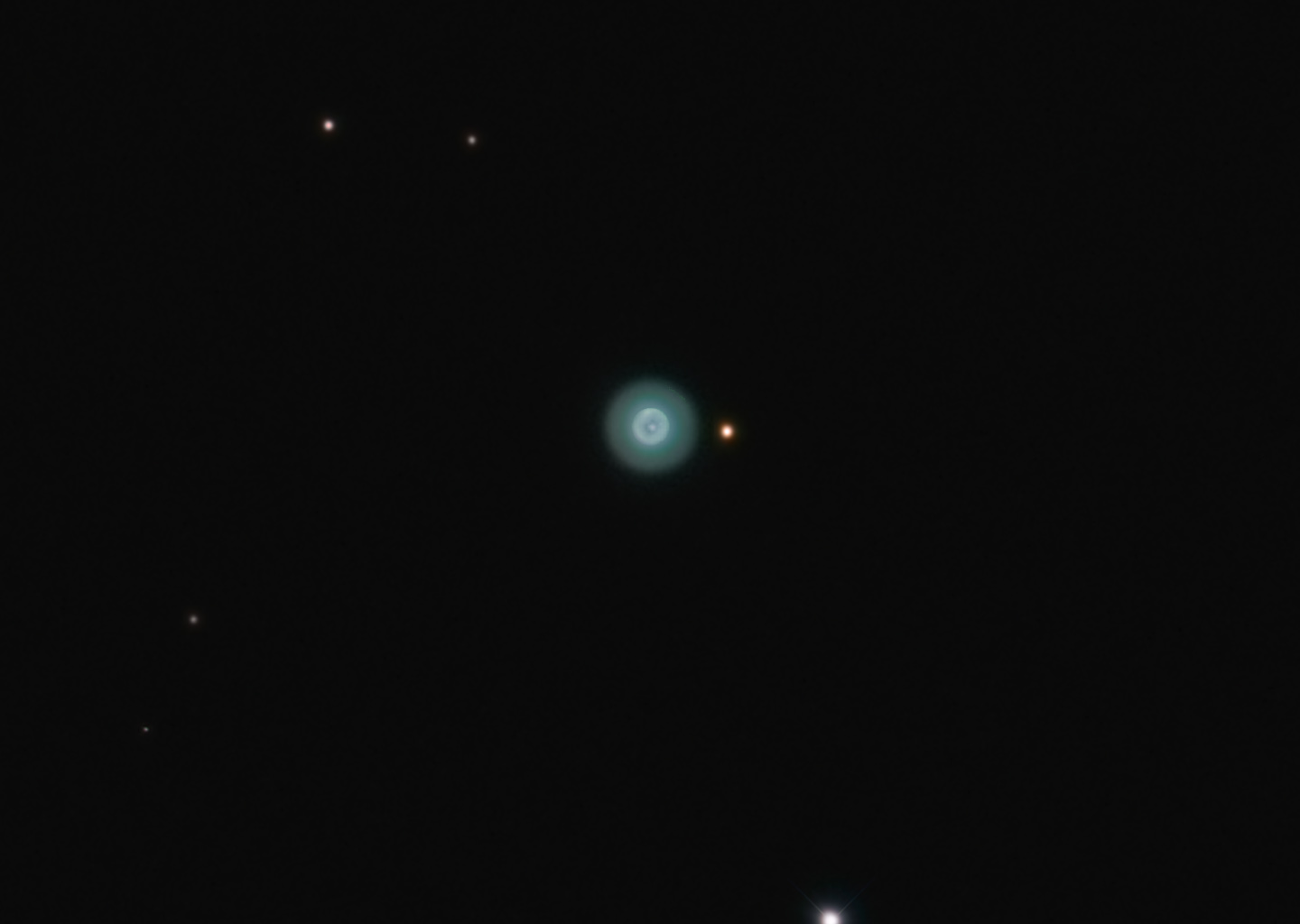 |
IC 3568
|
|
1st March 2021Running Repairs - New Focuser |
End of February the 18 year old electronics of the RCOS telescope failed. These were known as the Telescope Comman Centre (TCC) and mine probably survived longer than most others. The TCC controlled the secondary focuser, the secondary dew heater and the cooling fans. The solution was to abandon the secondary focuser and install a manual unit on the back plate. I was able to get a secondhand Astro Physics 2.7 inch focuser and Brian adapted the mounting plate to attach it. These focusers use the same threads as the RCOS so my imaging train (off-axis-guider, filter drawer and camera could be screwed back on. The 3 fans have their own power socket so they are back up and running. All I have lost is the secondary heater. |
|
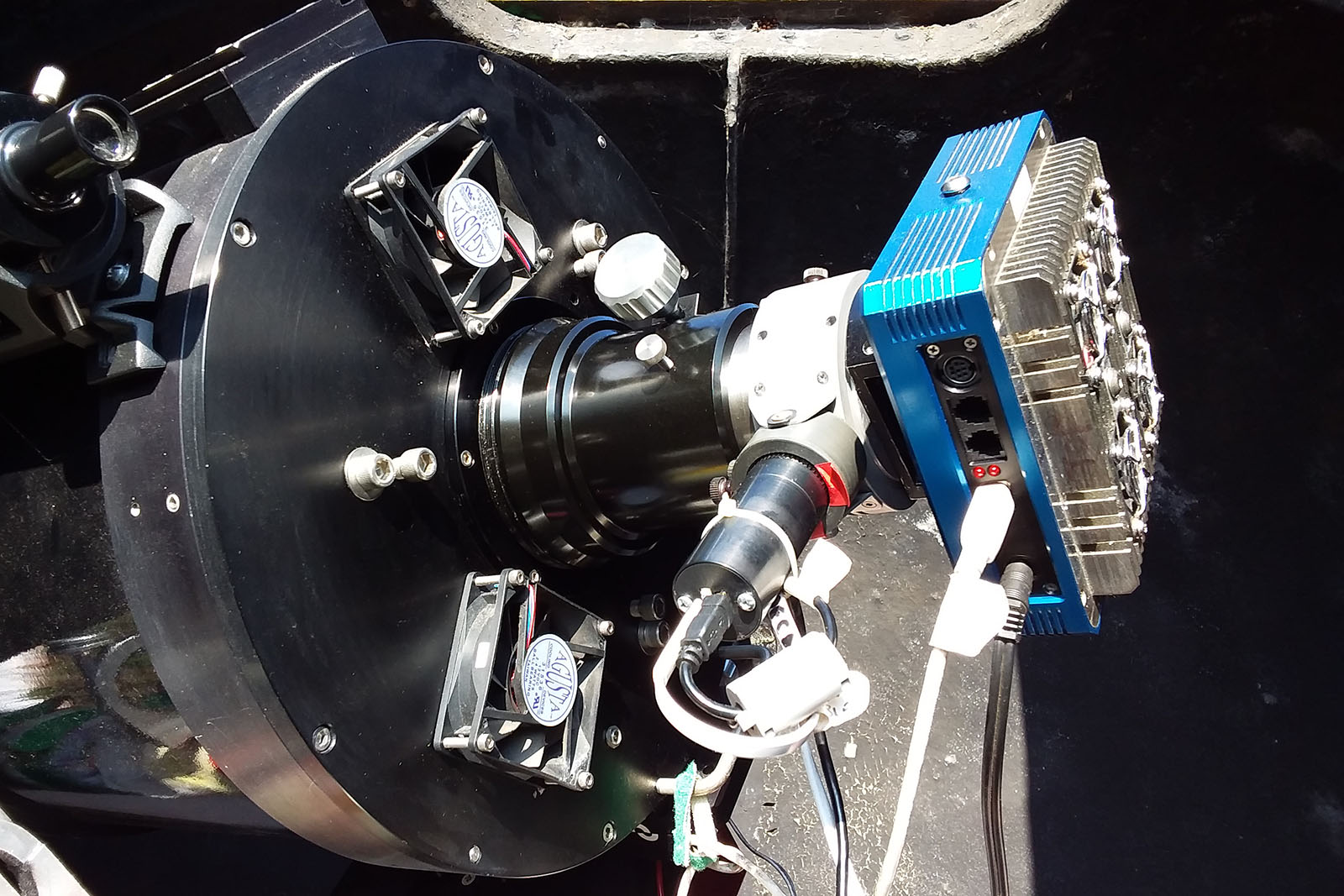 |
New Focuser
|
|
14th February 2021The Giant Spiral Galaxy, NGC1530 |
Called a giant because it is at a distance of 114 million light years and yet looms large in amateur telescopes. This would give it a diameter of around 155,000 light years, perhaps a touch bigger than the Andromeda Galaxy. However, its most prominent feature is of cousre its striking bar - one the best in the northern hemisphere. Note how the main trailing arms have shorter counter-arms in the opposite direction. The dynamics of NGC1530's bar has been intensely studied over the years. One of the research papers by Zurita et al., in 2008, came up with this interesting conclusion: "We believe that the present work shows new important results which favour the hypothesis that star formation in bars takes place principally on the trailing side of the bar, in places where high gas density is present, although not the highest of the bar, but simultaneously low shear and low relative velocity with respect to the bar is found." Visual inspection of the image would tend to confirm this - the trailing edge on both sides is much brighter (galaxy is rotating clockwise).
|
|
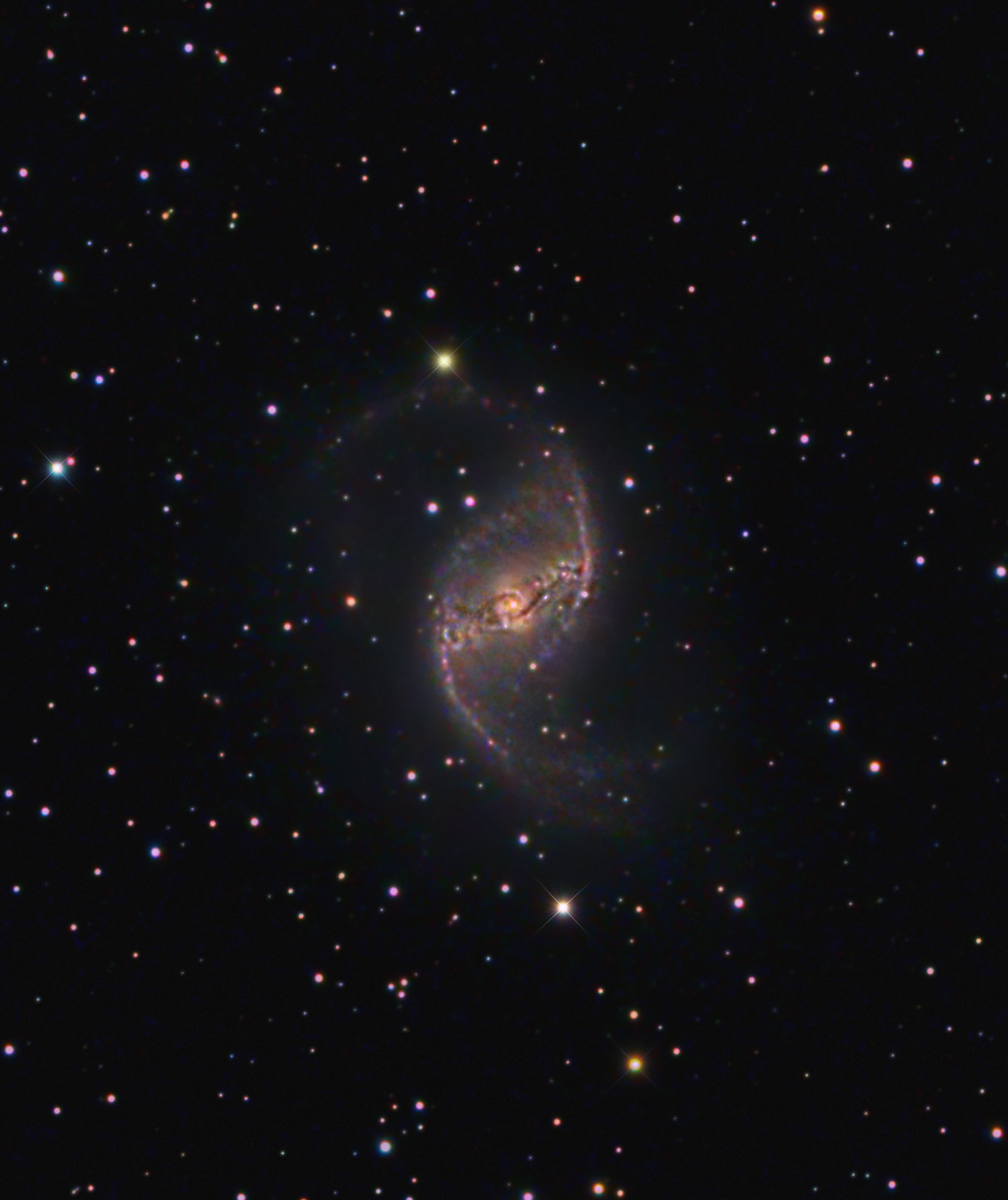 |
NGC1530
|
|
1st February 2021The Hidden Galaxy IC342 |
Called the The Hidden Galaxy as it is lost behind the Milky Way. If it were not so obscured it would be one of the showpieces of the nothern hemisphere. The core is actually detetable with a small telecope or even binoculars but its true spiral form and size needs long exposures. Because it is obscured its distance has taken a long time to nail down. Edwin Hubble even thought it was close enough to be part of our local group. The most up to date research I could find was a study entitled Infrared Tip of the Red Giant Branch and Distances to the Maffei/IC 342 Group by Wu et al. in 2014AJ. Their new distance was 11.25 million light years. Previous estimates kept it vague at about 7 - 11 mly. It lies just beyond our local group and is part of a group which includes the Maffei galaxies. Discovered by English astronomer W.F. Denning from Bristol in 1890 using using a 10" reflector. It is located in the constellation of Camelopardalis.
|
|
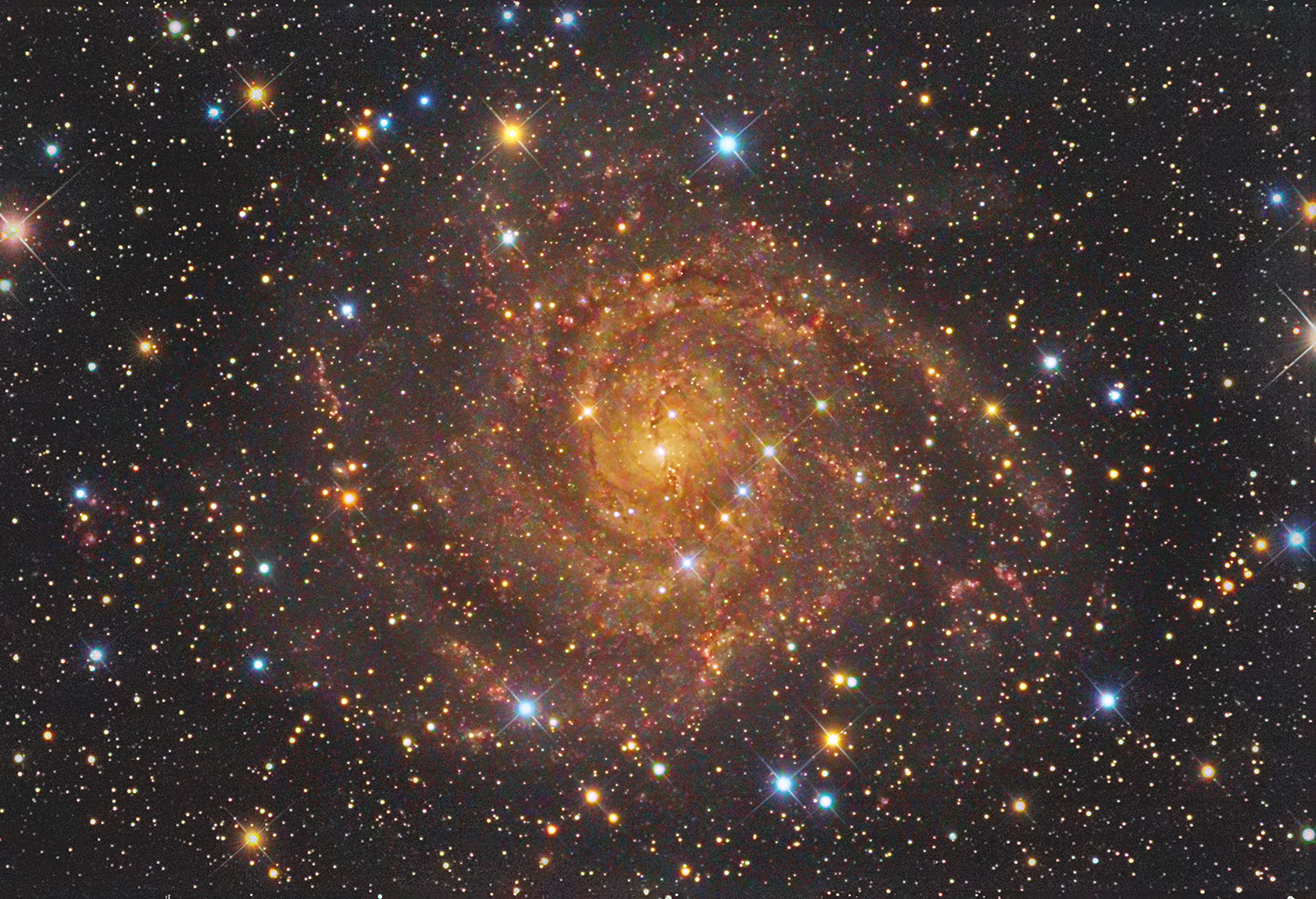 |
IC342
|
|
22nd January 2021Polarissima Borealis & the Galactic Cirrus |
For northern hemisphere observers this spiral galaxy is visible at any time of the year. It does though come with serious challenges. Being within one degree of the pole is a problem for equatorial mounts as they are not at their best up there. A big clue to the difficulty in imaging this object is its catalogued size, commonly quoted as 1 arc minute. This is totally erroneous as it is around 4 times bigger than this indicating that deep images of it are hard to come by. Not only is the galaxy spectacular with what appears to be a single long spiral arm curving all the way around it, plus there is, in addition, a second face-on spiral galaxy involved and a tiny edge-on one too. However, what makes this galaxy special is that it is surrounded by clouds of galactic cirrus. These clouds cover most of the north galactic pole area and would be much better known if it were not so difficult to image there. We are fortunate that they thin somewhat just where NGC 3172 is positioned. These clouds are reflection nebula, gas and dust, but rather than shining with light from a single star, they are illuminated by the whole Milky Way galaxy. If you are wondering about the name then traditionally a polarissma is a star close to the Earth’s poles. Borealis mean northern so the name does have a certain logic to it but of course it is a galaxy not a star. This object is one of my all-time favourites. It really does bring it home that we live inside a dusty galaxy from where we peer out into the universe at large.
|
|
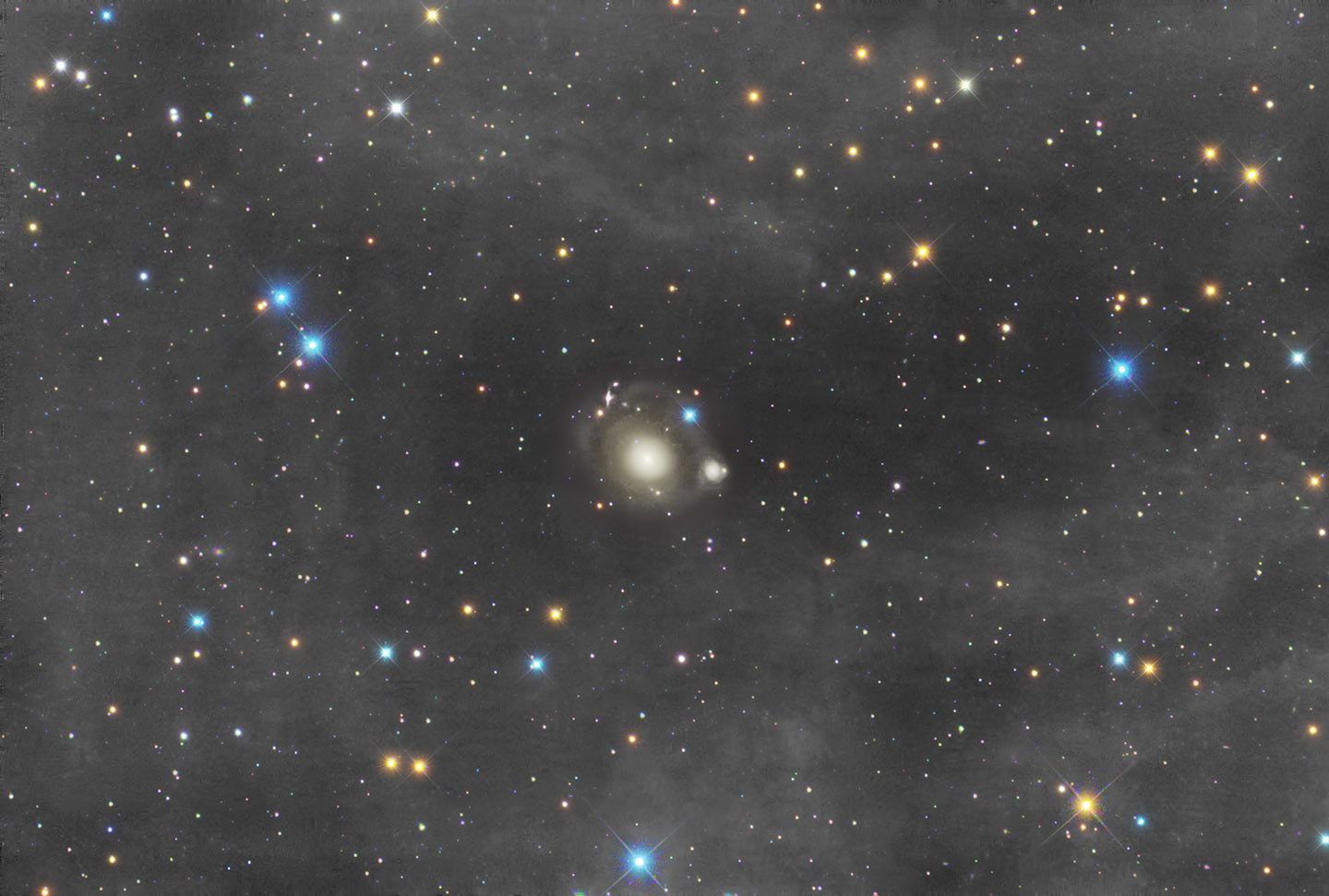 |
NGC 3172
|
|
11th January 2021Kemble's Kite Asterism |
Nowhere near as famous as his Cascade asterism and just as good but for some reason this asterism is much less well known. Located in northern Cassiopeia, near to its border with Camelopardalis, this asterism is also about 2° long and represents a diamond shaped kite with a tail. Best in binoculars.
|
|
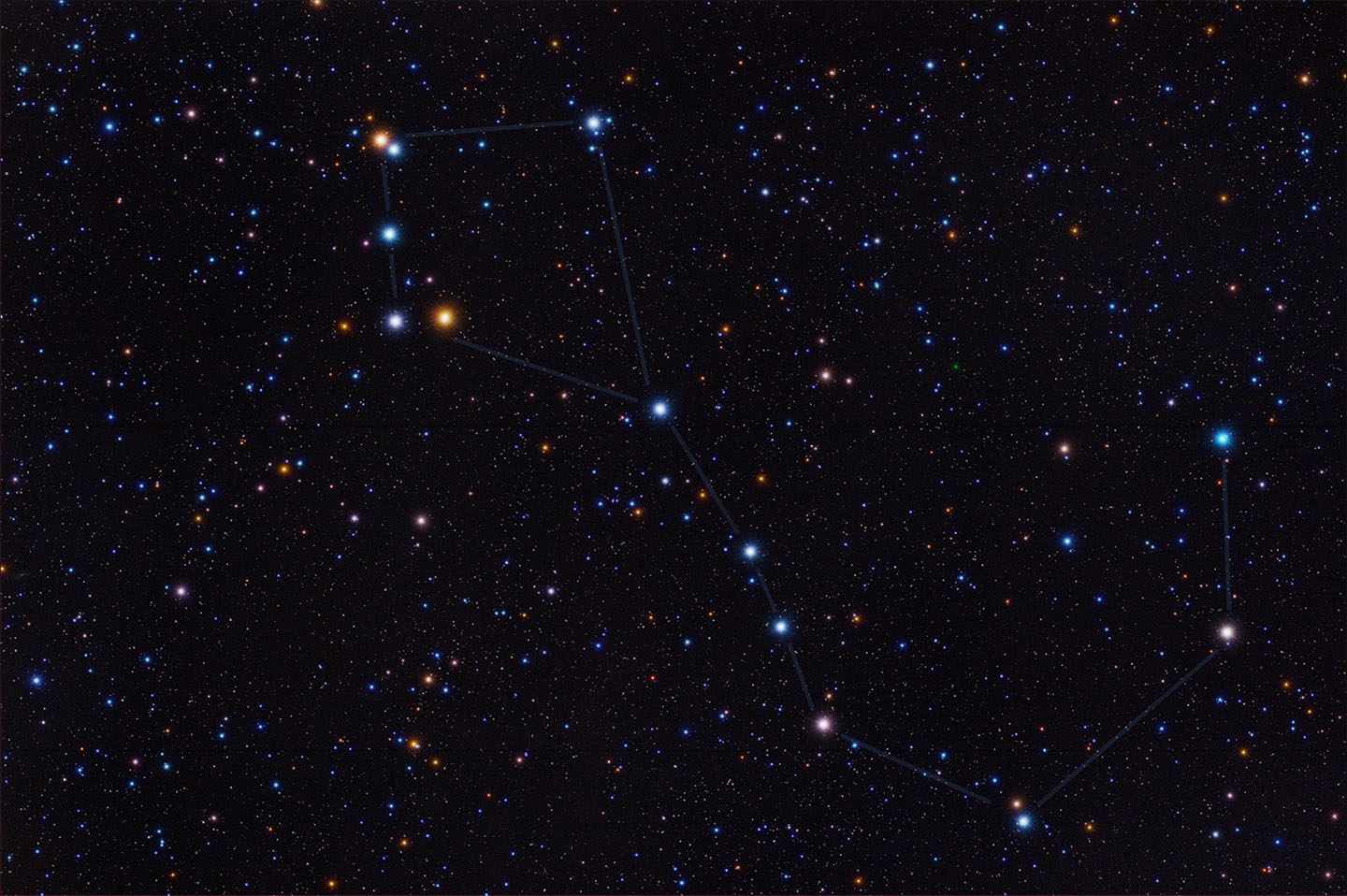 |
Kemble's Kite
|
|
11th January 2021Kemble's Cascade Asterism |
Father Lucian Kemble was a keen binocular observer and, whilst sweeping across featureless Camelopardalis, came across a 2° long string of stars. At the end of the string was the misty patch of open cluster NGC 1502. He likened the asterism to a waterfall ending in a pool. He reported his discovery to Walter Scott Houston of Sky & Telescope and the name Kemble’s Cascade was the result. For more asterisms like this see the Asterism section.
|
|
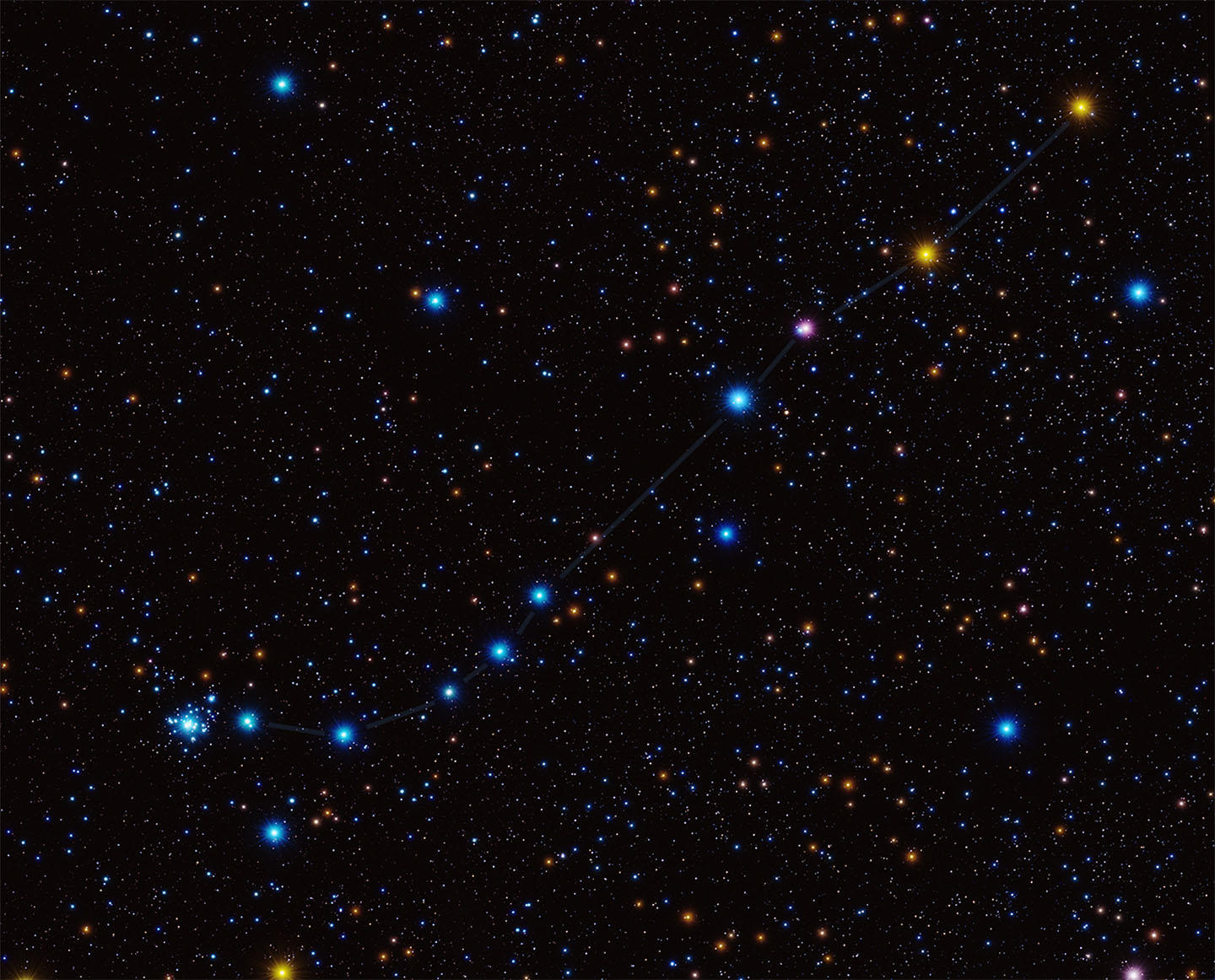 |
Kemble's Cascade
|
|
3rd January 2021Reflection Nebulae Van Den Bergh 14 & 15 |
These Van den Bergh's blue reflection nebulae are two of his best. However, they are faint and would benefit enormously from a truly dark sky - rather than light-polluted Lancashire. There is some red (emission) present in VDB 15 (left, south). North is to the right in my shot and we are high up in Camelopardalis. VdB 15 surrounds the mag 5 central star C Cam while VdB14 is close to the mag 4 star B Cam. Both nebulae are in fact part of the same molecular cloud and they lie at a distance of around 2600 light years.
|
|
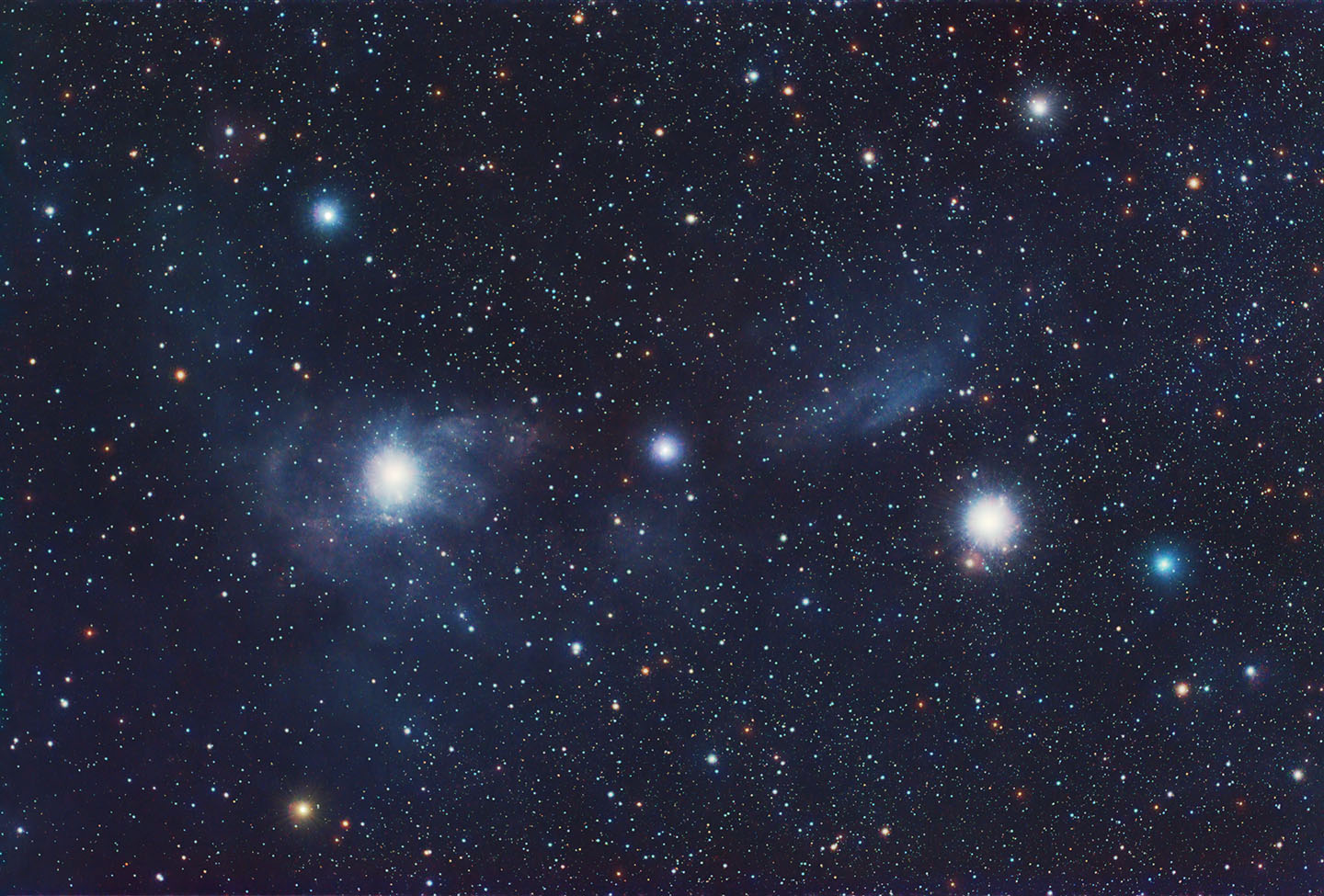 |
VdB 14 & 15
|
|
27th December 2020Gamma Cass Nebula (IC59 & IC63) |
Both nebulae are illuminated by the giant star Gamma Cassiopeia - 40,000 times more luminous, 15,000 times more massive and rotating 150 times more rapidly than our Sun. The east (left) nebula is mainly an emission nebula (h-alpha) whereas the northerly one is mostly a (blue) reflection type. This is believed be caused by a disk surrounding Gamma Cass shielding it from direct UV light. Evident from their shapes iis that they are both being eroded by Gamma Cass.
|
|
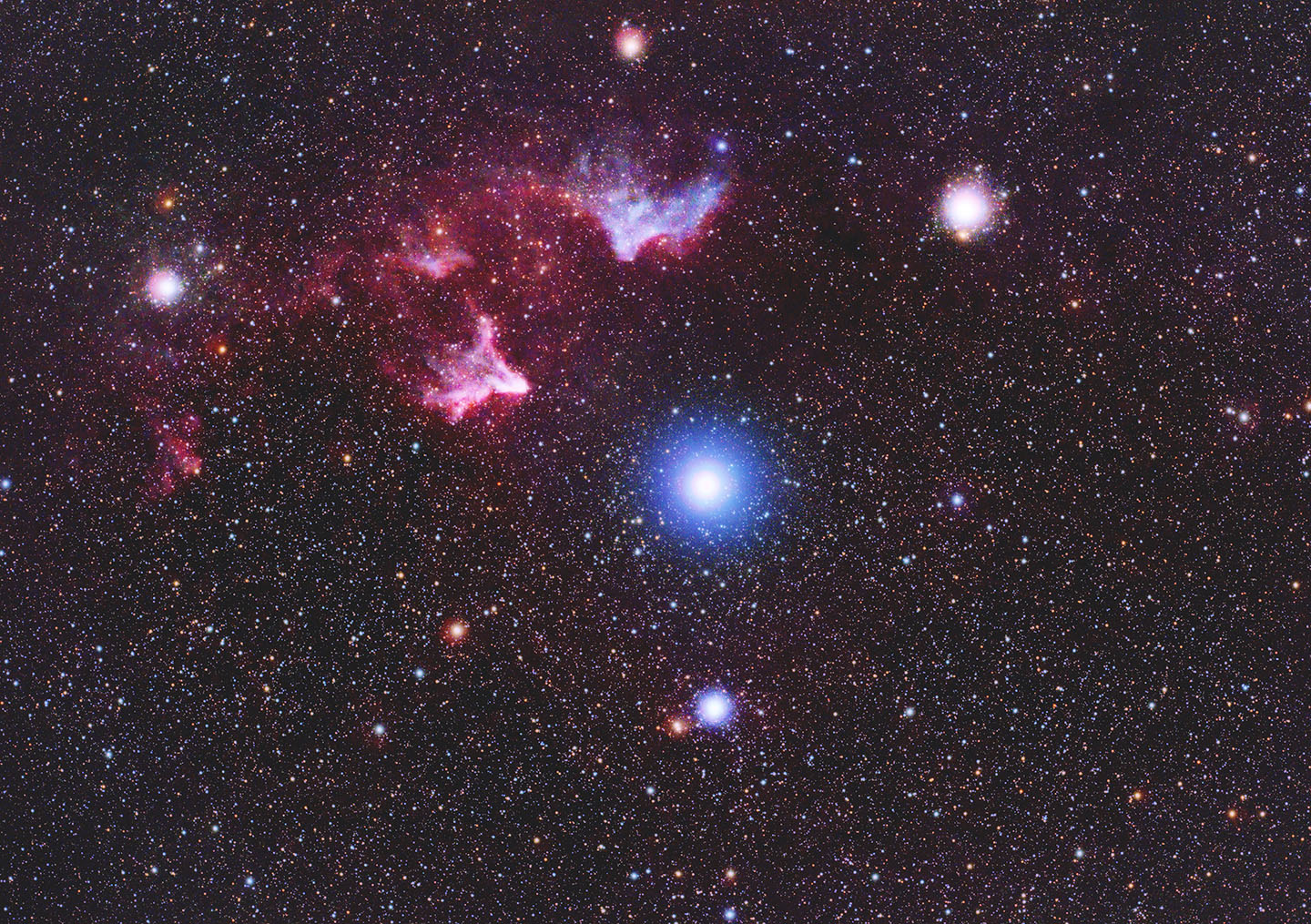 |
Gamma Cass Nebula
|
|
20th December 2020The Grand Conjunction of Jupiter & Saturn, 20th December 2020 |
The two planets are closest tomorrow (21st) but our weather forecast gives no hope so I got in a day early. Visually Jupiter is so much brighter than Saturn that it is no where near as spectacular as the hype. Still this close only comes around every 400 years and if you run the clock back there was another in 3BC.
|
|
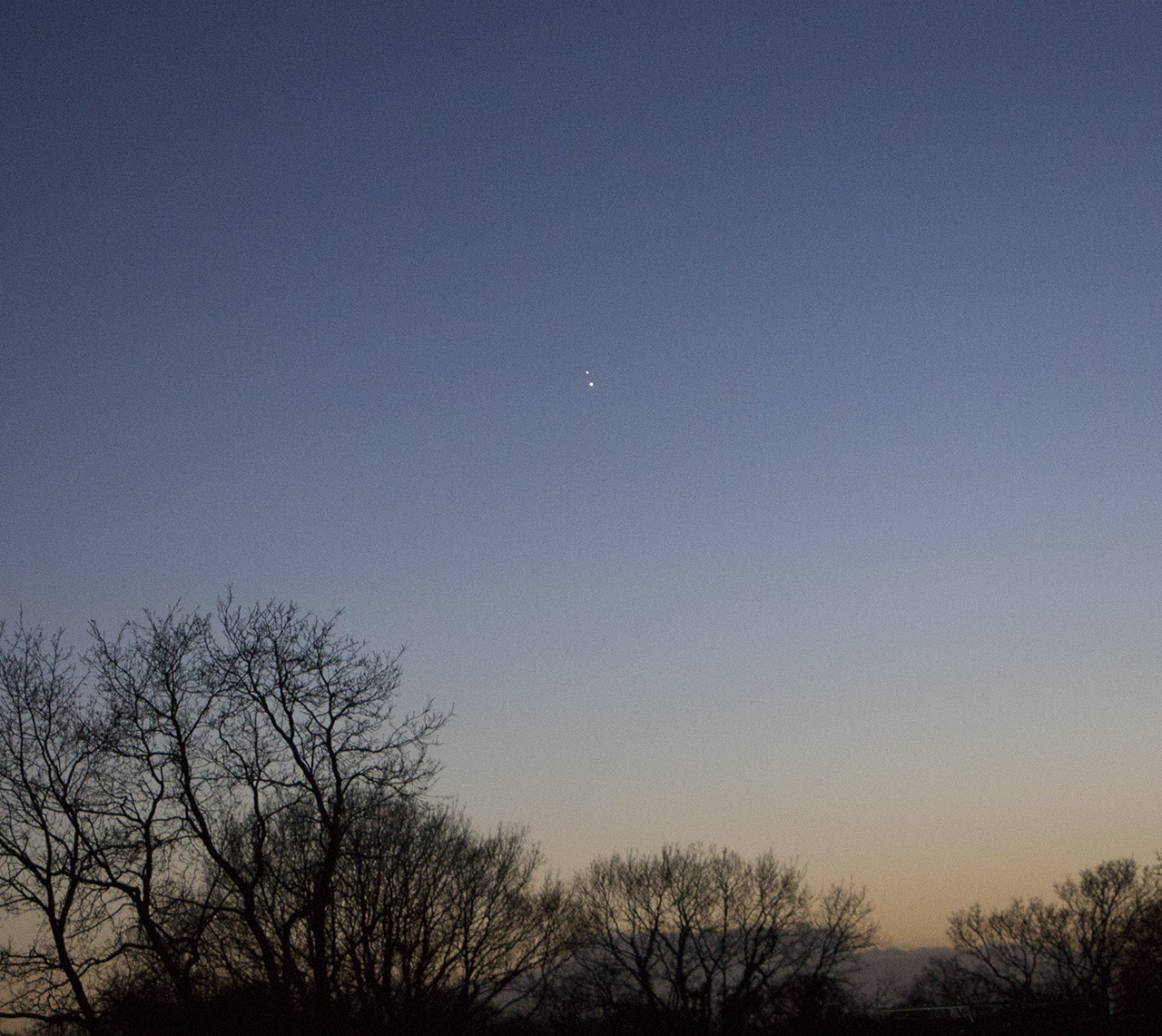 |
Conjunction Jupiter & Saturn
|
|
11th December 2020Planetary Nebula Abell 81 (IC1454) |
So many clouds passing over that I had to chose an object that would record in 5 minutes - hence this brightish but small planetary nebula abell 81. Abell 81 is the northernmost of the Abell planetary nebula located in Cepheus only 9.56 degrees from the pole. The central star is a problem. Although listed as mag 18.8 so not hopelessy faint, it is so blue it does not record in the OIII or Ha shots so a separate run with no filter was required to record it. During the last run on this object the seal on my main camera failed so it is away now for repair. So just the Tak and Canon for now.
|
|
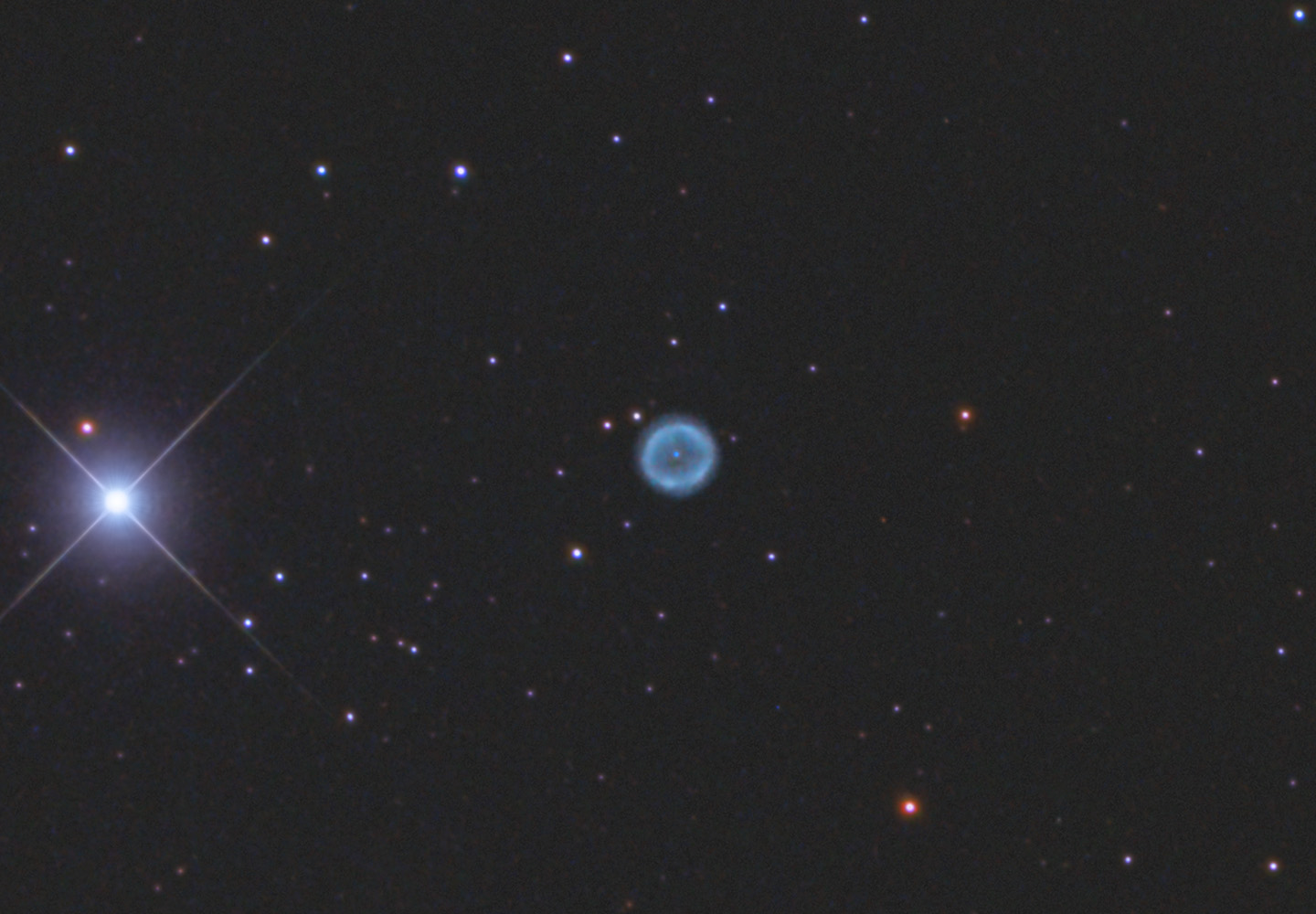 |
Abell 81
|
|
22nd November2020Planetary Nebula EGB1 (HaWe1) |
The terrible weather has contined and again getting enough images to do this faint nebula was a struggle. Could have done with more but that is always the case in Lancashire. This planetary nebula (PN) has a variety of names but EGB1 (Ellis-Grayson-Bond, 1984) seems the most common but it is also referred to as HDW1 and Hawe1 (Hartl and Weinberger). It is located in Cassiopeia. It does not have a significant OIII signal but clearly is a planetary nebula - that blue central star (see below) is a give away and its shape is typical of a PN moving through the interstellar medium. It is clearly moving south-south-east and leaving a stream behind it. Perhaps the most striking feature of this planetary nebula is the intense blue colour of its progenitor central star. This is the hottest hydrogen rich white dwarf star known at 147,000 degrees (Ref: Napiwotzki, 1999). It is around magnitude 16.4.
|
|
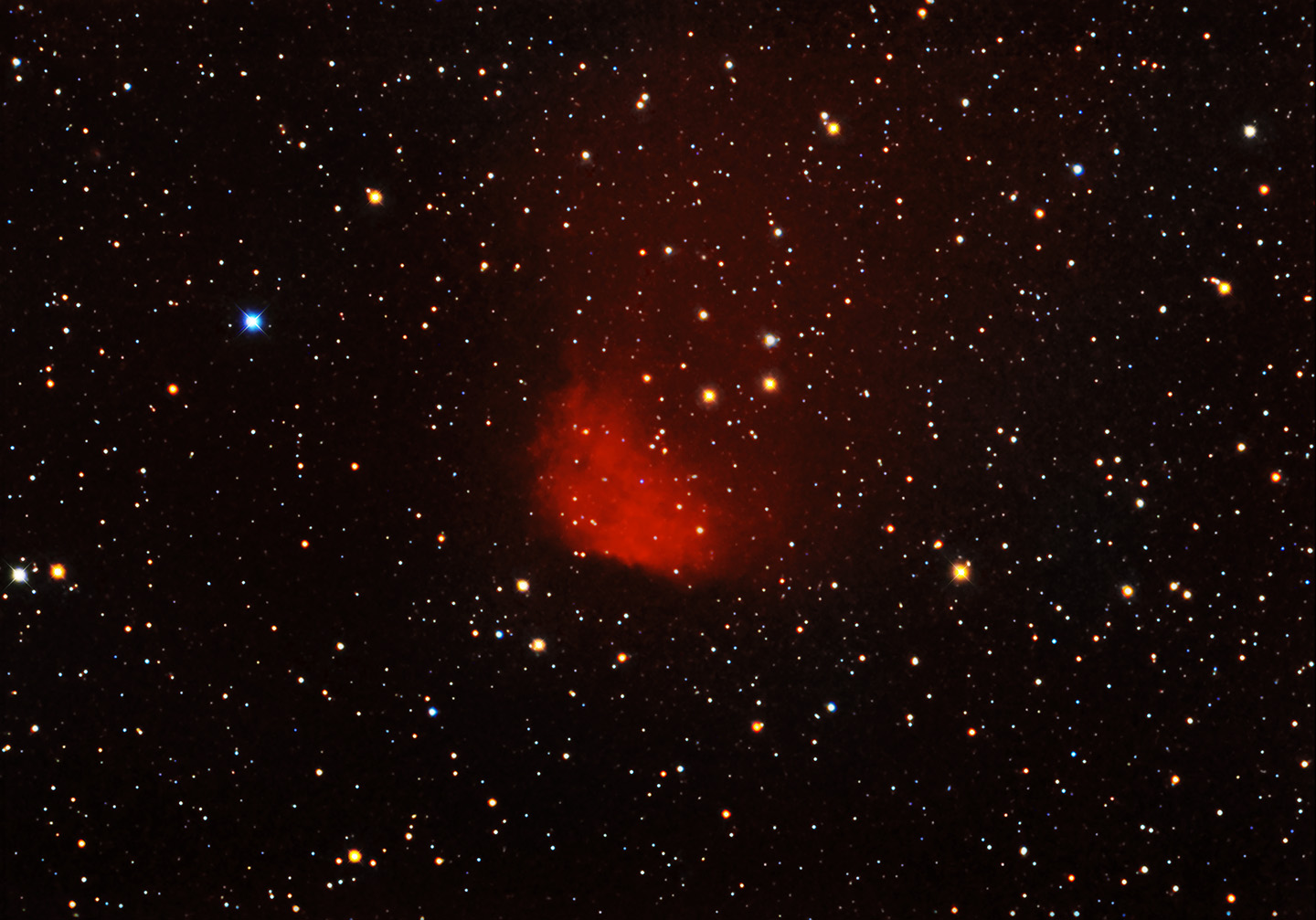 |
EGB1
|
|
1st November2020Wolf's Cave, VDB152 |
Gosh what a struggle October was - terrible weather even by Lancashire standards. This image took no less than 6 nights to get sufficient time between the clouds to do it justice. The brightest part, the blue reflection nebula, is Van den Bergh 152 (Cederblad 201). The dark nebula running to the north is Barnard 175, one of those famous Bok Globules. The bright star in the nebula is though to be passing through the Bok globule and lighting it up. Also visible are red filaments, perhaps the faint wisps of a supernova remnant's shock front. This is guesswork as I could find no reference to them. The whole complex is in the middle of Cepheus and is sometimes called Wolf's Cave.
|
|
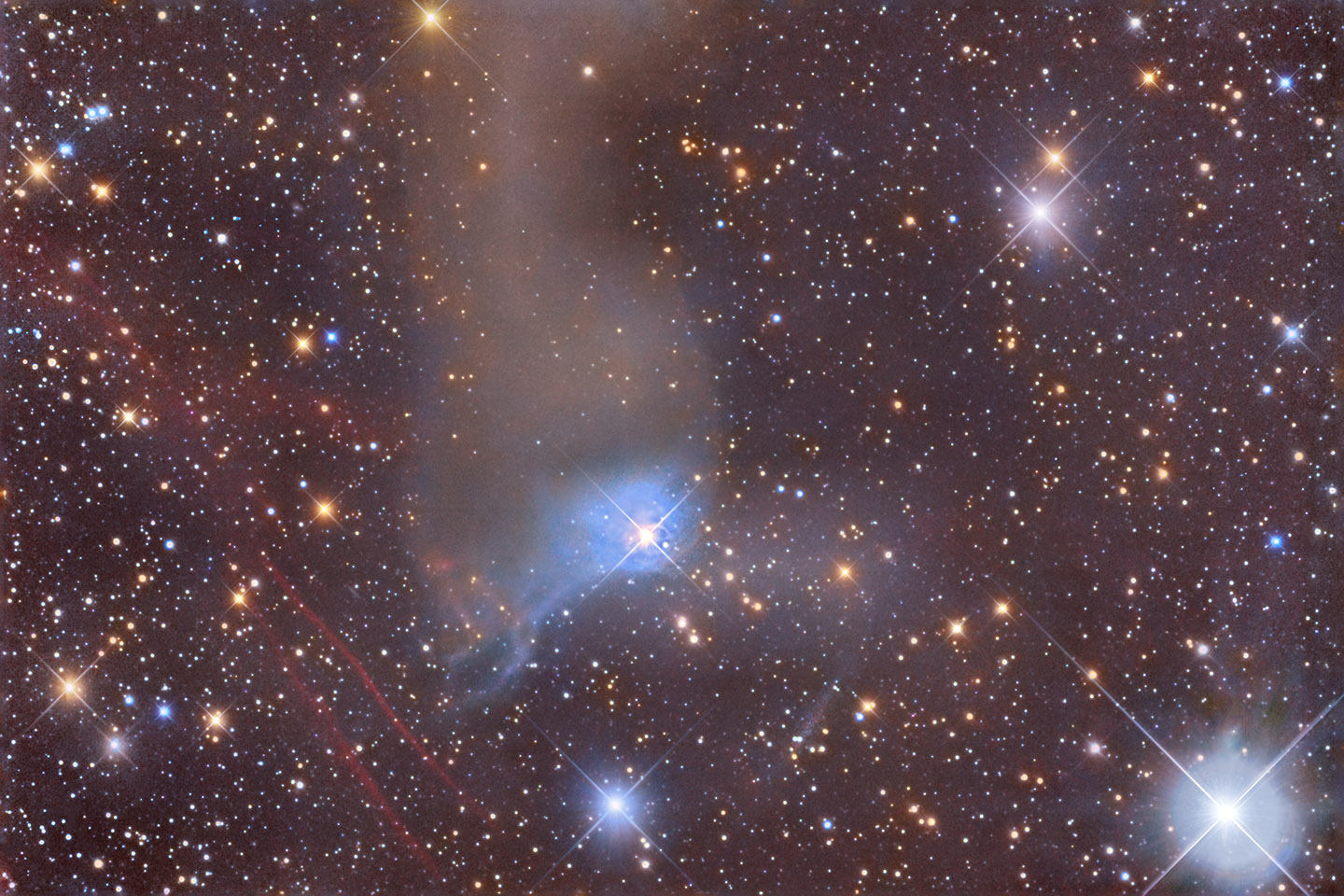 |
VDB152
|
|
8th October2020The Iris Nebula, NGC 7023 |
The NGC description for this object is "7th mag. star in extremely faint nebula, extremely large" so despite what Wiki states NGC 7023 is the central star (HD200775) and the nebula too. Also known as Caldwell 4 , the Iris is classed as a bright reflection nebula illuminated by HD200775, which is a Herbig Ae/Be star. The full spectrum of this star was determined by Sellgren et al. (1998) and the “e” in Ae/Be denotes that at least some of its hydrogen lines present are in emission rather than the more normal absorption. The ultra violet radiation from this star is thought to have photo-dissociated the molecular hydrogen of the nebula into atomic hydrogen - the star is not hot enough to form an H-II region. Initially however, outflow from the star (around 5,000 years ago) cleared a circum-stellar cocoon, which exposed the material to the UV radiation.
|
|
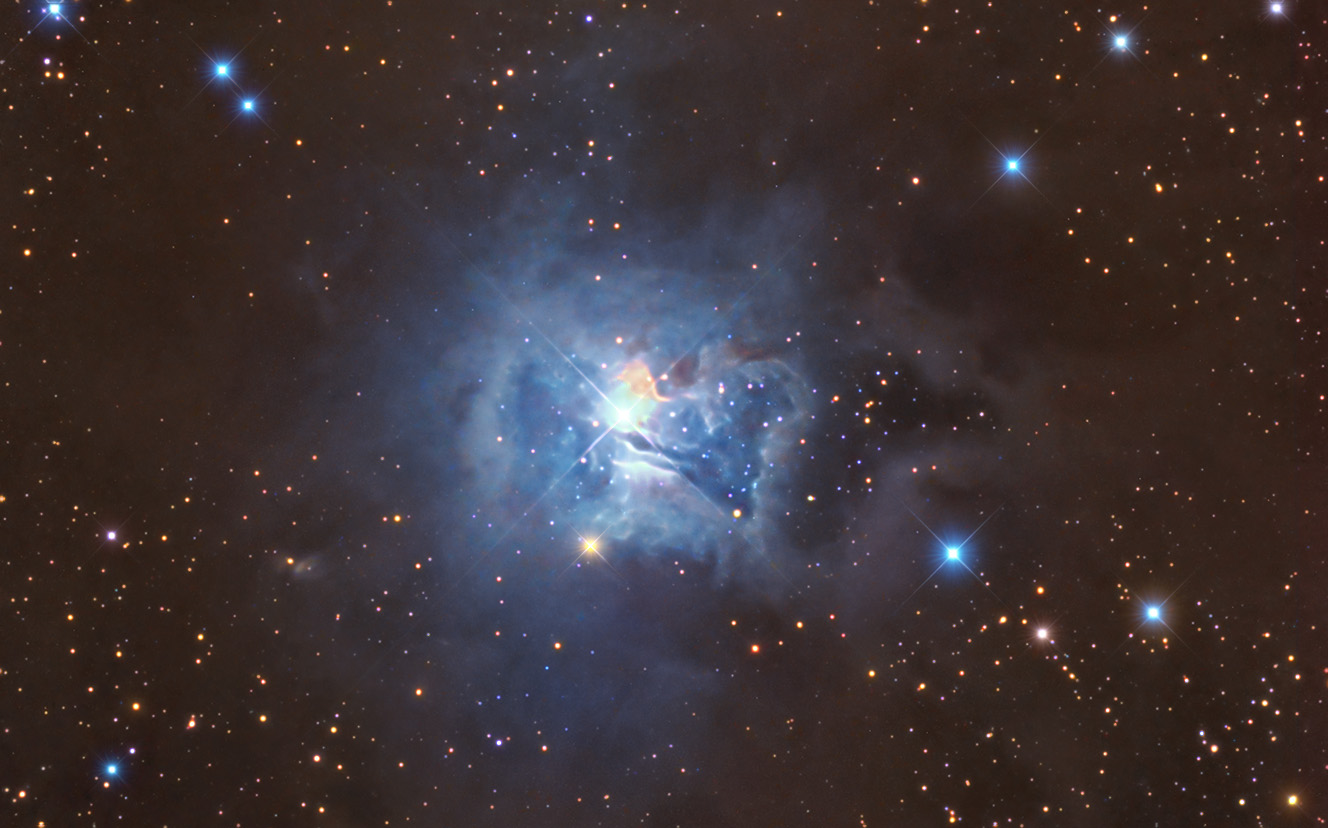 |
Iris Nebula
|
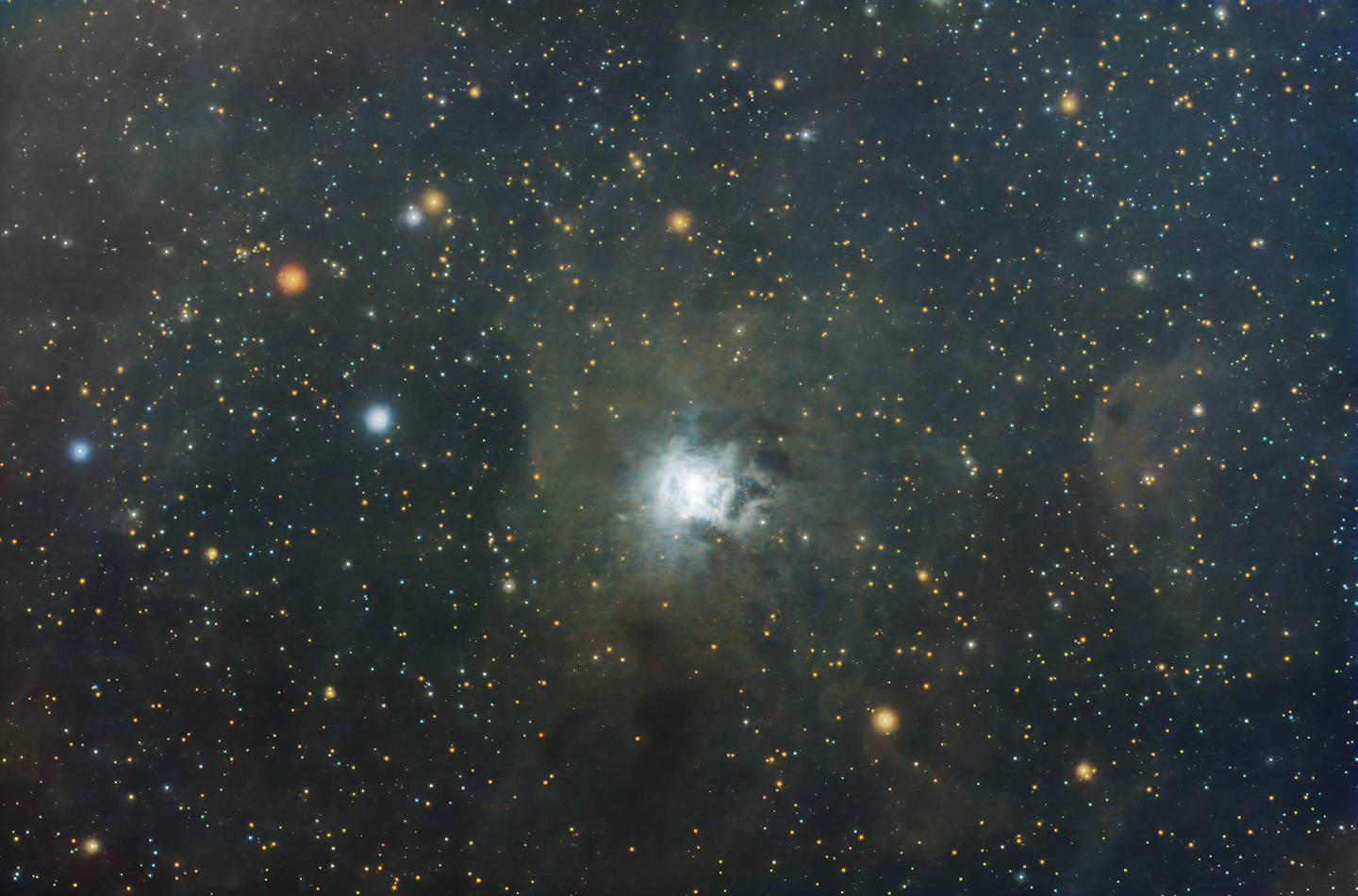 |
Iris Nebula - wide angle view
|
|
1st October2020Palomar Globular Cluster Pal 10 |
Imaging resumed after to summer shut down. Load of mistakes due to forgetting procedures but eventually go 2 hours worth of exposures. A Palomar Globular that looks like a globular cluster. Located close to the Coathanger asterism in Sagitta this is probably the easiest to image. It is not a remote cluster- in fact it is one of the closest but it is lost in the Milky Way and much obscured. It was discovered by American astronomer Albert George Wilson in 1955.
|
|
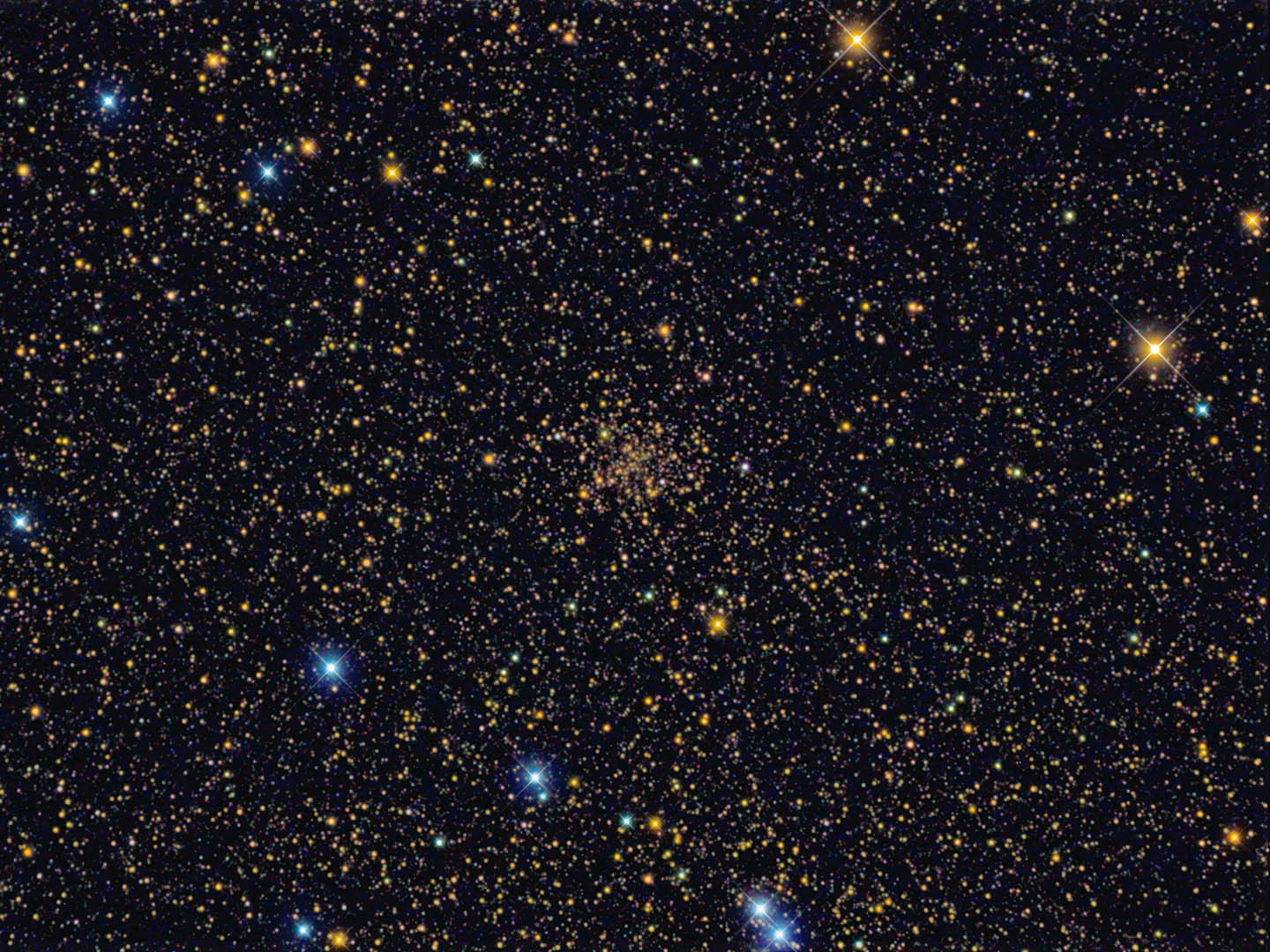 |
Pal 10
|
|
3rd September 2020Compact Galaxy Group Hickson 68 |
This Hickson group consists of 5 concordant galaxies with distance of around 120 light years. However, it would seem this group is a lot more complex with many many more members and not as compact as Hickson thought ref: MIDLIFE CRISES IN DWARF GALAXIES IN THE NGC 5353/4 GROUP R. Brent Tully and Neil Trentham 2008. Not the easiest of papers to read but it would appear that what look like faint backround galaxies are probably dwarf galaxies belonging to the group. The interacting galaxies are NGC 5353 and 5354 - the barred spiral is NGC5371.
|
|
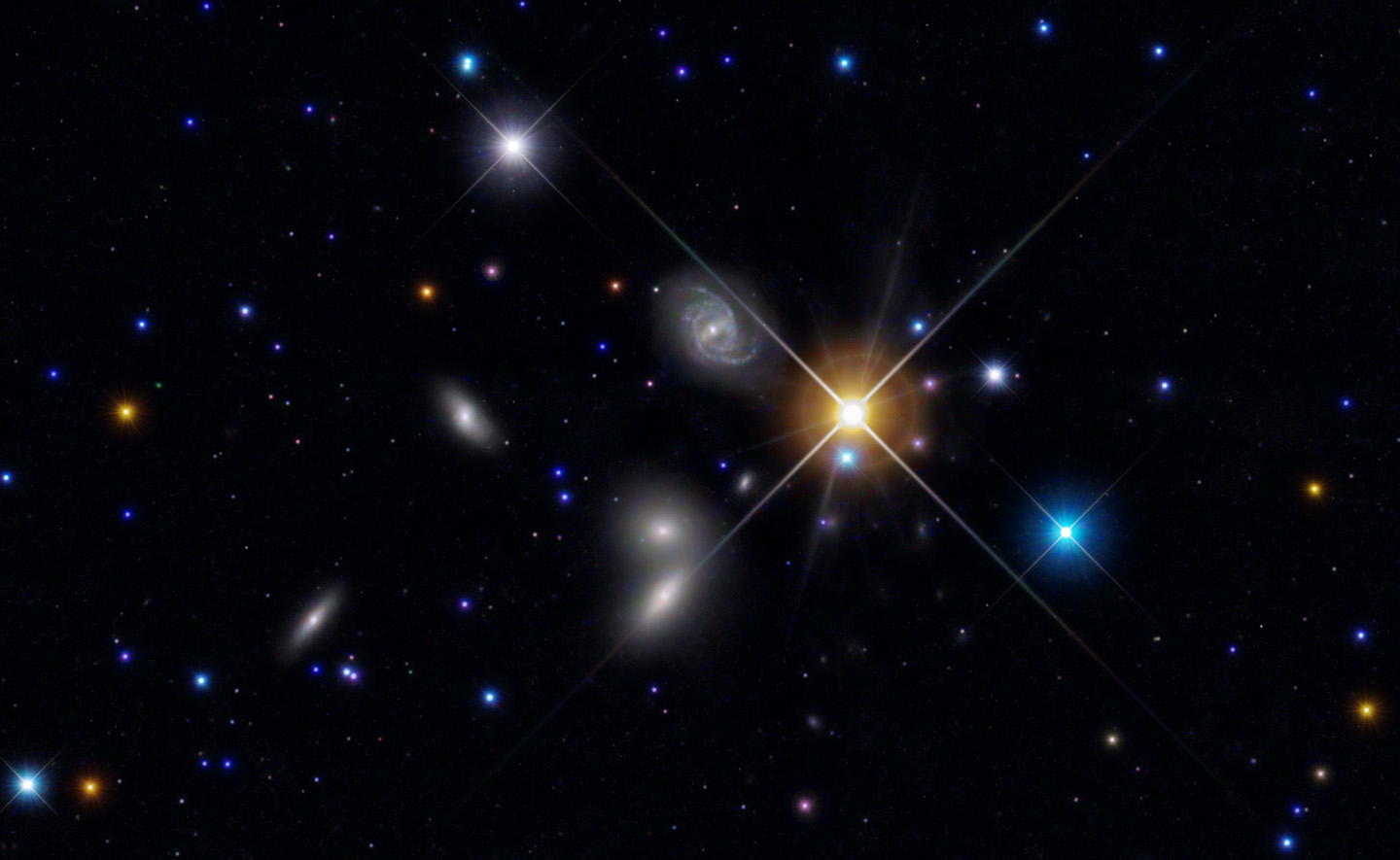 |
Hickson 68
|
|
??th July 2020The Cocoon Galaxy, NGC4490 & 4485 |
The closely interacting galaxies NGC 4485 and NGC 4490 are members of the NGC 4631 group of galaxies. NGC 4490 is a late-type spiral galaxy type SB(s)d with its companion NGC 4485 an irregular galaxy type IB(s)m. Their masses differ by factor of 4. When I was processing my image I noticed a faint feature to the east (left) of NGC4490. At first I was unsure as to whether it was real or as a result of light pollution. It turned out to be real and was discovered by Elmegreen et al in 1998. To quote from her paper "A faint feature on the southeast side of NGC 4490 has been revealed by our B- and I-band observations; arm-interarm contrasts show that it is tidal in origin. The luminosity of the tail implies a total mass of about 4 x10^7 M The average tail color is the same as the color of the outer disk of NGC 4490, which supports the conclusion that it is tidally sheared material." Figure 3 from the paper is shown right. Ref: OBSERVATIONS OF A TIDAL TAIL IN THE INTERACTING GALAXIES NGC 4485/4490, Elmegreen et al, 1998
|
|
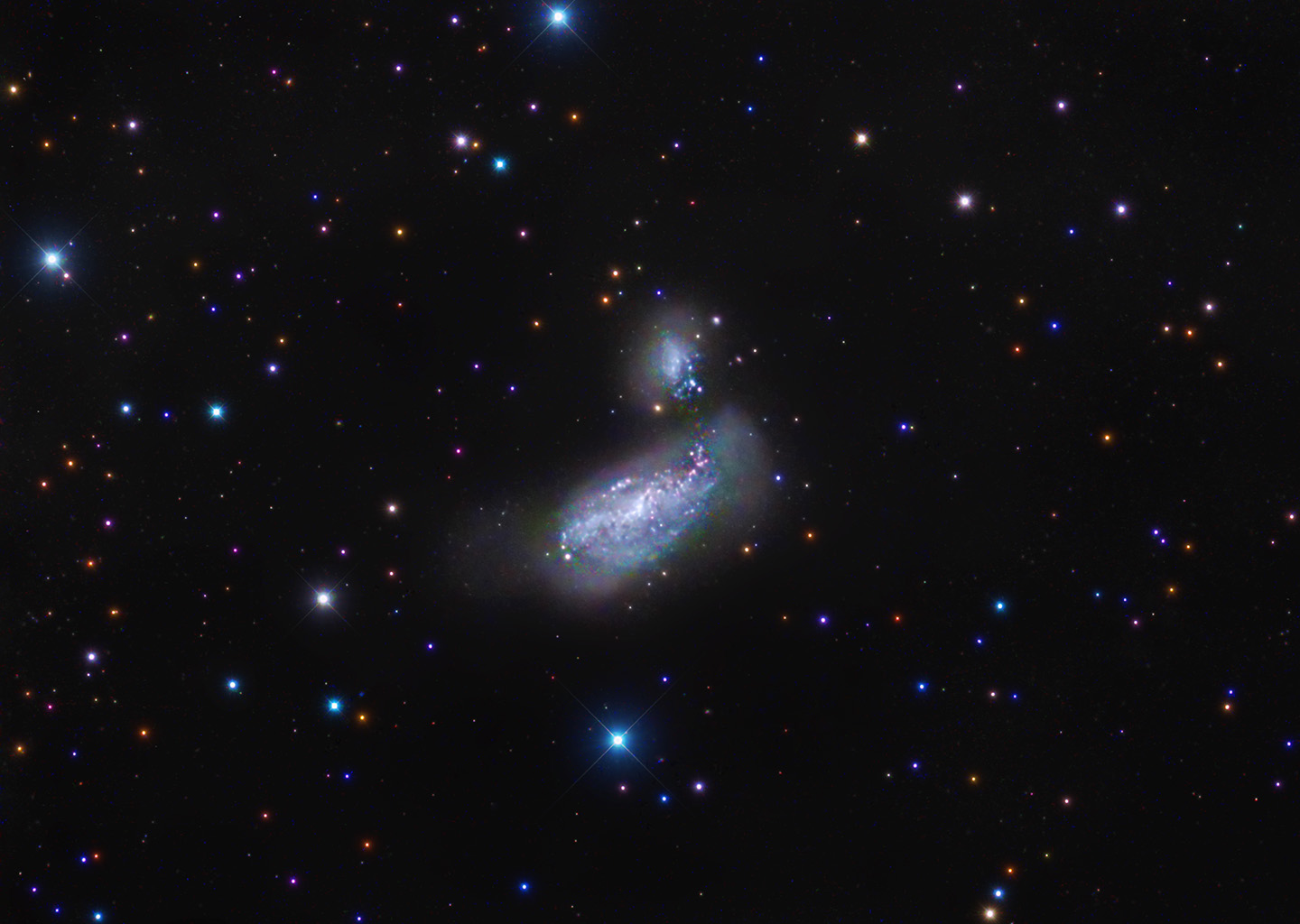 |
Cocoon Galaxy
|
|
20th July 2020Comet Neowise - 20th July 2020 |
Could only see this spectacular comet from my upstairs bedroom window as it was quite low in the NNW. The camera (undriven) was simply sat on the windowsill- I did open the window first. Because the sky is so bright at this time of year in northern England only 3-4 second exposures were possible. Nevertheless it was enough to record the comet and its tail.
|
|
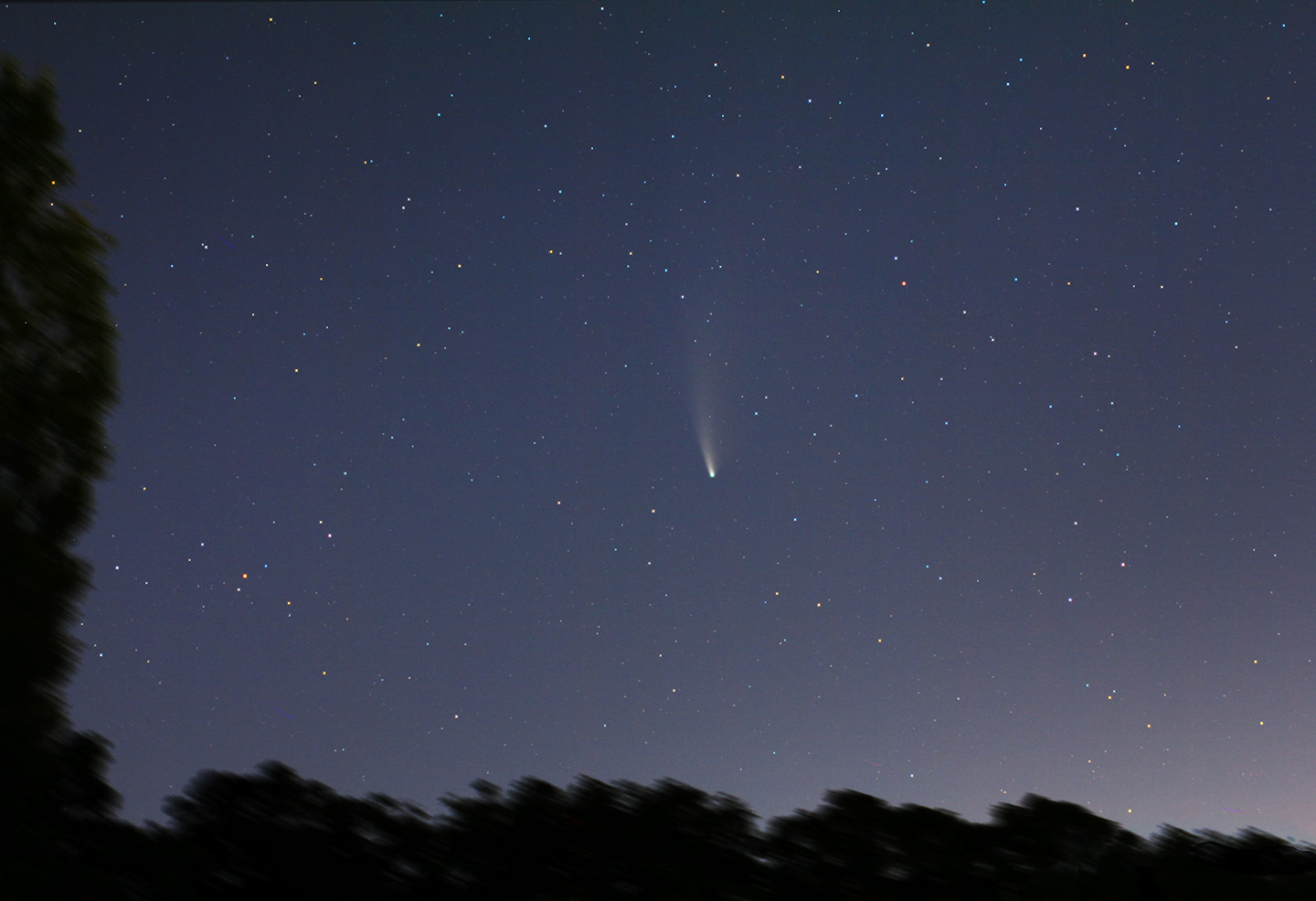 |
Comet Neowise
|
|
??th May 2020The Mice, Interacting Galaxies NGC 4676-1 & 4676-2 |
Believed to be similar to what will happen to us when the Andromeda Galaxy and the Milky Way collide. These two mighty galaxies have already had one pass through each other, which has produced the long streamers or tails - hence their common name. In the future hey will collide again before merging into a single galaxy. There are computer simulations of galaxy collisions that mimic accurately the shapes we see in reality. NGC 4676 lies about 300 million light-years away in the constellation Coma Berenices and the pair are likely members of the Coma Cluster of Galaxies.
|
|
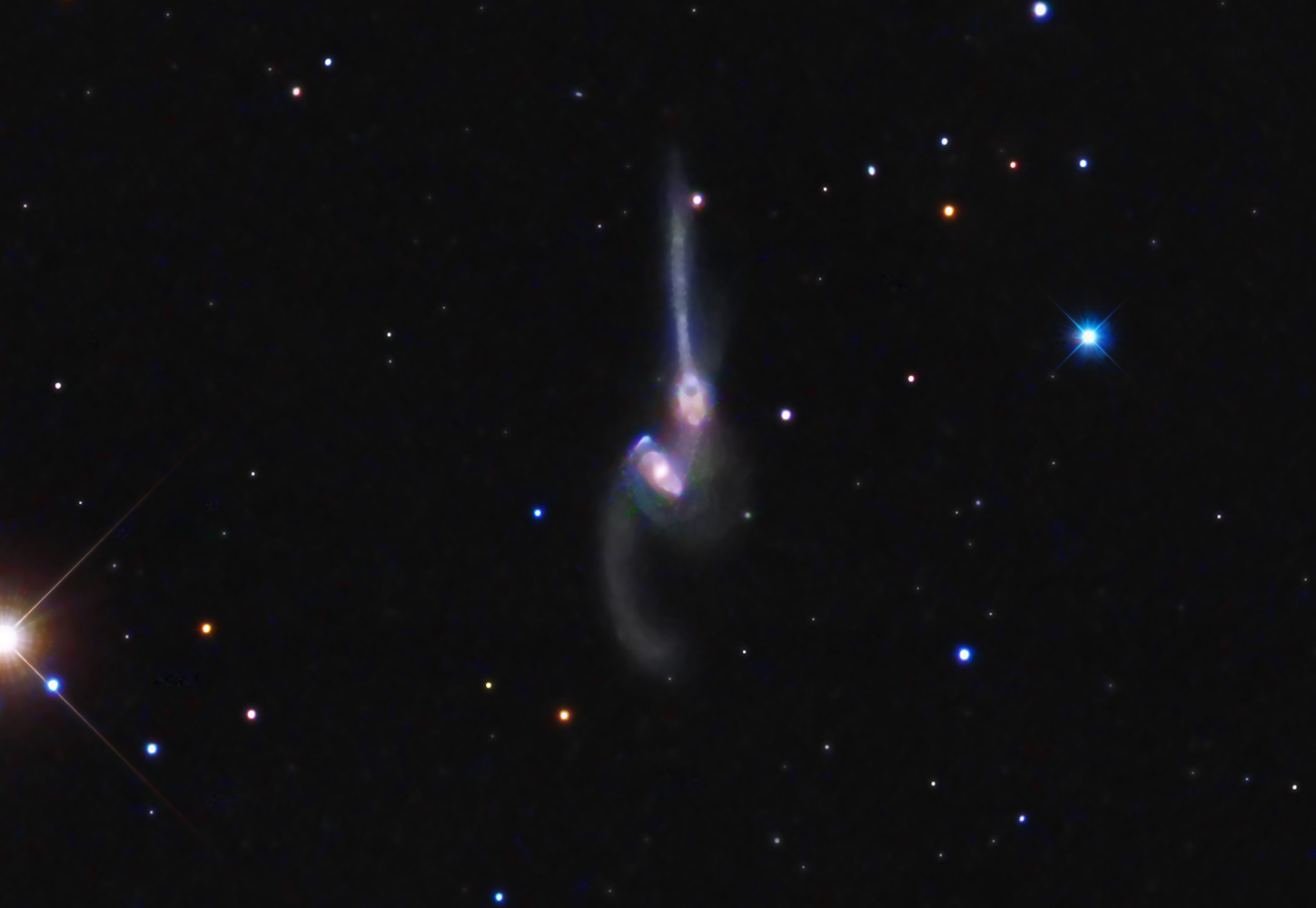 |
The Mice
|
|
5th July 2020Palomar 3 |
Not the most spectacular of globular clusters and although listed as 14.26 mag in reality it is much fainter as its brightest stars are only mag 18. It is one the most remote of the Milky Way globular clusters at over 300,000 light years and it is receding from us at 83.4 km per second - so getting more remote by the second! It has been discovered no less than 3 times! First by A.G. Wilson and W. Baade in 1952. It discovered for a second time by A.G. Wilson in 1955 and named by him the Sextans Globular Cluster. Finally and also in 1955, by G.O. Abell who was unsure as to what it was and classified it as a nearby dwarf galaxy, elliptical or spheroidal type, named the Sextans C system. We now know it is a globular cluster and was included as one of the 15 Palomar Globular Clusters. Palomar 3 is located only 4 degrees from the Sextans Dwarf galaxy, which was only discovered in 1990 - long after Pal 3. They are both at similar distances but probably not associated because of markedly different radial velocities.
|
|
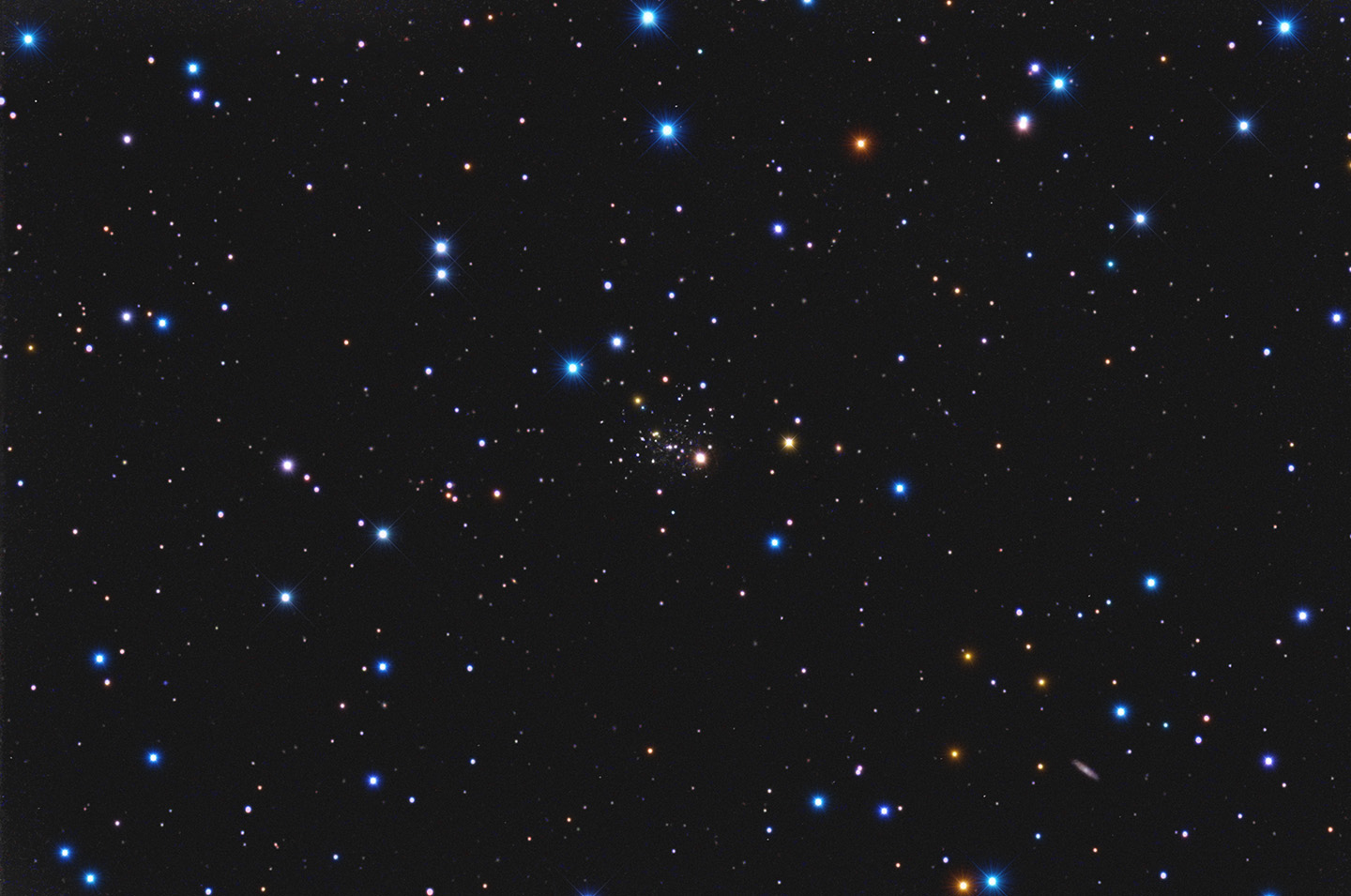 |
Pal 3
|
|
21st June 2020Spiral Galaxy, M106 |
M106 (NGC 4258) is one of the largest and brightest nearby galaxies very similar in actual size and luminosity to the Andromeda Galaxy. It was discovered by Pierre Méchain in 1781. M106 contains an active galactic nucleus (AGN) and these days is classified as a type 1.9 Seyfert. It is perhaps most famous for the presence of a water megamaser. Observiations of this enabled the mass of its central black hole to be calculated and also permitted its distance to be determined independently of other standard methods. It is 23 million light years distant. The galaxy to its right is NGC 4217, which is more than likely a companion M106 also has another hidden feature namely twin powerful jets in its central region- see right. Reference: Jet-related Excitation of the [C II] Emission in the Active Galaxy NGC 4258 with SOFIA P. N. Appleton et al. 2018.
|
Figure from Appleton et al., 2018 |
|
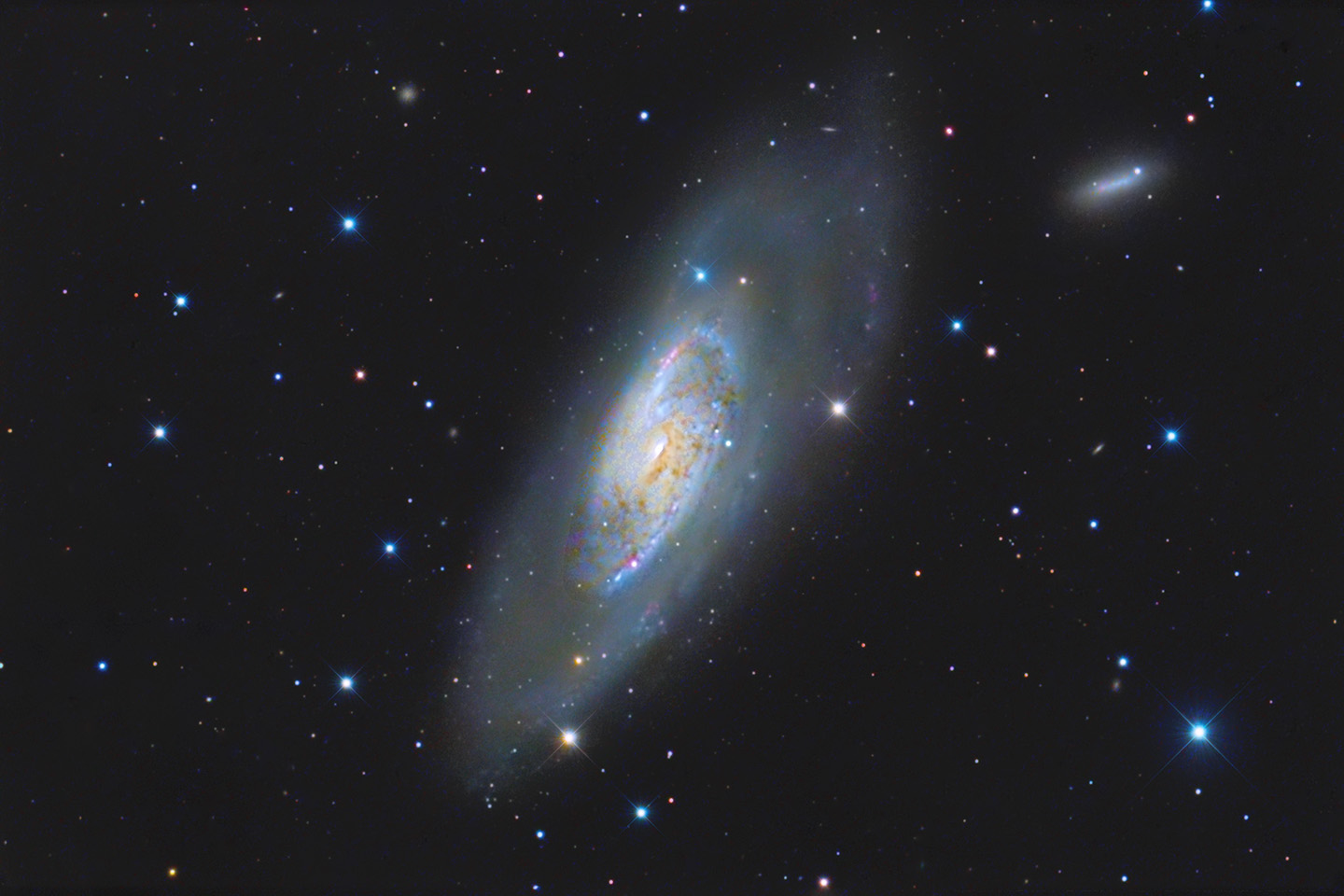 |
M106
|
|
1st June 2020The Whirlpool Galaxy |
I had shot the Whirlpool Galaxy in 2009 and 2011 but using light pollution filters so the colours were not quite right. It was time to try again but without filters. The resulting light pollution in the images was trickier to remove but the colours were much more realistic. This was the first spiral galaxy or rather spiral nebula to be observed. In 1845, William Parsons, 3rd Earl of Rosse, using the giant 72-inch (1.8 m) reflecting telescope at Birr Castle, Ireland, discovered the spiral structure. His famous drawing is right. He even recorded the second galaxy. Computer similations of the two galaxies interacting faithfully reproduces the complex streamers and tails visible in the image below. Today M51 is classed as a Seyfert Type II galaxy and is around 23 million light years distant.
|
|
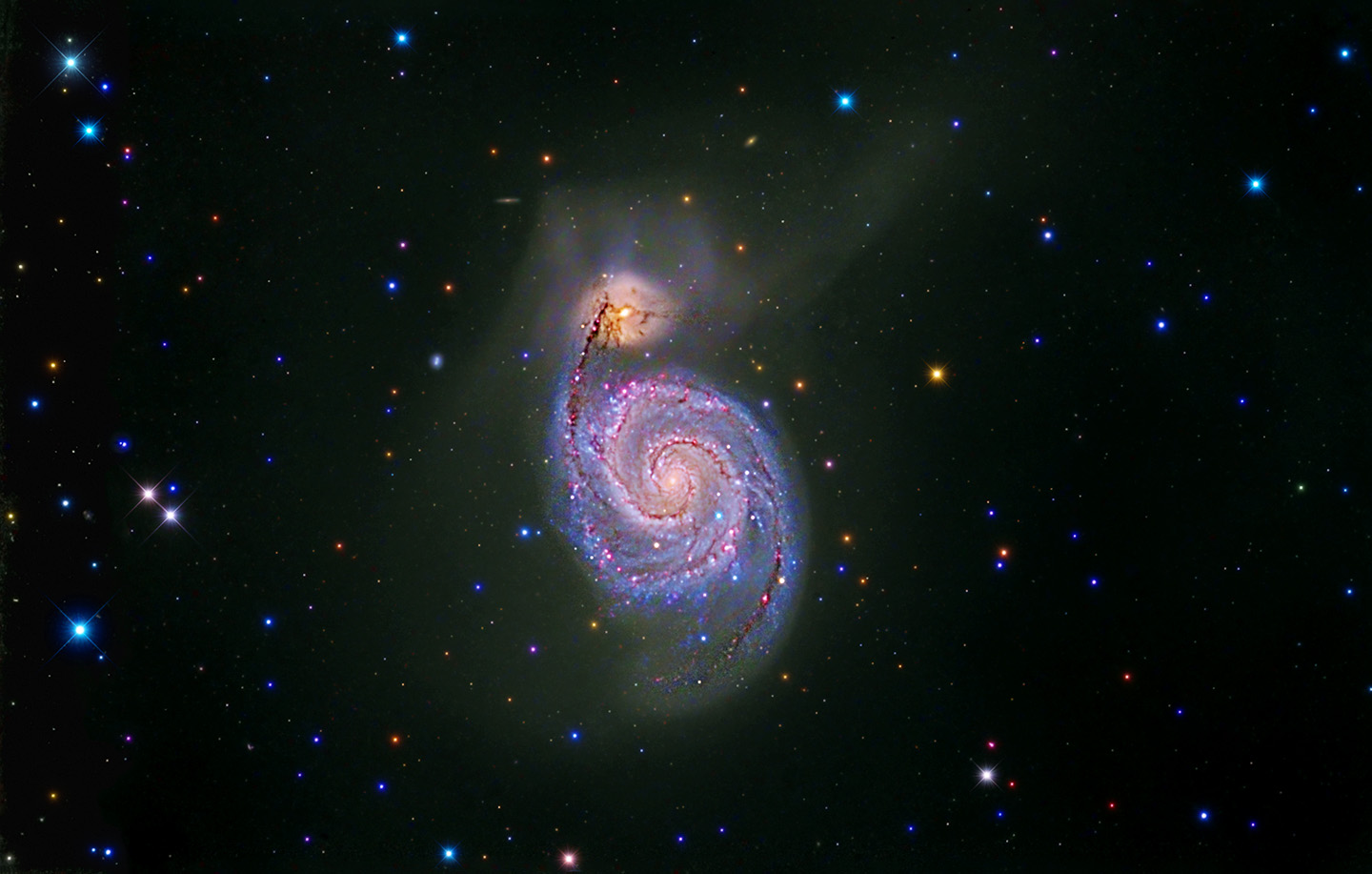 |
M 51
|
|
17th May 2020Barred Spiral Galaxy NGC 2903 |
A return to serious imaging! A barred spiral galaxy thought to be similar to our Milky Way but with one strange difference. It is still forming new globular clusters. The Milky Way's globular clusters, on the other hand, are some of the oldest objects in the galaxy. Located in the constellation Leo and NGC 2903 lies some 30 million light-years away. It was discovered by William Herschel on 16th November 1784. Image Details
|
|
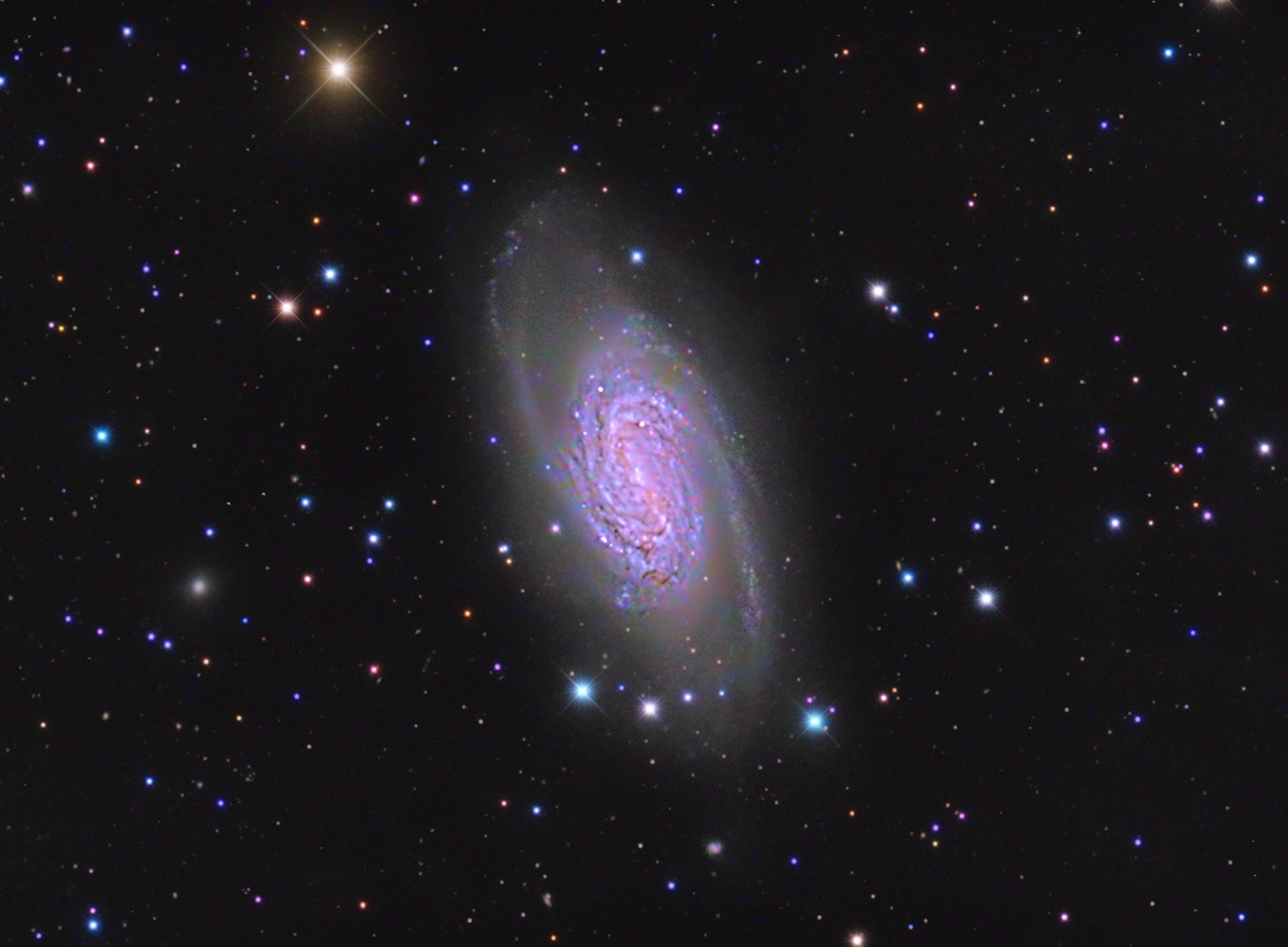 |
NGC 2903
|
|
7th May 2020Venus |
Venus has been a spectacular evening object this spring so decided it was about time to take an image - actually a webcam video. Elevation was around 20 degrees so used my Atmospheric Dispersion Corrector with the prism spacing set at 31.5mm. No colour correction was needed for this image. It really does work. Image Details
|
|
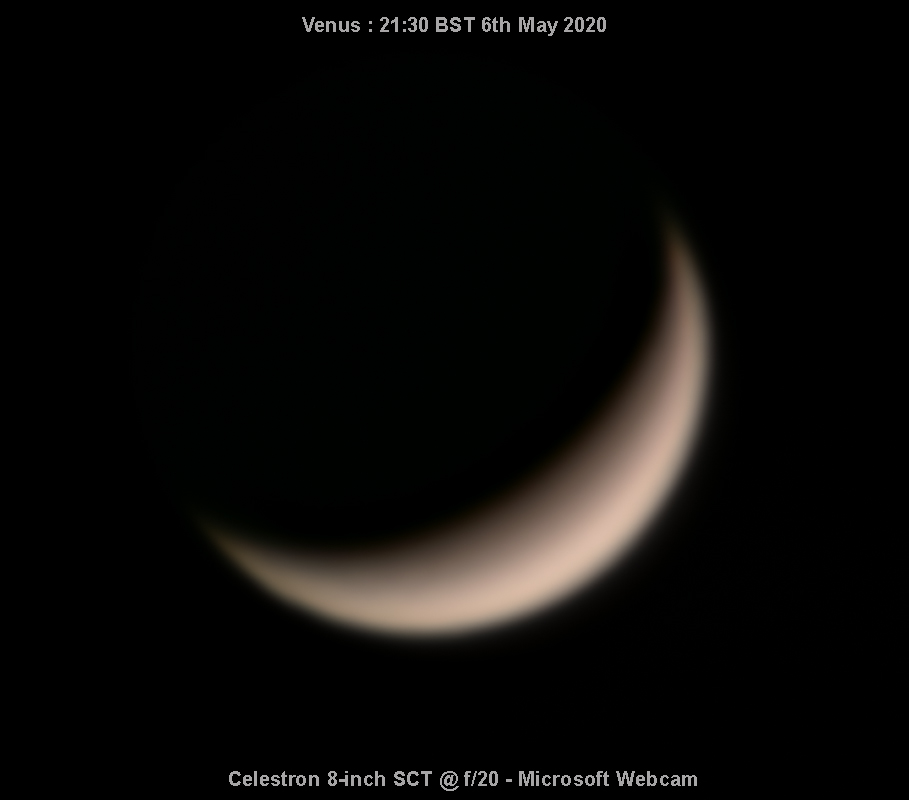 |
Venus
|
|
1st May 2020I see 37 or NGC2169 |
A shocking night with too many clouds so tried something bright. In 3 hours only managed to get 18 x 2-minute exposures - the rest were ruined by clouds. The famous asterism is sometimes referred to as IC37 meaning "I see 37". This asterism is a true open cluster and is located in Orion. It was possibly discovered by Hodierna but more certainly by William Herschel on 15th October 1784. Its distance is around 3600 light-years with a diameter of about 7 arc minutes and a total brightness of 5.9 magnitudes. The brightest of its about 30 stars is around magnitude 7, the hottest of spectral type B1, indicating an age of about 50 million years. Image Details
|
|
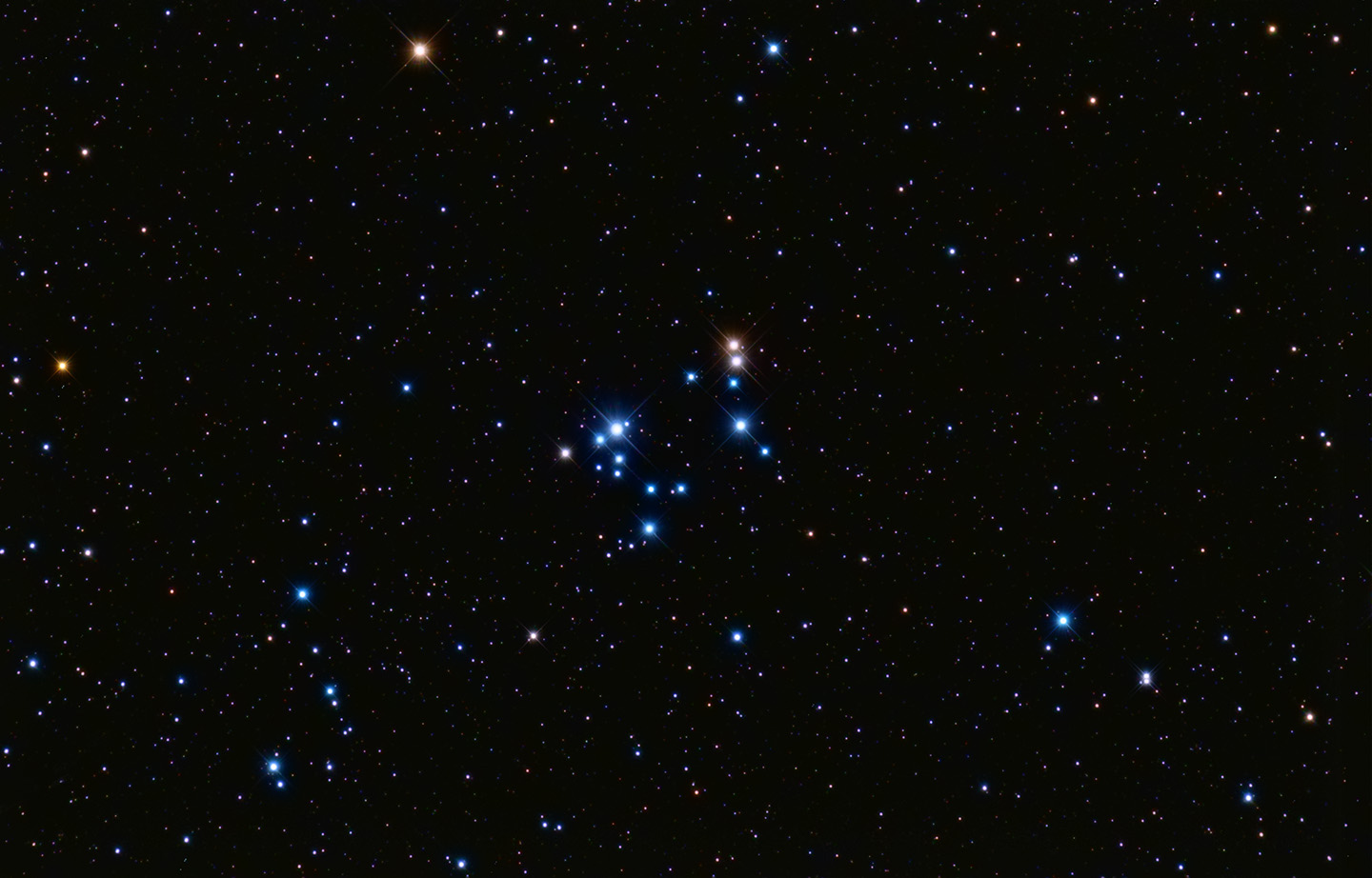 |
NGC 2169
|
|
19th April 2020Open Clusters M35 & NGC2158 |
I was getting desperate - so many cloudy nights that when a chance of few gaps came along I went for it. Lost a lot of expousres to the clouds but managed to get 11 that were OK. Just used the Tak, it wasn't worth setting up the RCOS on such an iffy night. Bright blue stars frequently distinguish younger open clusters. M35, on the upper left, is relatively nearby at 2800 light years distant, relatively young at 150 million years old (McNamara et al. 2011)with about 2500 stars covering a volume 30 light years across. The much older and more compact open cluster, NGC 2158, is at the lower right. The latter is four times more distant than M35, over 10 times older at 2 million years old (Carraro et al. 2002), and much more compact with many more stars in roughly the same volume of space. M35 is typically diffuse but NGC 2158 is very dense and was once believed to be a globular cluster.
Image Details
|
|
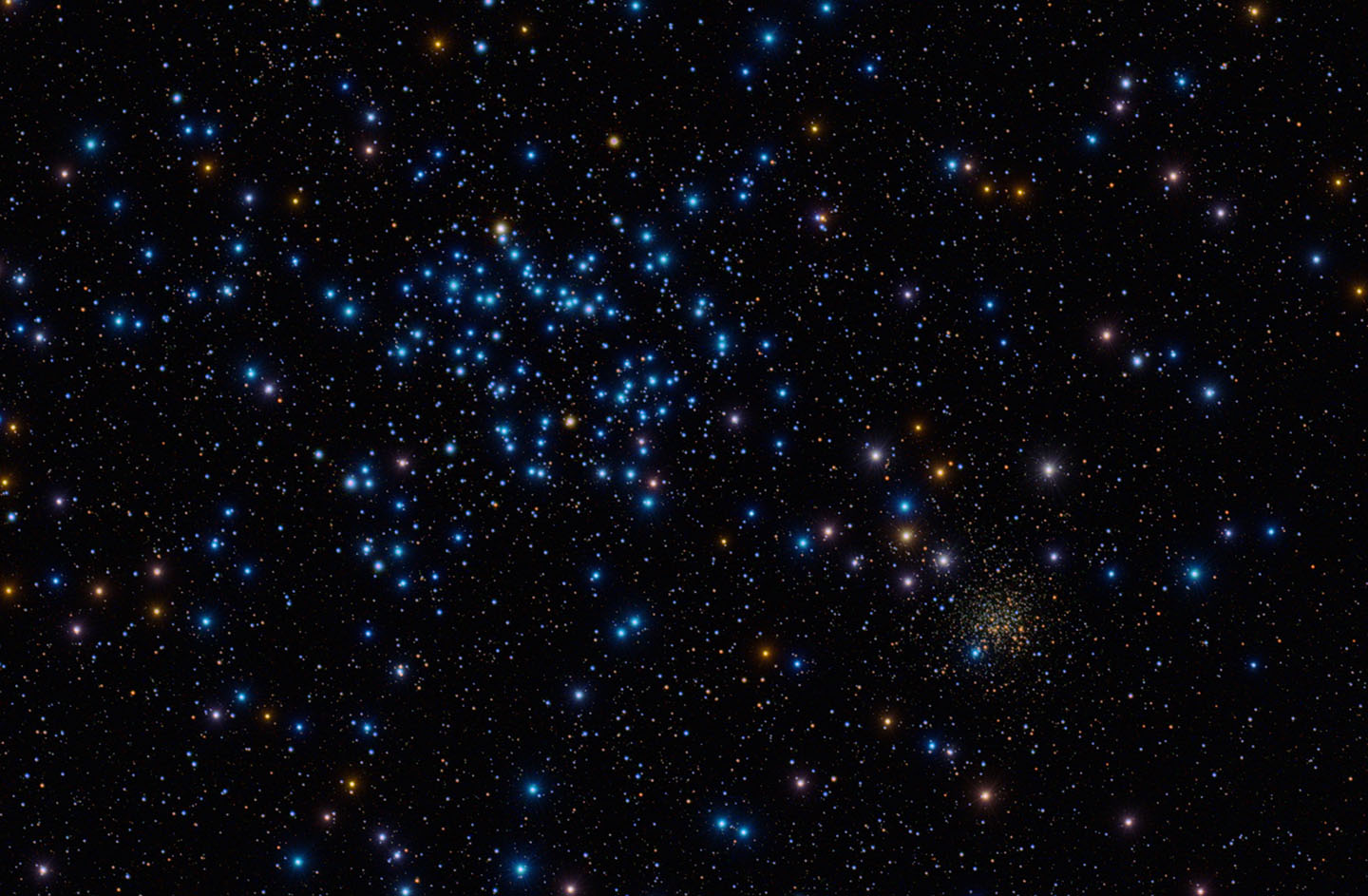 |
M35 and NGC 2158
|
|
5th April 2020Spiral Galaxy NGC 2403 |
My first image of 2020 after an 8 week cloud-out! Must be he worst winter for astronomy on record. I first saw this relatively bright galaxy with my homemade 6 inch Newtonian over 50 years ago ... but there was much less light pollution in those days. NGC 2403 is a SAB(s)cd LINER type spiral galaxy in the constellation Camelopardalis. It is an outlying member of the M81 Group and is round 8 million light-years distant. It is similar to M33, being about 50,000 light years in diameter and containing many star-forming H II regions. The H I Nearby Galaxy Survey (THINGS) produced rotation curves for several nearby galaxies including NGC 2403. Their rotation curve is shown right. It is typically "flat" i.e. it does not drop off with distance from the centre. This is taken to mean the presence of a dark matter halo. Reference: HIGH-RESOLUTION ROTATION CURVES AND GALAXY MASS MODELS FROM THINGS - W. J. G. de Blok, F. Walter, E. Brinks, C. Trachternac4, S-H. Oh, and R. C. Kennicutt Jr.. Published 2008). Image Details
|
R Rotation Curve for NGC 2403, ref: Blok et al., 2008. |
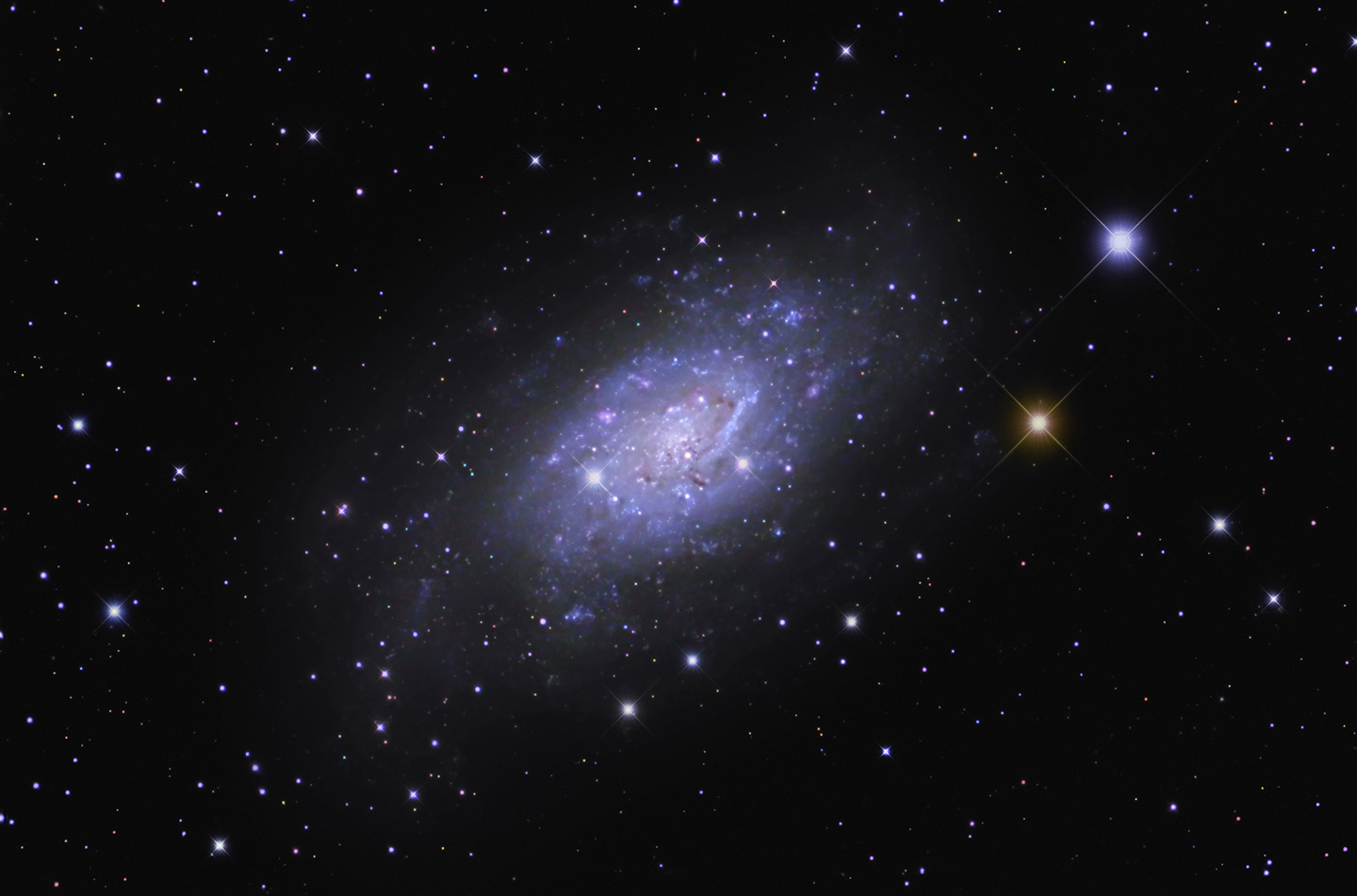 |
NGC 2403
|
|
27th March 2020Comet Atlas |
My first shot of this new comet. It wasn't supposed to be spectacular but brightened considerably approaching the Sun. Hopefully it could be even brighter in April/May perhaps easy in binoculars. It already had a reasonable tail when I imaged it. The image is centred on 21:00 GMT. Latest April News: the comet appears to be fading so perhaps will not become spectacular after all Image Details
|
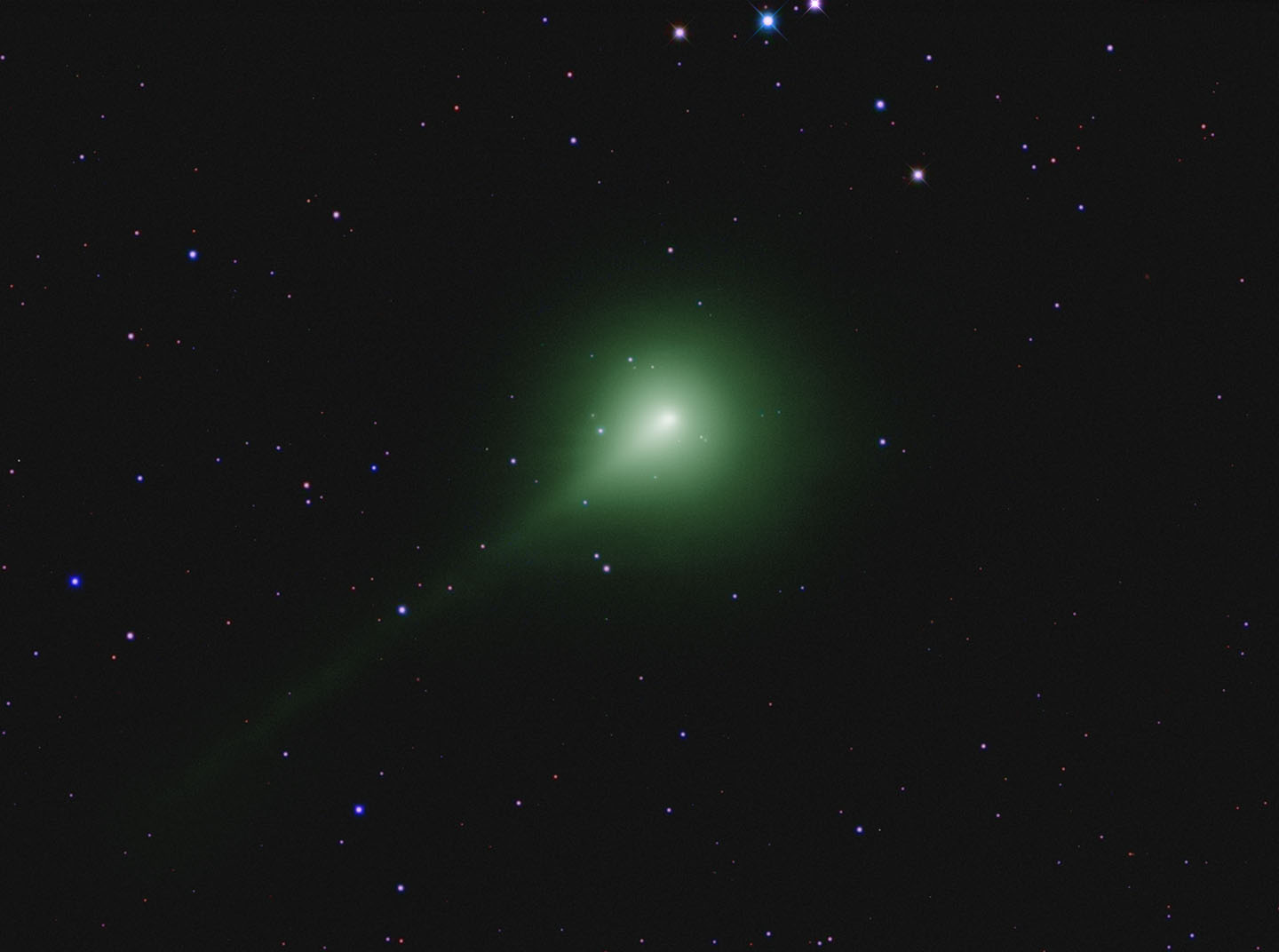 |
Comet Atlas -25th March 2020
|
|
1st March 2020Andromeda 1 |
You would have thought Andromeda I would be the Andromeda Galaxy (M31) but not so. It is the first of several dwarf (dSph) satellite galaxies of M31. Discovered in 1970 by Sidney van den Bergh with the Mount Palomar 48-inch Schmidt Telescope, which gives you some idea that it must be faint - and it is! A more recent study by Pritzl et al., "The Dwarf Spheroidal Companions to M31: Variable Stars in Andromeda I and Andromeda III",May 2005 measured variable stars in the galaxy - these were mighty faint at 24 and 25th magnitude. The used Hubble Space Telescope images for this. The distance to the galaxy is around 2.6 million light years (NED) and it lies to the south of M31. Image Details
|
 |
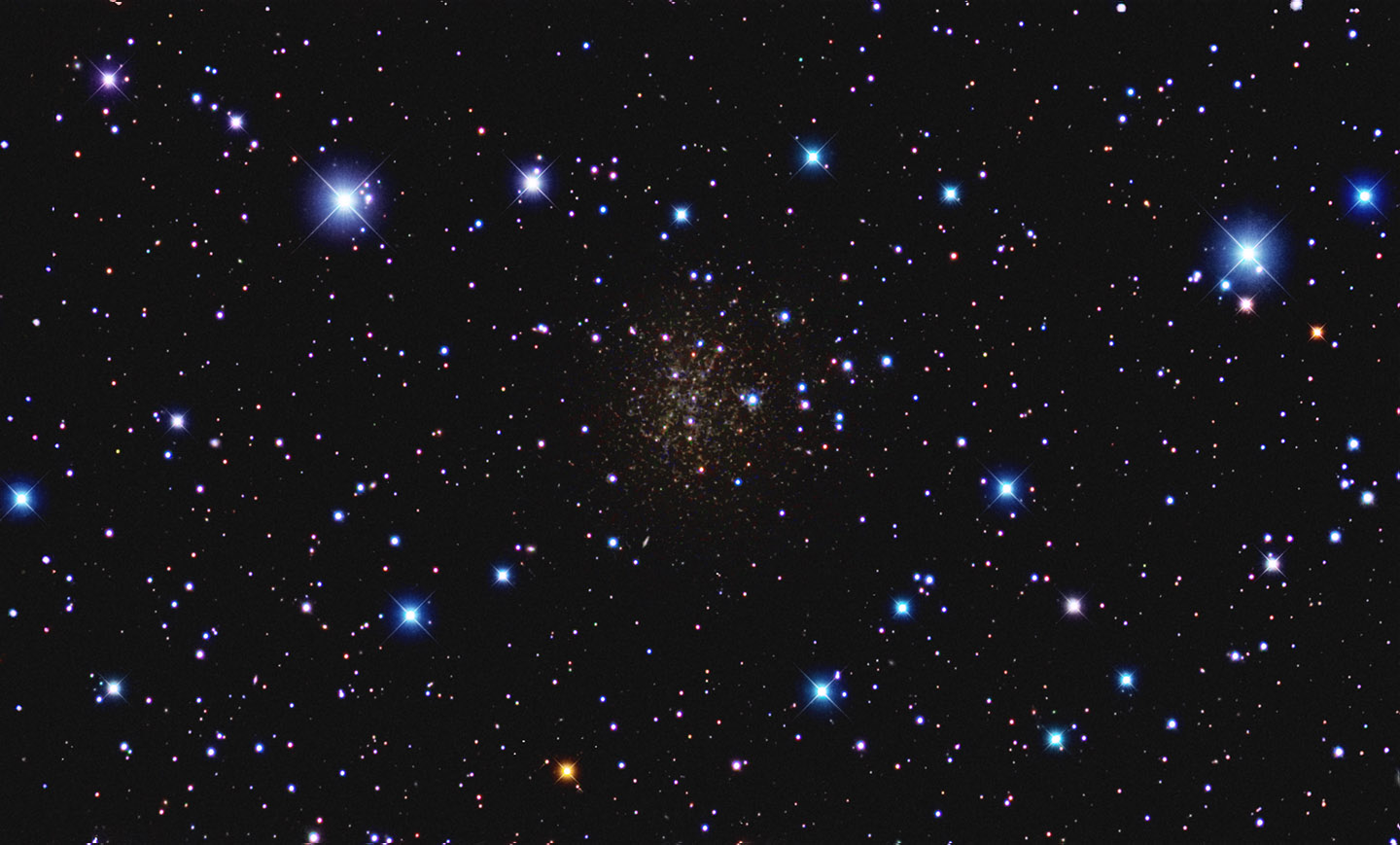 |
Andromeda 1
|
|
9th February 2020Caroline's Rose, NGC 7789 |
This must have been the worst winter ever in Lancashire for clear nights. It is 2 months now since a proper Moon-free clear night! One the best open clusters missed by Messier. It is faint but when you locate it is obvious. We had a splendid view of it this year at the Kelling Heath Starparty through the 8-inch Binocular Telescope. It is old, for an open cluster, at 1.6 billion years so its more massive stars have had time to age and become yellow/red giants. It was this what attracted me as shooting without yellow-blocking filters should reveal this cluster at its best. I wasn't disappointed. Located in Cassiopeia tis cluster was discovered by Caroline Herschel in 1783. Her brother William Herschel included it in his catalog as H VI.30. It is therefore one the few deep-space objects dicovered by a lady. It is around 8,000 light years away and thanks to Wu Zhen-Yu1, Du Cui-Hua, Ma Jun and Zhou Xu, we know its mass to be approximately 6600 times that of the Sun (ref: Mass of Open Cluster NGC 7789, 2009). Because of it size I had to use a two panel mosaic to fit it all in. Image Details
|
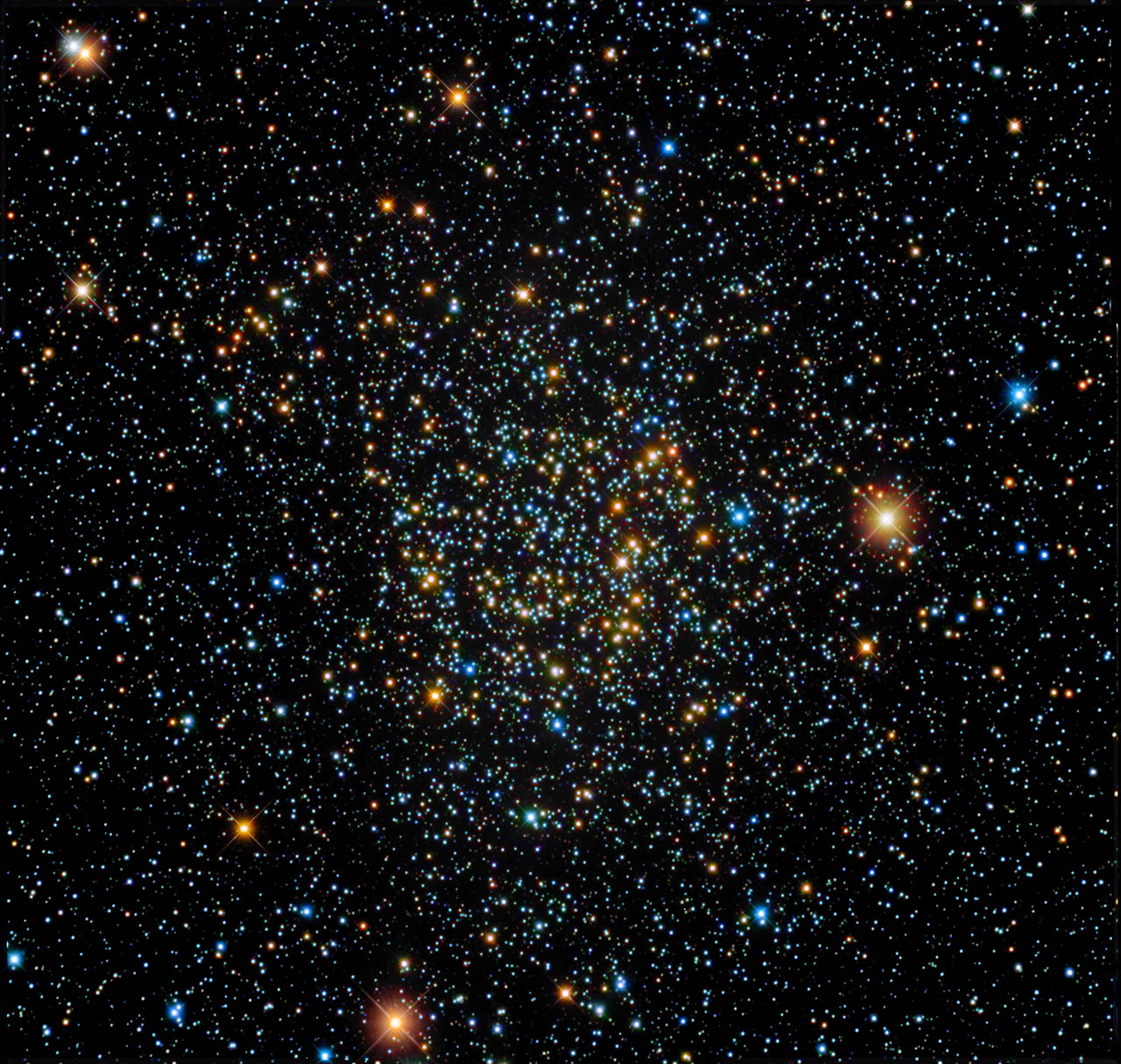
Caroline's Rose - close-up
Caroline's Rose - widefield |
|
12th January 2020Spiral Galaxy M74 |
This would be an even more severe test for imaging without a filter - M74 is notoriously faint and never rises that high over Lancashire. Because of it being of low surface brightness I upped the exposures. Yes there was more signal but the light pollution was horrendous making processing very tricky indeed. Sometimes referred to as the Phantom Galaxy as it is probably the most difficult Messier object for visual astronomers. I have failed to see it from Lancashire with my 12.5inch telescope. It is a classic spiral galaxy in the constellation Pisces and is at a distance of around 32 million light-years. It is the brightest member of the M74 Group of 5–7 galaxies that also includes the peculiar spiral galaxy NGC 660 and UGC1176 & 1171. The latter 2 were recorded with my widefield view with the Takahashi. Image Details
|
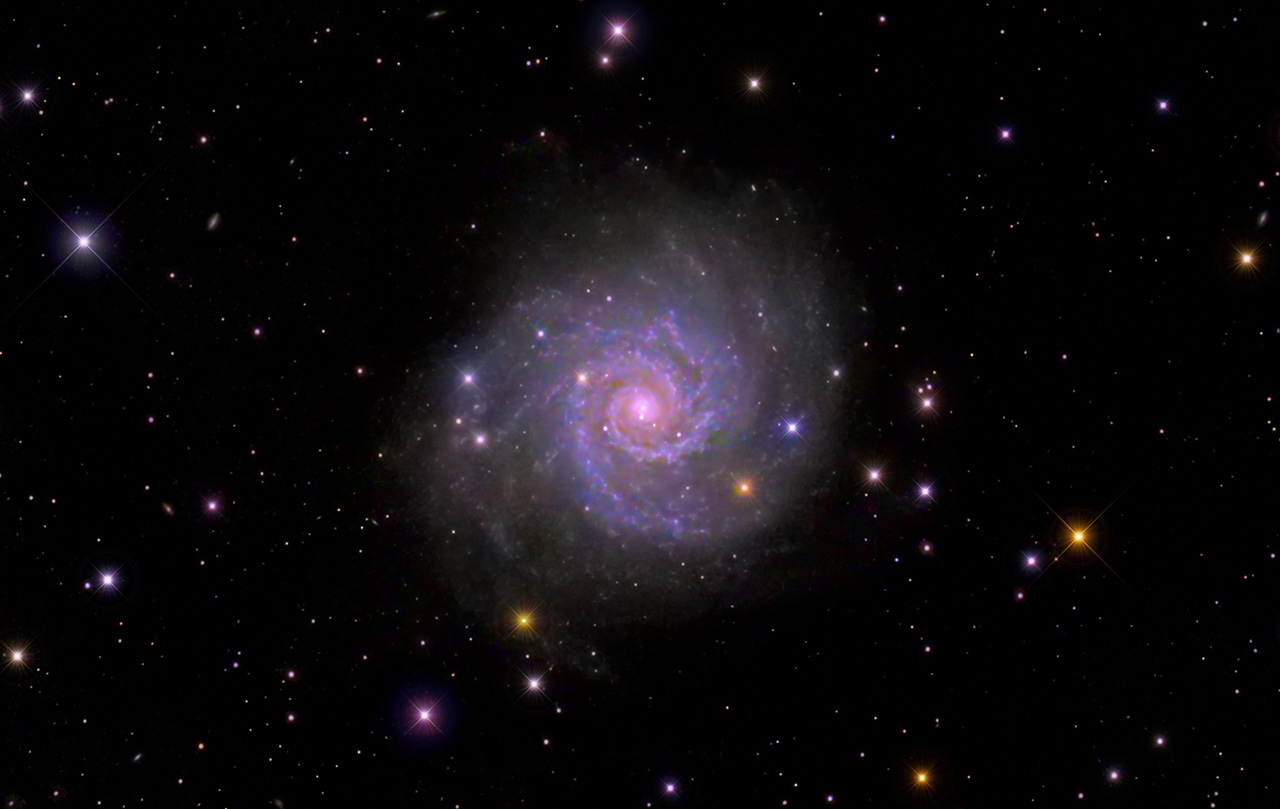 |
M74
|
|
16th December 2019The Deer Lick Group |
Having been pleased with my first test in imaging without a light pollution filter I thought I would give it a harder test. NGC 7331 is nearly twice as far away as NGC6946 and much lower in the sky so light pollution would be worse. Does the group look like the Deer Lick Mountains? I guess not. The explanation is they were observed from the dark skies of those mountains by Tom Lorenzin, author of 1000+ The Amateur Astronomer's Field Guide to Deep Sky Observing, and he gave them this name. They are not actually a true group. NGC 7331 at around 40 million light years is a foreground object with the other smaller galaxies much much further away at around 300 million light years. Image Details
|
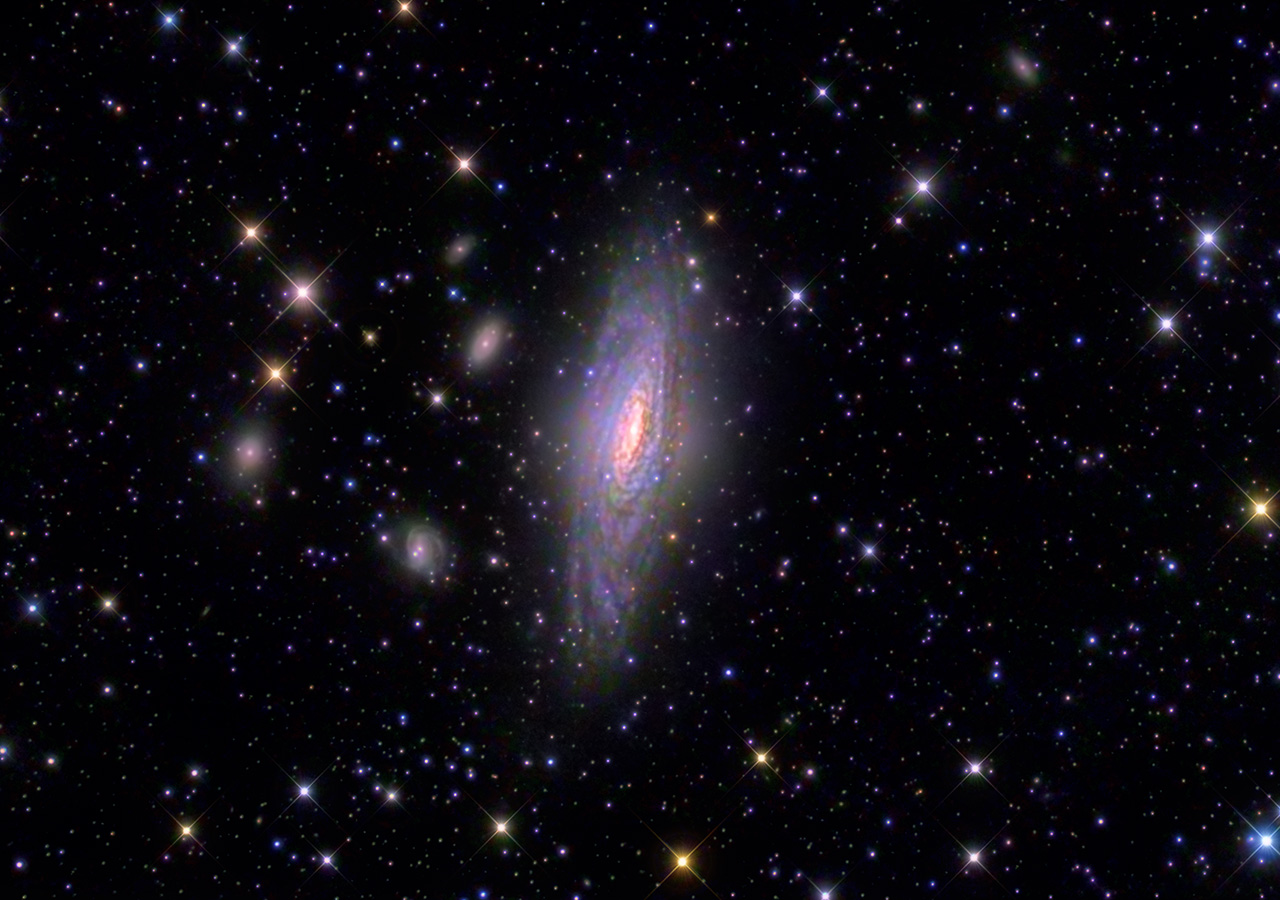 |
NGC 7331
|
|
3rd December 2019The Fireworks Galaxy (NGC 6946) |
After over 30 years of shooting with light pollution filters I decided to give a go without. With many street lights now converted to LED bulbs there is no longer much benefit in shooting with a filter that predominantly blocks yellow light (of sodium lamps). The light pollution will still be there but it is now spread across the spectrum. For my first test I chose an object near the zenith. Named the Fireworks Galaxy because of the number of supernova it has produced in the last 100 years - namely 10. One every ten years might not sound a lot but actually that is exceptional. It is classed as a starburst galaxy so it is perhaps not surprising it produces so many supernova. About 25 million light years distant so relatively close to us but beyond our local group.
Image Details
|
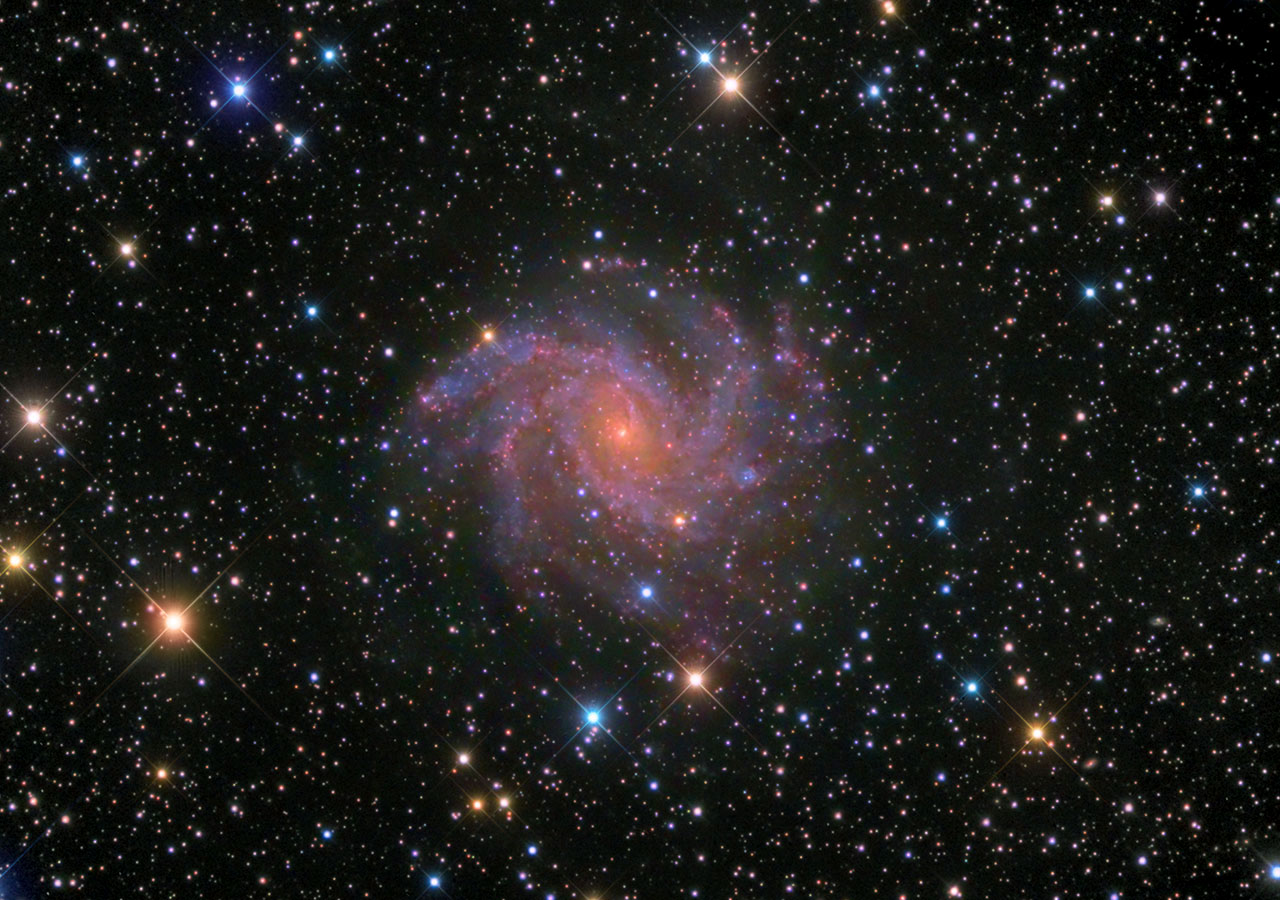 |
NGC 6946
|
|
17th November 2019The Blinking Nebula, NGC 6826 |
Although well placed in Cygnus this planetary is often overlooked for more famous Messier ones nearby. Its distictive green colour makes it ideal for viewing with the rods in our eyes. As these predominate away from the centre of our vision then the nebula appears brighter with averted vision. This is of course why it seems to blink - look direct and it goes fainter, look away and it gets brighter. There is a superb Hubble image of this object featuring "fliers". Image Details
|
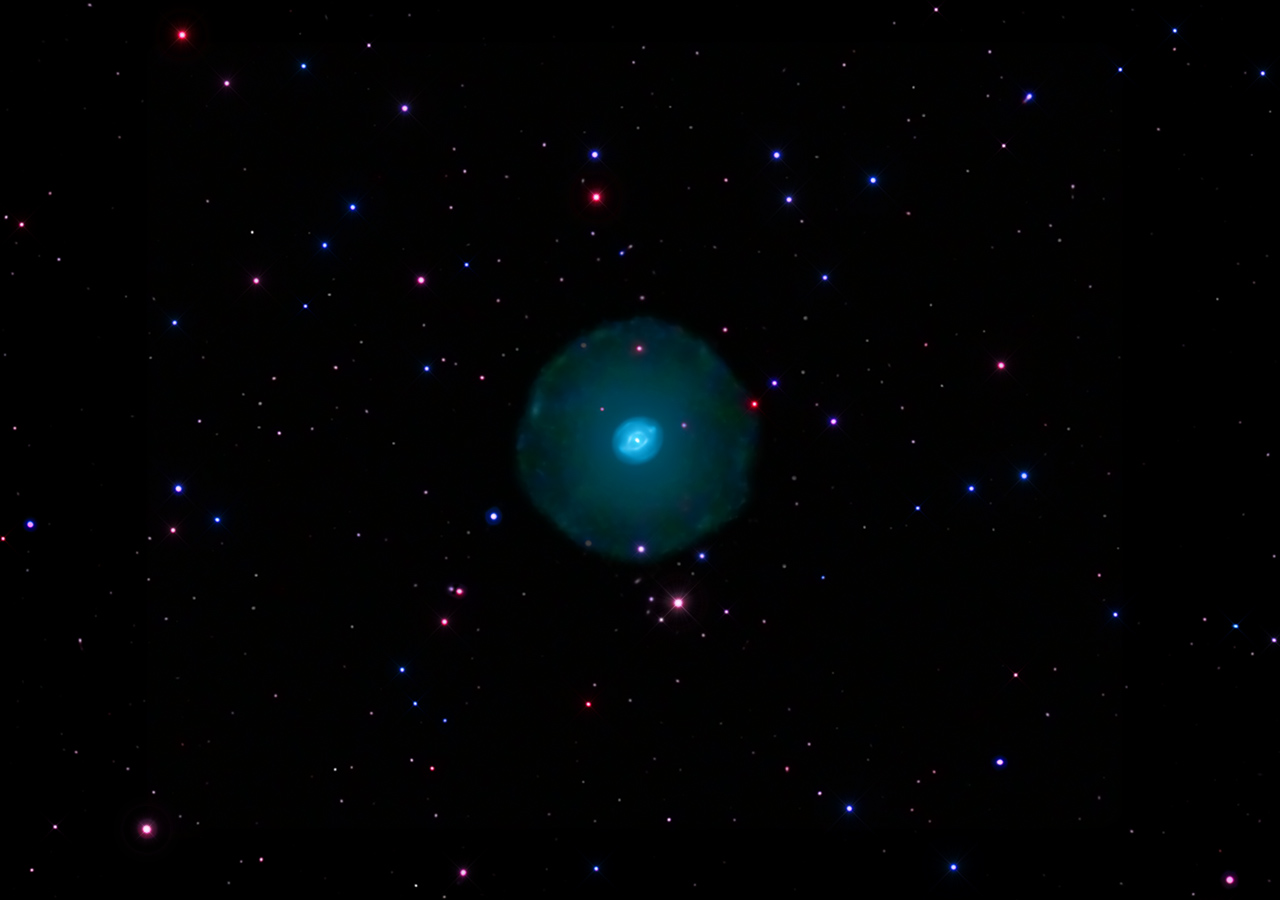 |
NGC 6826
|
|
3rd November 2019Spiral Galaxy, NGC 5248 |
The constellation of Bootes is not noted for deep sky objects (it does have a few pretty double stars) but there is one object worth searching out, the spiral galaxy NGC5248. It is bright (magnitude 10.3 and relatively large (7 x 5 arc-minutes). Its central core stands out and is even visible in good finderscopes. It is generally classesd as a Sc or but more recently as a SABbc type. Recent rotational velocity studies reveal 2 circum-nuclear star forming rings. There is a Hubble Space Telescope image available but it doesn't cover the whole galaxy. Image Details
|
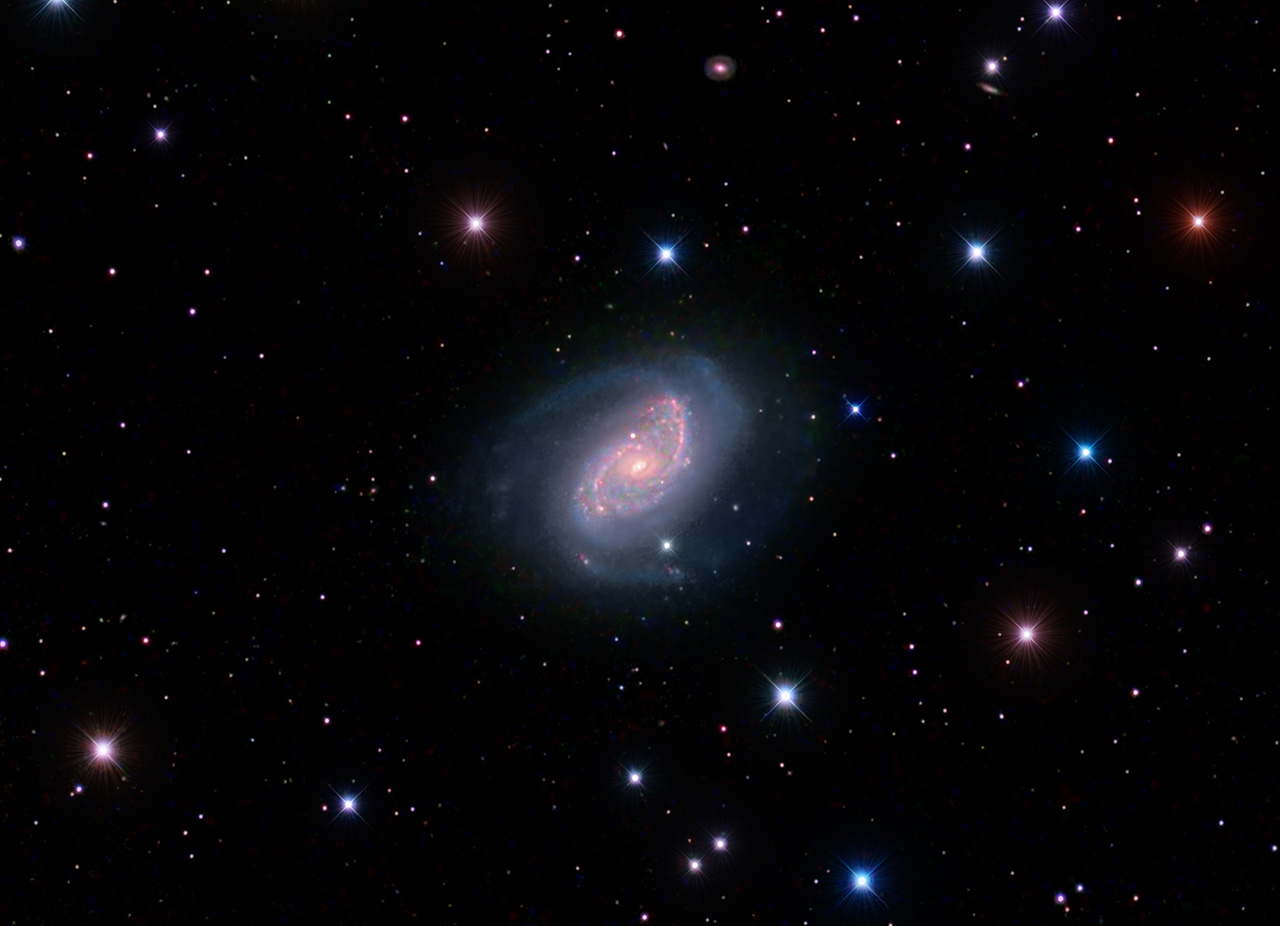 |
NGC 5248
|
|
27th October 2019Elliptical Galaxy, NGC 4697 |
A classical E6 elliptical galaxy but it does have a weak disc within it, inclined at an angle of 10 degrees to our line of sight which is just about visible in my image. It is the centre of its own group of galaxies and is one of the many Virgo II Sub-groups, which form a southern extension of the Virgo Supercluster of galaxies. Suprisingly its distance is poorly known and a wide range of values have been proposed with 50 million light years being a middle average. As part of the mm-Wave Interferometric Survey of Dark Object Masses (WISDOM) project, its supermassive black hole was estimated to be 130 million solar masses. This estimate was derived from observations with the Atacama Large Millimeter/submillimeter Array (ALMA) - reference Davis et al,. 2017. Image Details
|
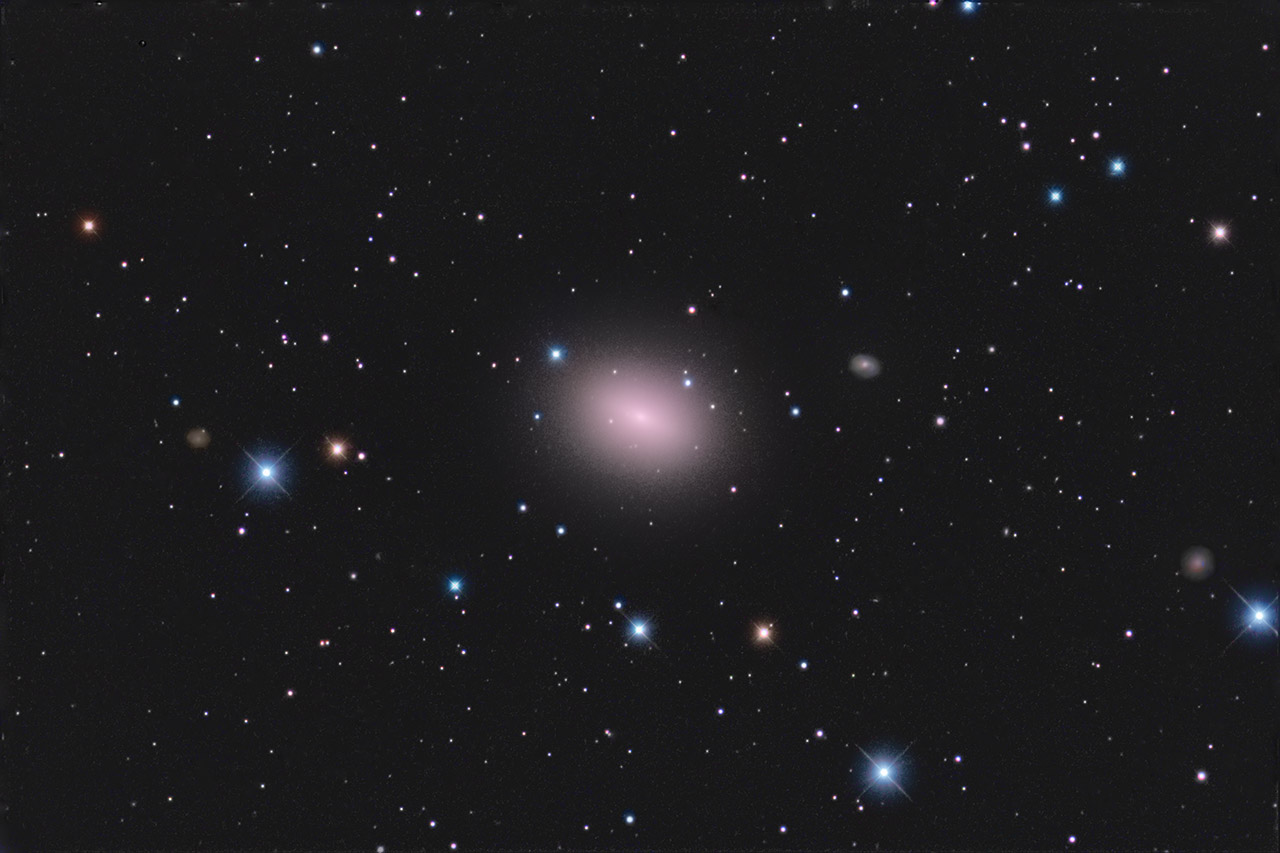 |
NGC 4697
|
|
6th October 2019The Ghost Of Jupiter, NGC 3242 |
A Planetary Nebula in Hydra. William Herschel discovered the nebula on February 7, 1785, and cataloged it as H IV.27. His son, John, observed it from the Cape of Good Hope, South Africa, in the 1830s, numbered it as h 3248 and included it in the 1864 General Catalogue as GC 2102. This became NGC 3242 in J. L. E. Dreyer's New General Catalogue of 1888. The name Ghost of Jupiter was coined by the noted British observer, Admiral Smyth, in the 19th century and the name has stuck. He noticed the similarity in size to Jupiter itself but that it had a much fainter ghostly glow. Nevertheless it is one of brighter planetary nebula at 8th magnitude and if you can see the Ring Nebula (M57) you should have no trouble with this one. The blue colour of C59 comes from the presence of doubly ionised oxygen but other gases are present in the nebula as well. Its distance is poorly determined but it is around 1500 light years. Image Details
|
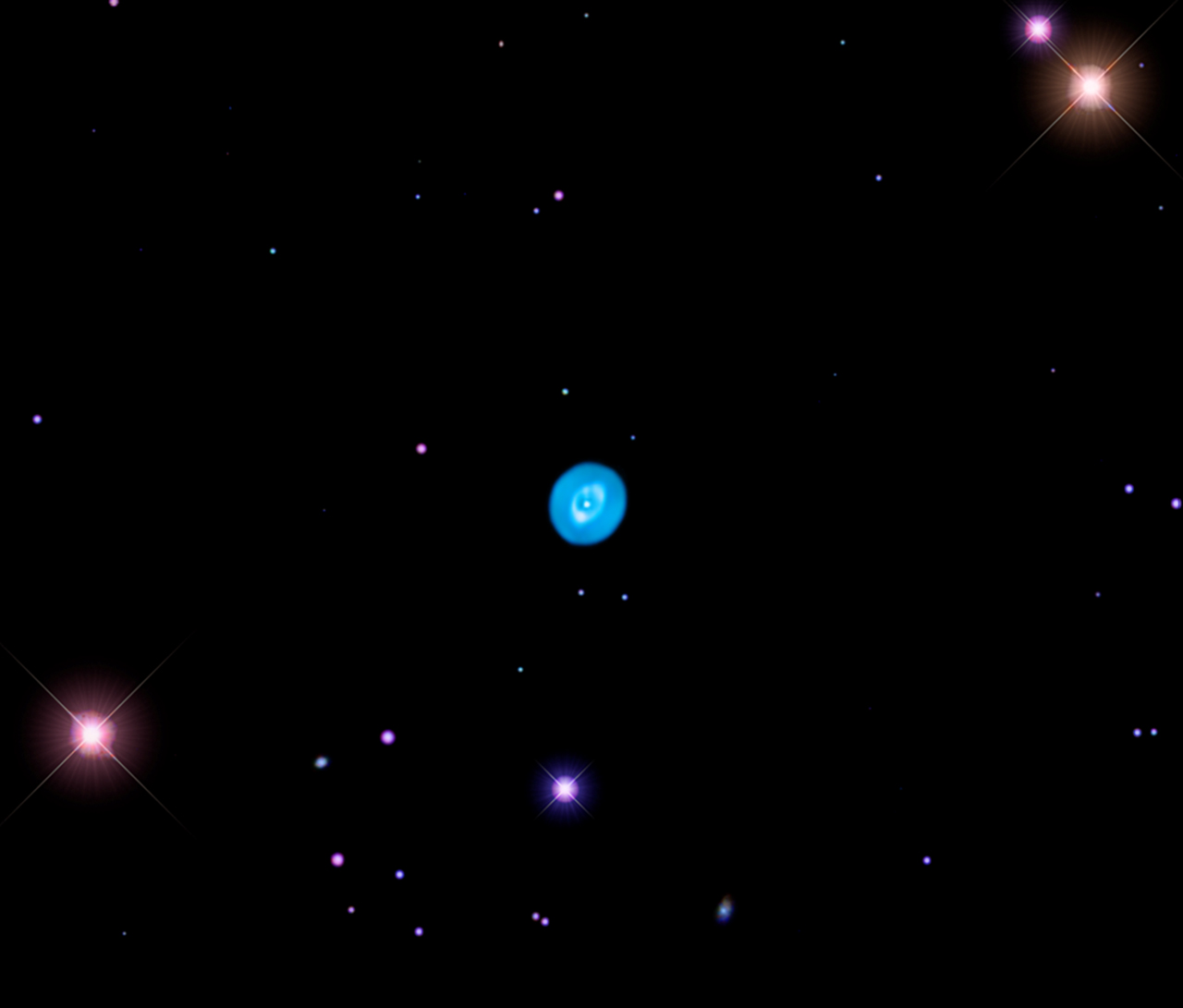 |
Ghost of Jupiter
|
|
15th September 2019Edge-on Galaxy, NGC 4244 |
There are several slender edge-on galaxies in the Caldwell Catalogue and this one, NGC 4244 or Caldwell 26, is sometimes called the Silver Needle Galaxy. NGC 4244 is one of the thinnest of galaxies with no central bulge. It is incredibly needle-like with a length of nearly one third of a degree yet with a width of less than 2 arc-minutes. This Sc (or Sd) spiral is much smaller than the Milky Way at 65,000 light-years across and lies around 13.'5 million light-years away. It has a falling rotational curve (Olling, 1996) so has little dark matter. There is a Hubble image available for this object.
Image Details
|
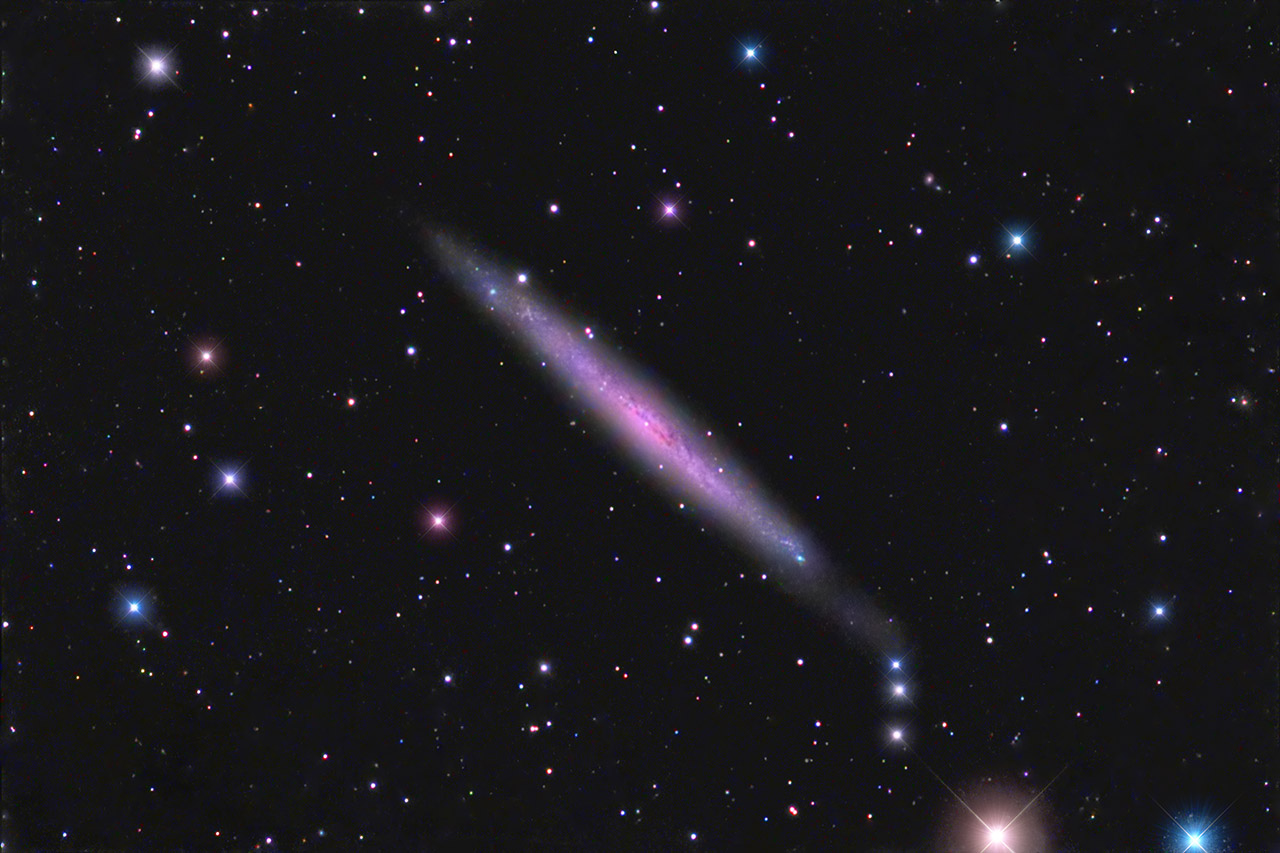 |
NGC 4244
|
|
8th September 2019The Coma Galaxy Cluster (Abell 1656) |
The Coma Cluster (Abell 1656) is the largest in local area with around 10,000 members. The central galaxy is NGC4889, which is the galaxy left of centre in my image. This image is just the central part of this huge cluster but over 100 galaxies are visible here - 109 I make it. The cluster is famous for the discovery of dark matter. It was unknown and unsuspected until the (controversial) Swiss-American astronomer Fritz Zwicky discovered that this cluster was unstable without a considerable amount of unseen mass to hold it together. This was in the 1930s and was largely ignored until further evidence for dark matter started piling up later in the 20th century. A plot of the dark matter in the cluster is shown right with the central portion of the cluster inset to scale.
Image Details
|
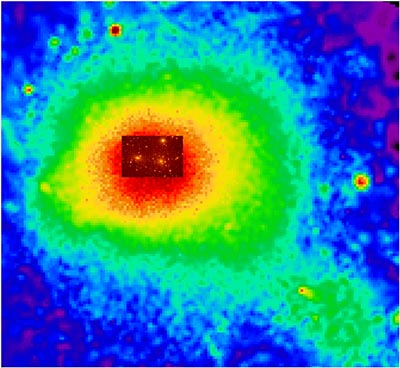 |
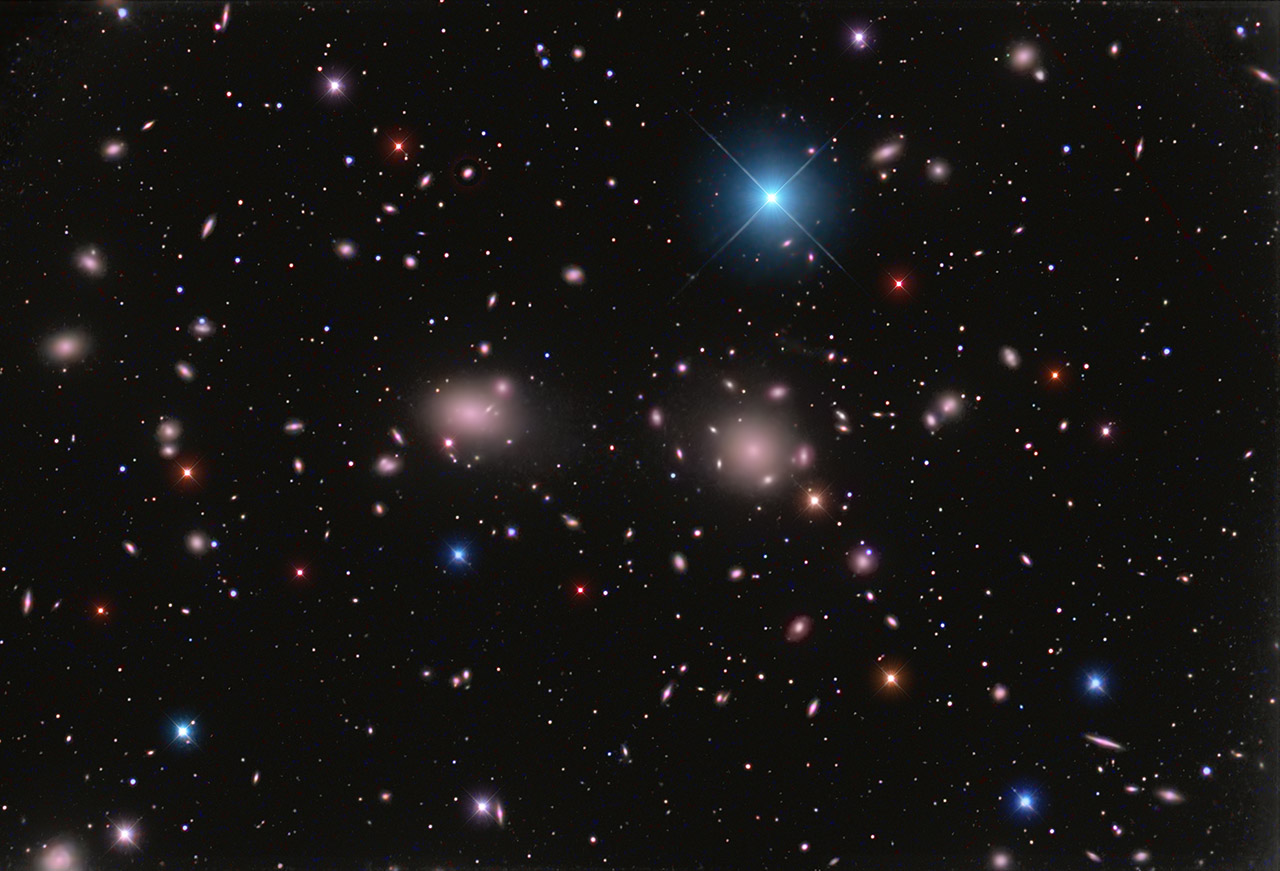 |
Coma Galaxy Cluster
|
|
25th August 2019Spindle Galaxy, NGC 3115 |
This Spindle Galaxy (there are others), is a bright SO galaxy, i.e. a disc galaxy without significant spiral structure or dust lanes, located in the faint constellation of Sextans. It is seen almost exactly edge-on, hence its name. It is bright (mag. 8.9) but, more importantly, it has a high surface brightness making it an easy telescope object, even from urban skies. To record its centre exposures no longer than 2 minutes were required. Thought to be several times bigger than our own Milky Way, galaxy NGC 3115 is composed of mainly of old stars. It now contains virtually no gas and very little is going on, apart from the stately orbits of its stars. However, its main claim to fame is that it is one of the first candidates for harbouring a black hole in its midst. It is now known of course that virtually galaxies harbour one at their centre.
Image Details
|
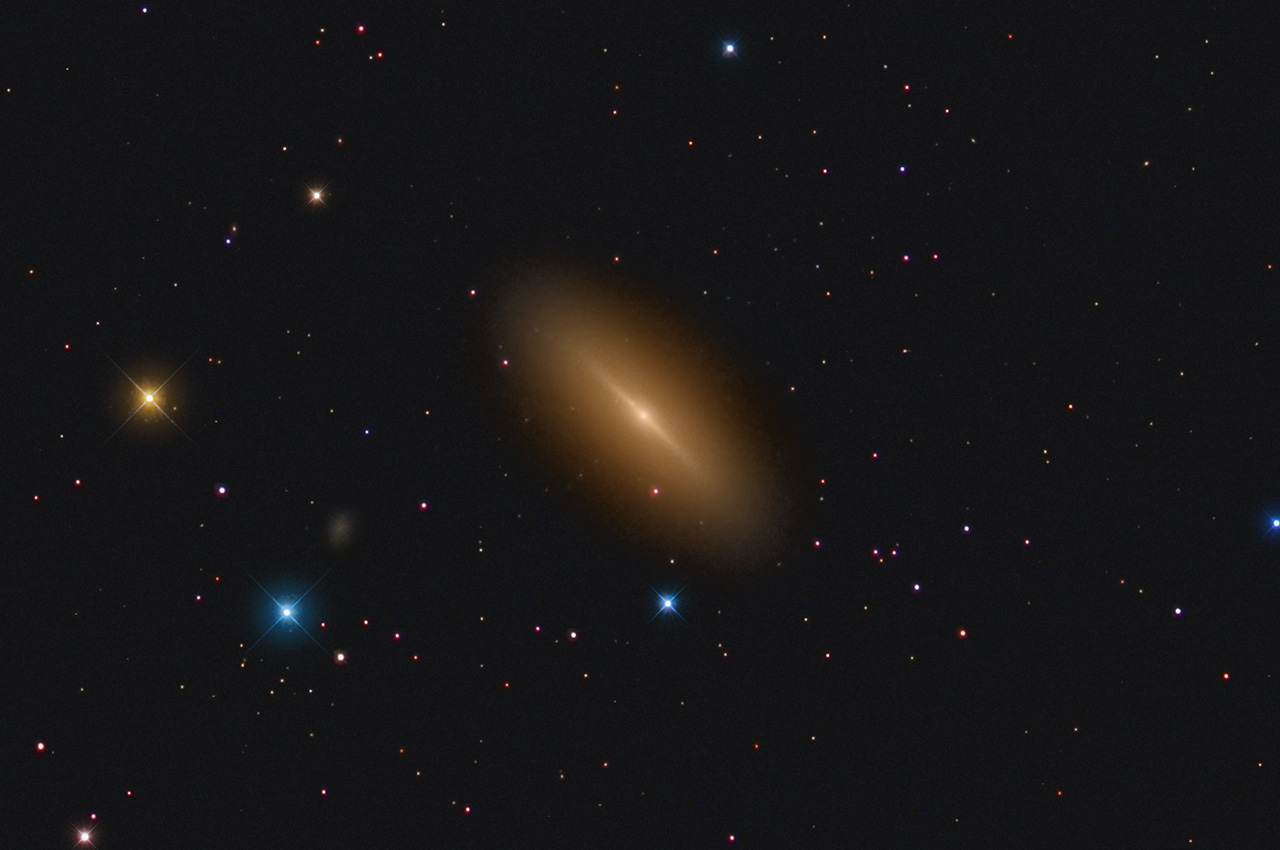 |
NGC 3115
|
|
5th August 2019Barred Spiral Galaxy NGC 4236 |
This mostly blue barred spiral is not displayed at its best as it is almost exactly edge-on to our line of sight. Located in Draco it is part of the M81 group of galaxies. This group is one of those that would have long ago dispersed if it wasn't for the presence on dark matter holding the cluster together. NGC 4236 is thought to be around 14.5 million light years away.
Image Details
|
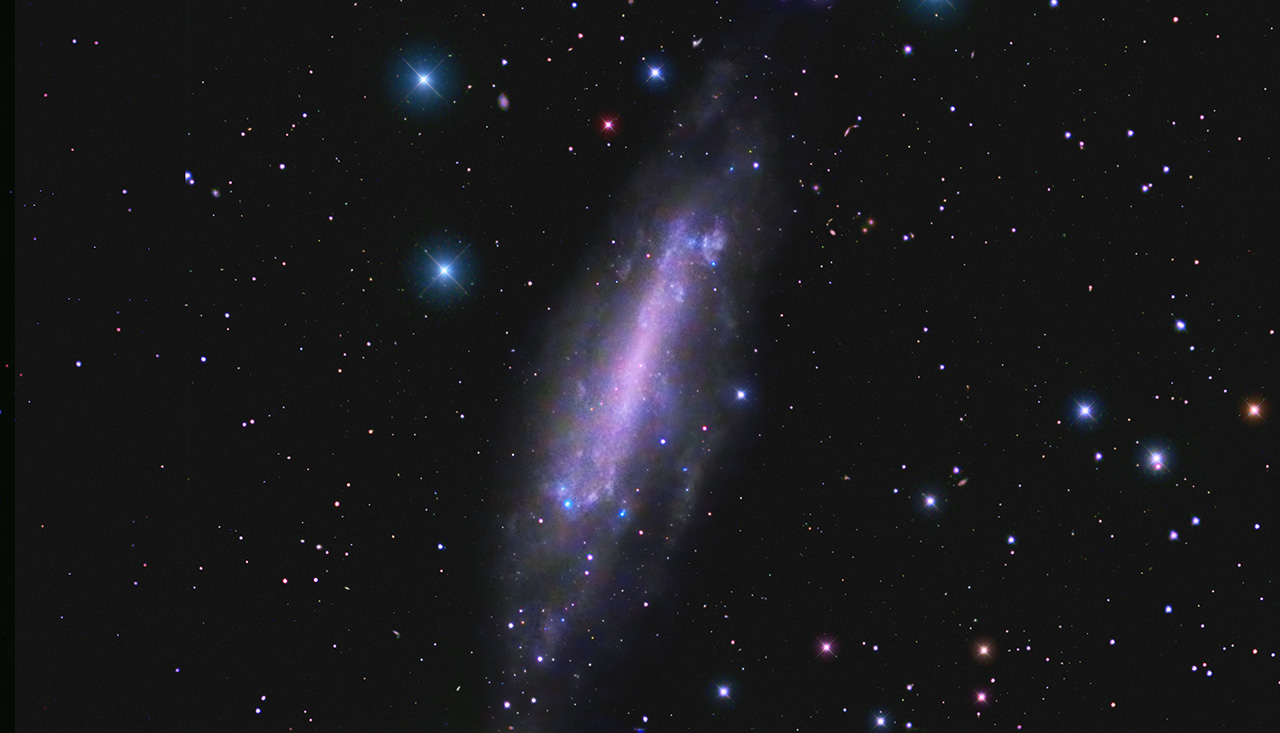 |
NGC 4236
|
|
21st July 2019The Cat's Eye Nebula, NGC 6543 |
Discovered by William Herschel on 15th Feb 1786, this planetary nebula was the first to have its spectrum was investigated by the English amateur astronomer William Huggins. He showed it was gaseous and nothing to do with planets at all. It is an emitter of hard X-rays which is an ongoing puzzle that has still to be resolved. The famous Hubble Space Telescope image (right) is shown in false colour highlighting regions of high and low ionisation. Three images were taken, in filters isolating the light emitted by Hydrogen alpha at 656.3 nm, singly ionised nitrogen at 658.4 nm and Oxygen III at 500.7 nm. The images were combined as red, green and blue channels respectively, although their true colours are red, red and green. The image reveals two "caps" of less ionised material at the edge of the nebula. Filters than can distiguish between H-alpha and Nitrogen cost around £1000.
Image Details
|
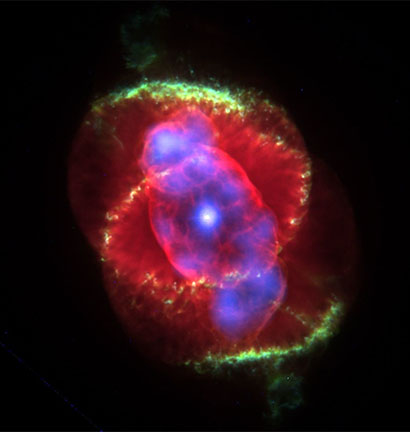 |
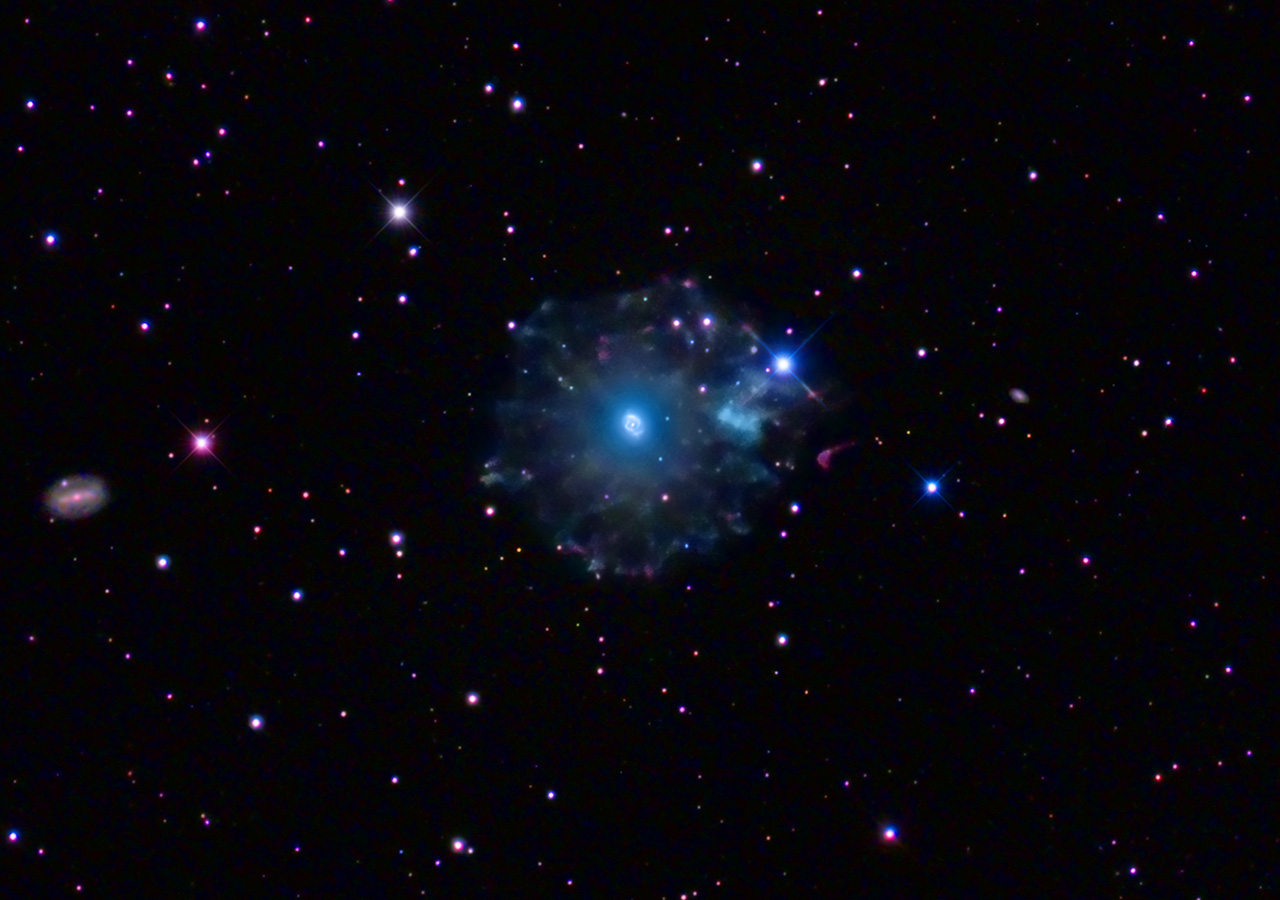 |
Cat's Eye Nebula
|
|
30th June 2019Hubble's Variable Nebula, NGC 2261 |
Edwin Hubble is famous for galaxies and proving that the universe was expanding so when he had first shot with the then new 200 inch Palomar telescope surely he would have chosen a galaxy. But no he chose this nebula. The same happened when he first tried the 100 inch telescope. You could say he had a bit of a fixation for this object! The reason for that fixation was that it varied and not only that it varied at the speed of light. How could that happen? Nothing moves at the speed of light or well light does and that turned out to be the explanation. The nebula emanates from the variable star R Monocerotis and is illuminated by it. The probable explanation of the variations is that dense clouds of dust near R Mon periodically block the illumination from the star. This casts varying shadows onto the nebula and shadows have no problems in moving at the speed of light. Most images of this object show the nebula against a black sky. However. it is evident from the widefield view below that the surrounding sky is anything but black. Accordingly my main image below has retained the faint nebulosity around Hubble's Variable Nebula I first imaged this object in 2001 and when I was comparing images I noticed a fast moving star - see animated image at the right. In Hubble's 1949 image this star is even further to the north (top). Image Details
|
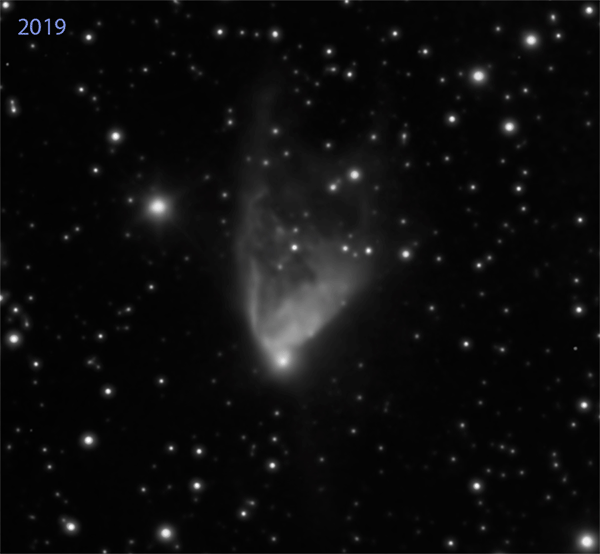 |
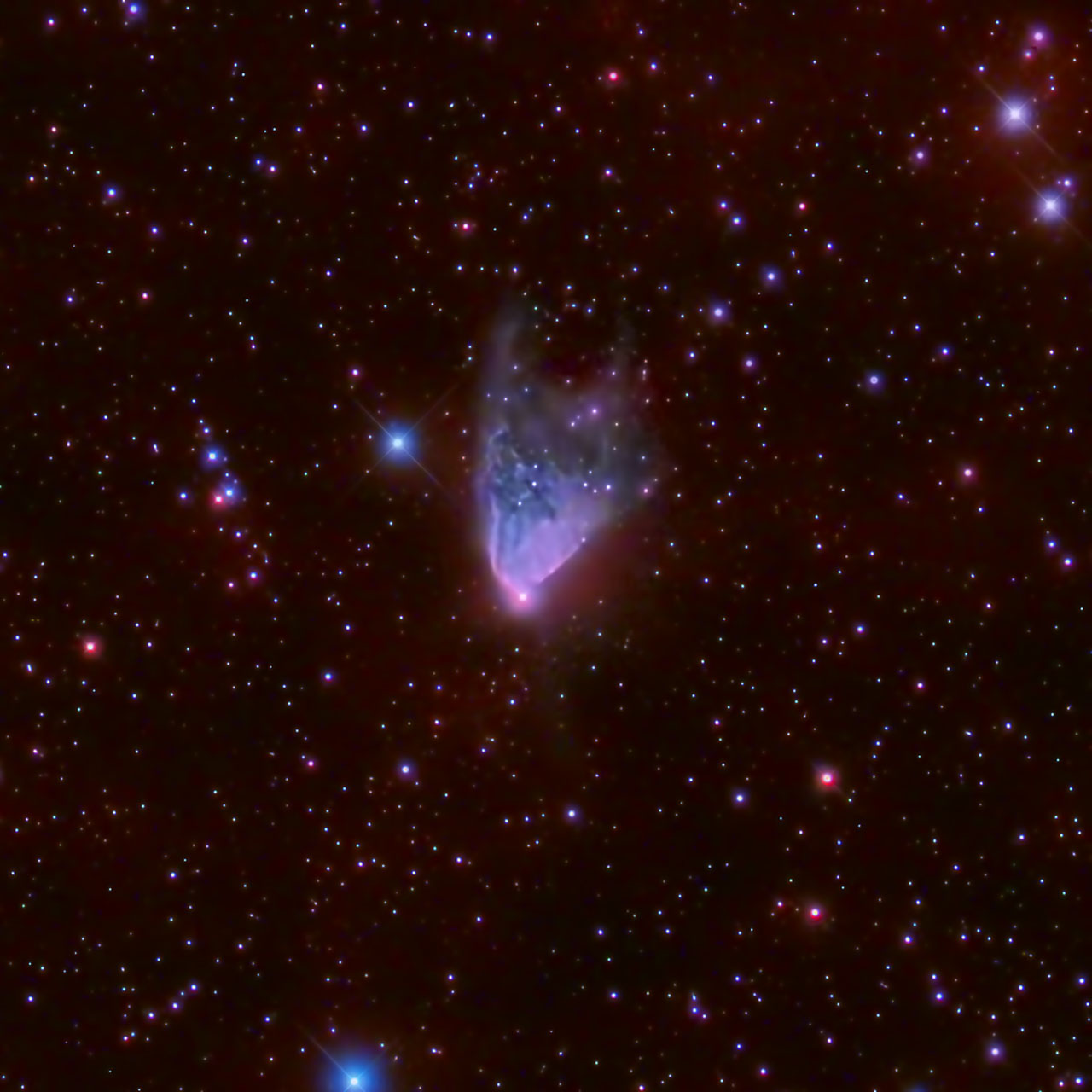 |
Hubble's Variable Nebula
Hubble's Variable Nebula - widefield view |
|
23rd May 2019Diffuse Nebulae Messier 78 & NGC 2071 |
These two largely reflection nebulae but with a bit of hydrogen alpha thrown in for good measure are located in eastern Orion and very close to Barnard's Loop - see right. M78 is the lower nebula and NGC 2071 the upper one but they are clearly associated. They both belong to the Orion B molecular cloud complex which is about 1,350 light-years distant from Earth. The Orion Molecular Cloud Complex is a star forming region with stellar ages ranging up to 12 million years. Two giant molecular clouds are a part of it, Orion A and Orion B. The stars currently forming within the Complex are located within these clouds. A number of other somewhat older stars no longer associated with the molecular gas are also part of the Complex, most notably the Orion's Belt (Orion OB1b), as well as the dispersed population north of it (Orion OB1a). The Complex is between 1 000 and 1 400 light-years away, and hundreds of light-years across. Reference Wiki.
Image Details
|
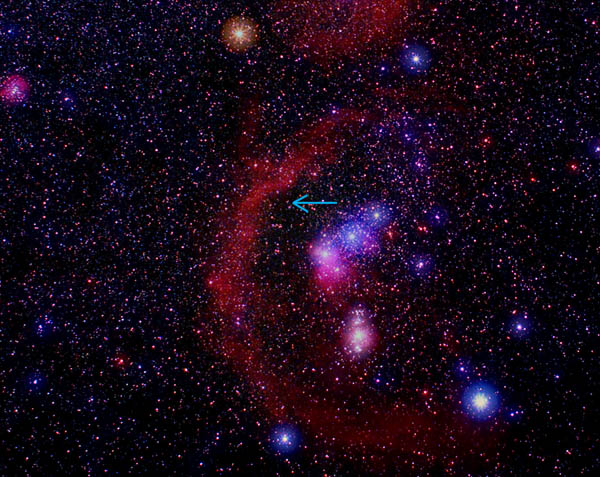 |
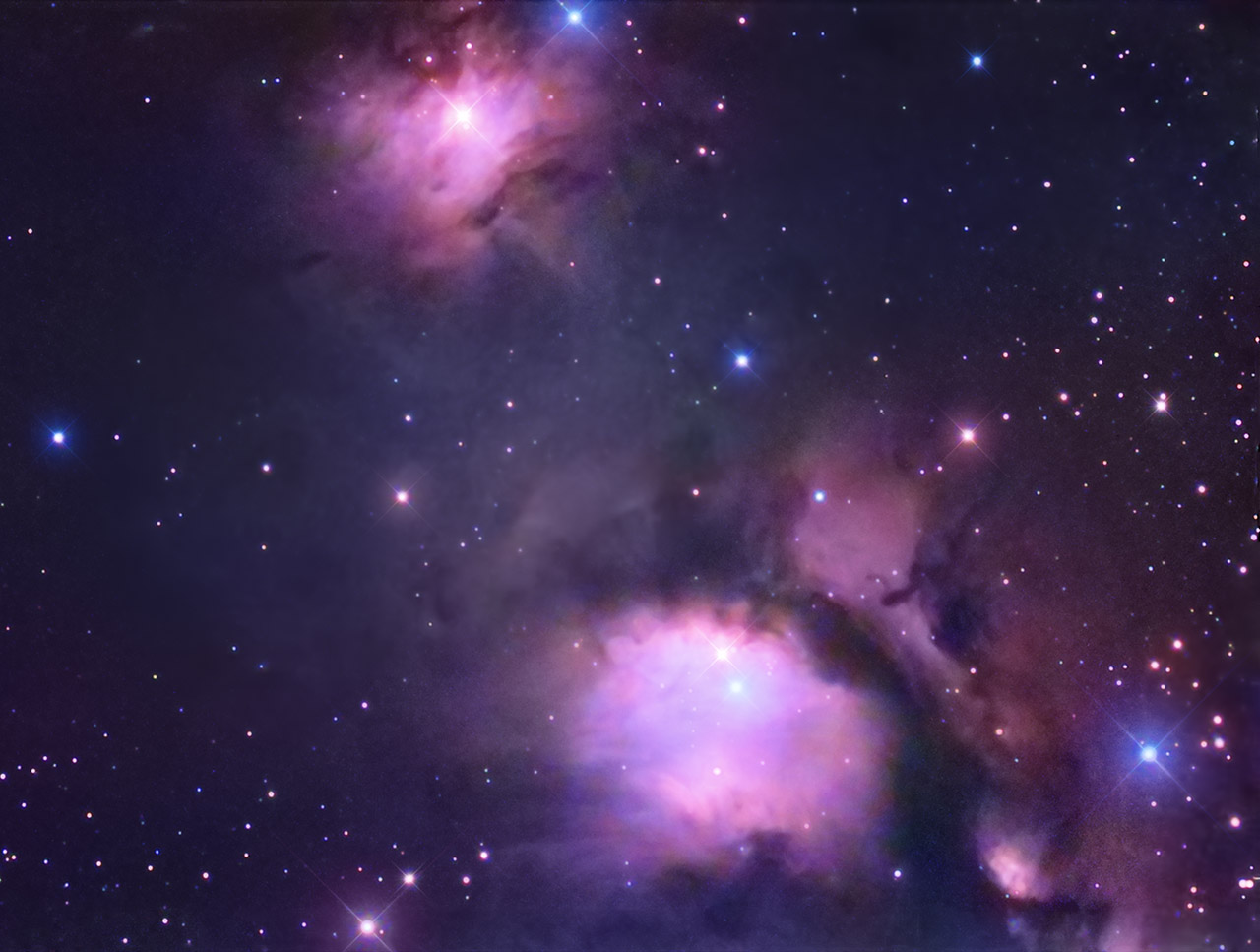 |
M 78
|
|
5th May 2019Tau Canis Major Cluster, NGC 2362 |
How low can you go? At an elevation of just 10 degrees I was pushing my luck with this open cluster. I had had a try in 2010 and decided it was time to try again. A fabulous open cluster when viewed with any optical aid but really needs to be seen from further south than Britain. It surrounds the 4.4 magnitude star Tau Canis Major, which lends the cluster its name. Having a bright star in the cluster adds a real touch of class! Binoculars show Tau CM and an unresolved haze. In a 6 inch (150mm) telescope the haze reveals itself to be a tight swarm of 25 stars, spread around Tau CM in a circle. In a bigger telescope it just gets better with about 50 stars visible in a 16 inch (more if the cluster is high overhead in your location) and Tau, which is a bit dazzling, has two bluish companions. Tau CM is located in the “tail” of Canis Major, 11.5° south-east of Sirius. Image Details
|
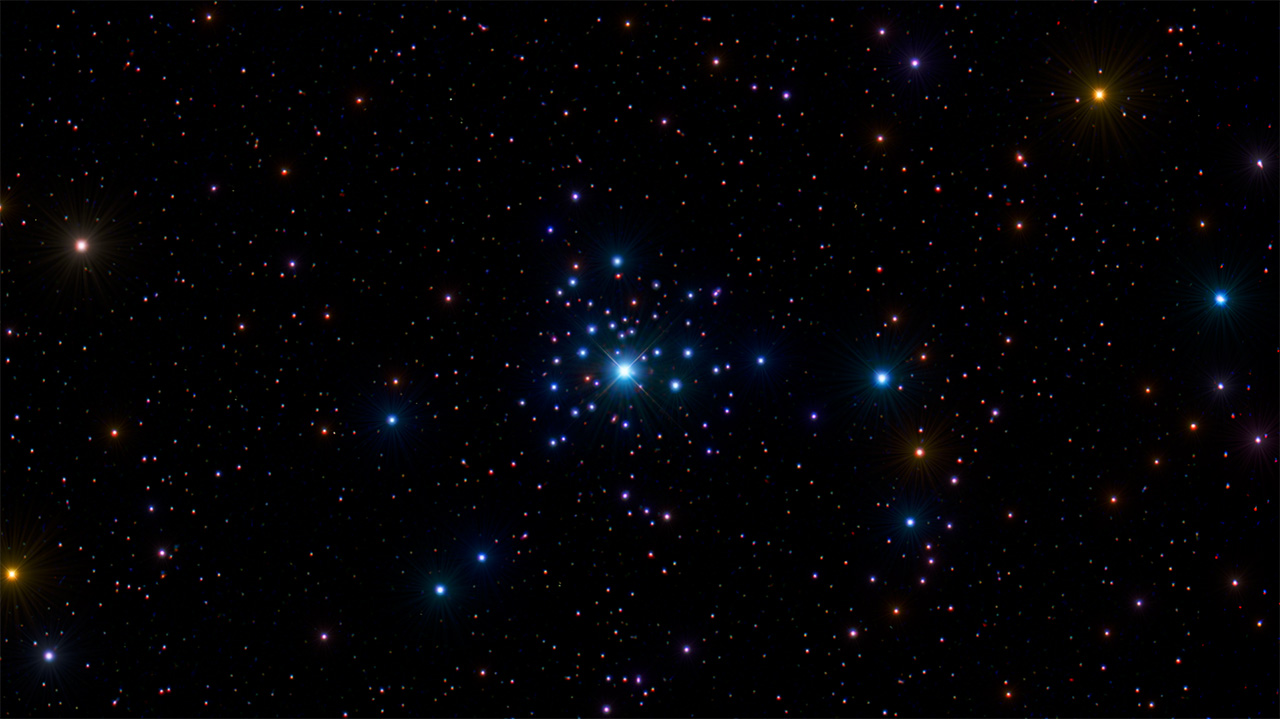 |
NGC 2362
|
|
23rd April 2019Planetary Nebula Abell 4 |
Located close to the open cluster M34 in Perseus and widefield shots of the latter will more than likely have recorded this faint planetary nebula at the same time. An object with virually no data - well professional research papers covering it. It is also erroneously catalogued as PGC 10427 i.e. a galaxy in some databases. At only 22 arcseconds across it is pretty small but is actually quite bright at least in imaging terms. The galaxy that seemingly points towards it is 2MFGC 2191 (PGC 2201333) but is much fainter and I would estimate around mag 17 for its nucleus. There are several more galaxies in the area but with no redshift data it is hard to be sure they are associated. It would seem likely though as they are roughly of similar brightness and size. Abell 4 is listed as mag 16.7 and its central as 19.4 which I would confirm as probably correct. My limit is around 21st mag and I have recorded stars much fainter than the central star so it does seem about right. For shooting this object I did not use narrowband filters - no doubt an OIII filter would have shown the nebula well but suppressed the galaxy. As the pair make an interesting grouping a broadband filter was used to record both well.
Image Details
|
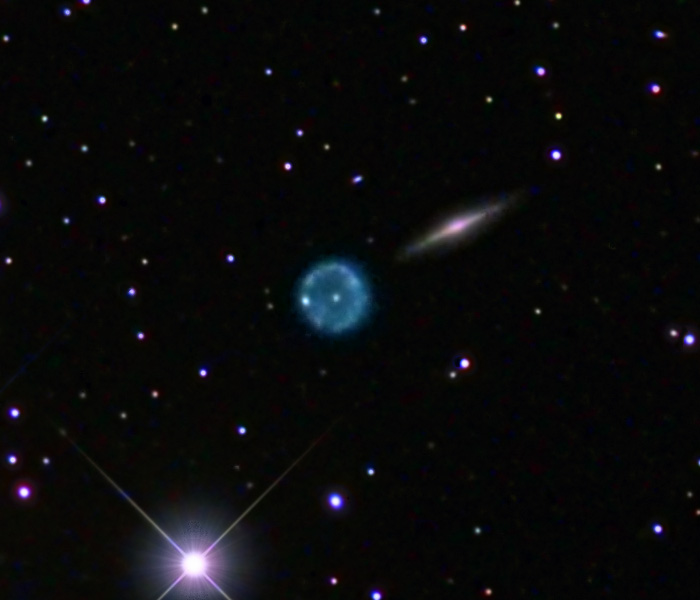 |
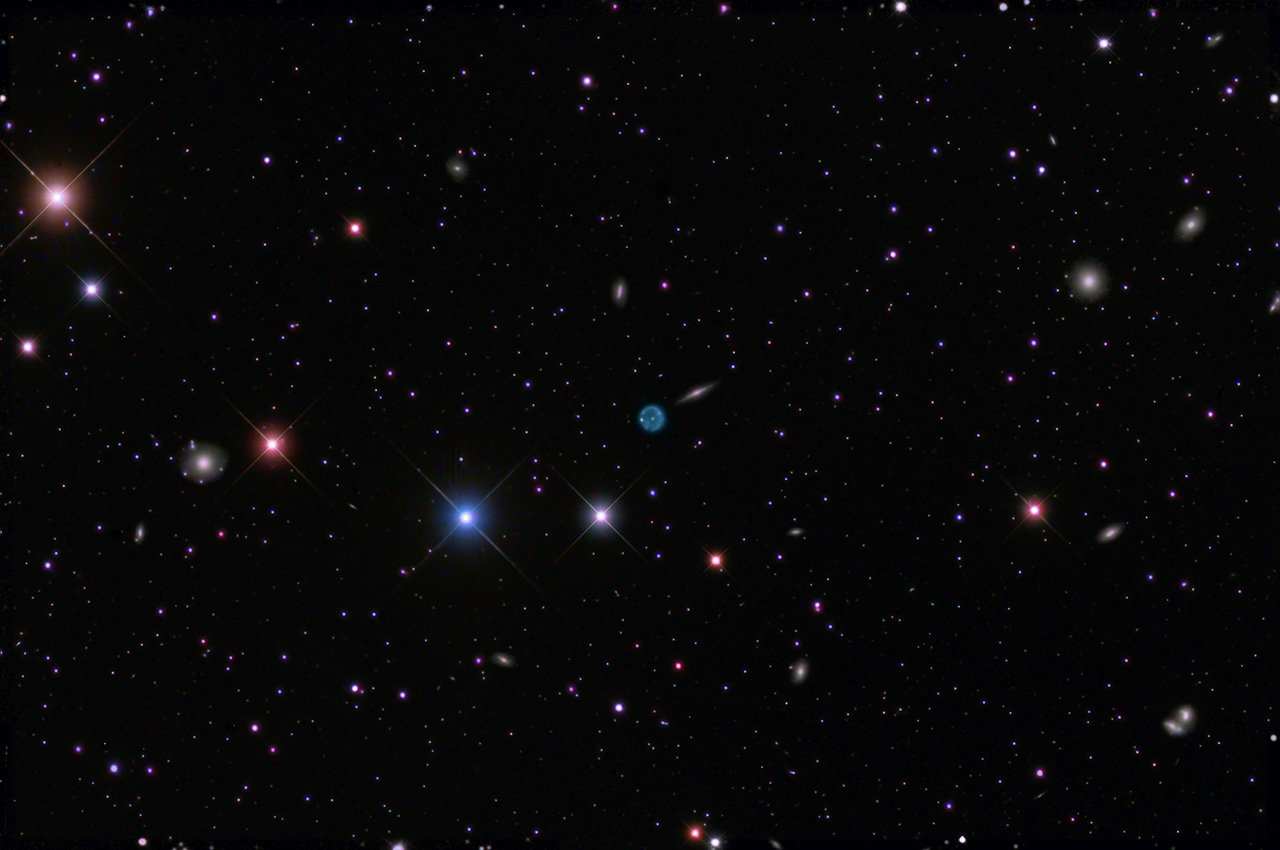 |
Abell 4 Planetary Nebula
|
|
29th March 2019Polar Ring Galaxy, NGC 660 |
NGC 660 is located around 45 million light-years away and is one of a rare class of “polar ring" galaxies, i.e. it has a belt of gas and stars around its centre probably emanating from a collision with another galaxy about one billion years ago. It also has a LINER-type nucleus (low ionization nuclear emission-line region; Nagar, Falcke, Wilson & Ulvestad 2002). It is believed to contain an exceptionally large amounts of dark matter. In 2012 a massive outburst ocurred at the centre of NGC 660 that was around ten times as bright as a supernova explosion. Observations at Jodrell Bank confirmed this burst to be caused by a massive jet shooting out of the supermassive black hole at the center of the galaxy (ref: A new period of activity in the core of NGC 660, Megan K. Argo et al., 2015). The jet was observed to have an apparent speed of 1.2x c, the speed of light. This is a line of sight effect and its actual velocity was close to, but of course less than, c. The pair of galaxies at the botom have a common redshift so are probably an associated pair and lie at around 700 million light years. Image Details
|
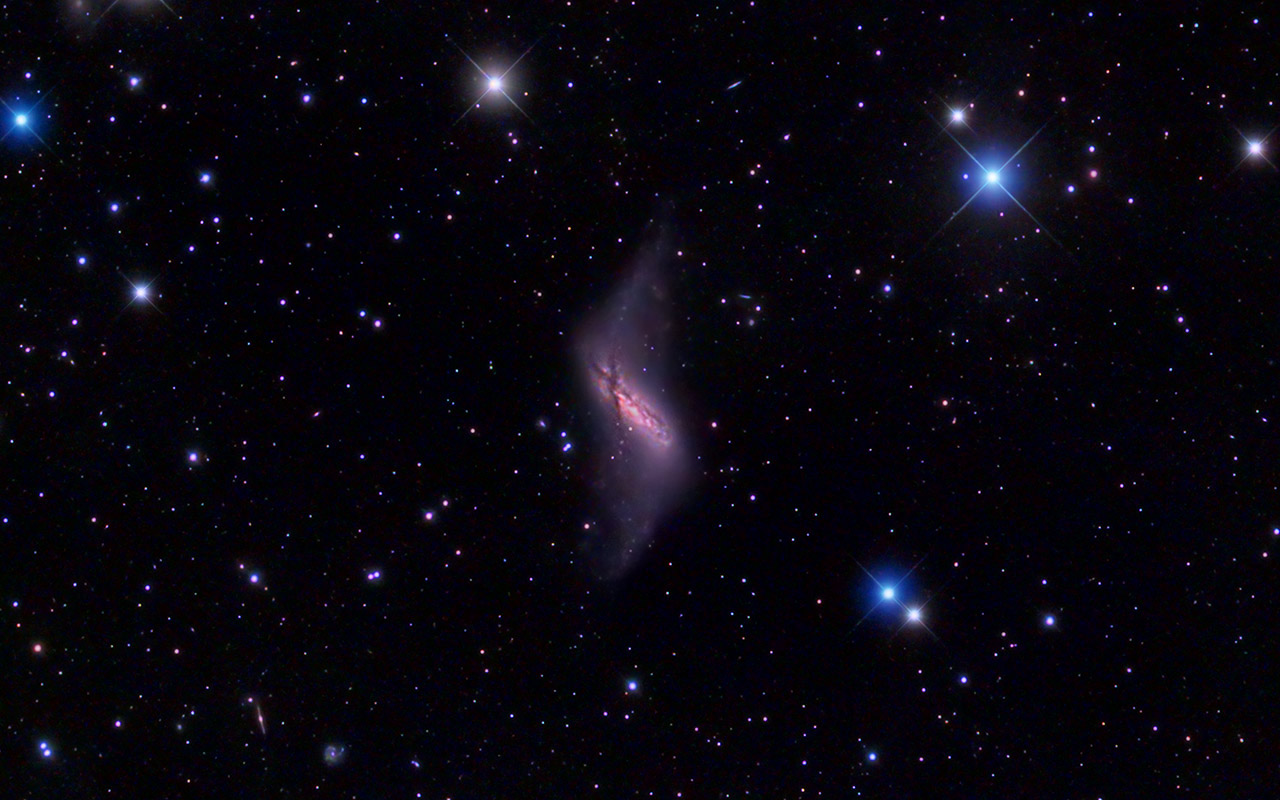 |
NGC 660
|
|
11th March 2019Globular Cluster, Palomar 2 |
One the brightest (least faint) of the Palomar globular clusters and it actually looks like a globular cluster. However, it is a remote cluster and we view it through the plane of the Milky Way so it is heavily reddened and is probably te reason it took the Palomar Schmidt Camera to spot it. Film in those days was more sensitive to blue objects. Pal 2 has the unique distinction of being the globular cluster located farthest on the sky from the Galactic center, it is in Auriga of all places. It is classed as an outer halo cluster and it is a pretty remote one at that. It's distance (ref: Harris etal. 1997) is around 110 million light years from the galactic centre. This gives a clue that is must be one of the larger Milky Way clusters. Image Details
|
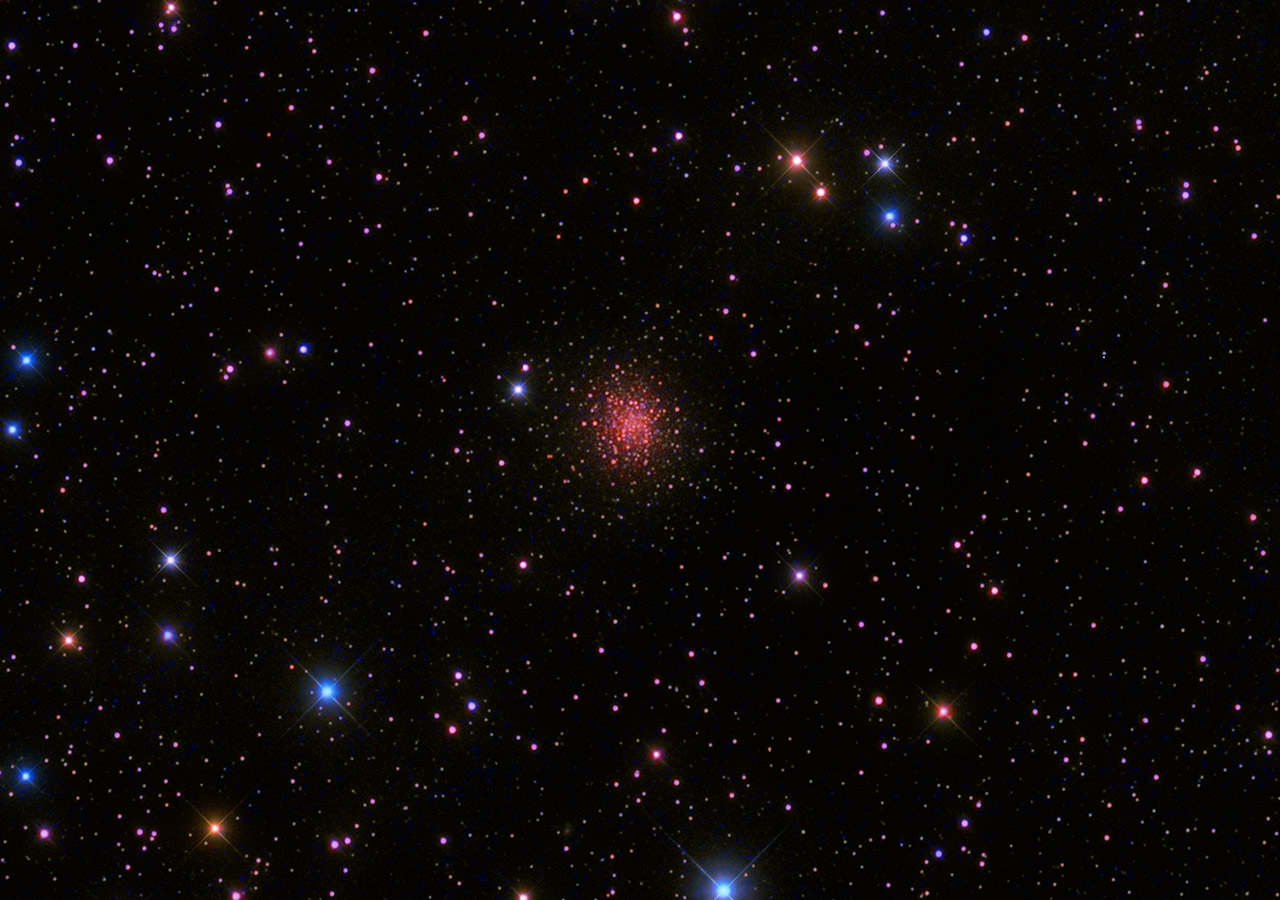 |
Palomar 2
|
|
3rd March 2019Comet Iwamoto |
A comet discovered by a human being and not a robotic telescope! Japanese amateur Masayuki Iwamoto spotted it in Hydra on the night of 18th December 2018 at magnitude 12. It has a high orbital inclination which is perhaps why the professionals missed it. Its closest approach to the Sun was on 7th February and its closest approach to Earth on 12th February. I caught it 13 days later by which time it had faded considerably. Still there is the suspicion of a tail on the comet's left (east) side. Its highly eccentric orbit lasts 1,371 years and goes out to 245 AU from the Sun taking it beyond the Kuiper Belt. If you missed it this time it will return in 3390 AD. Image Details
|
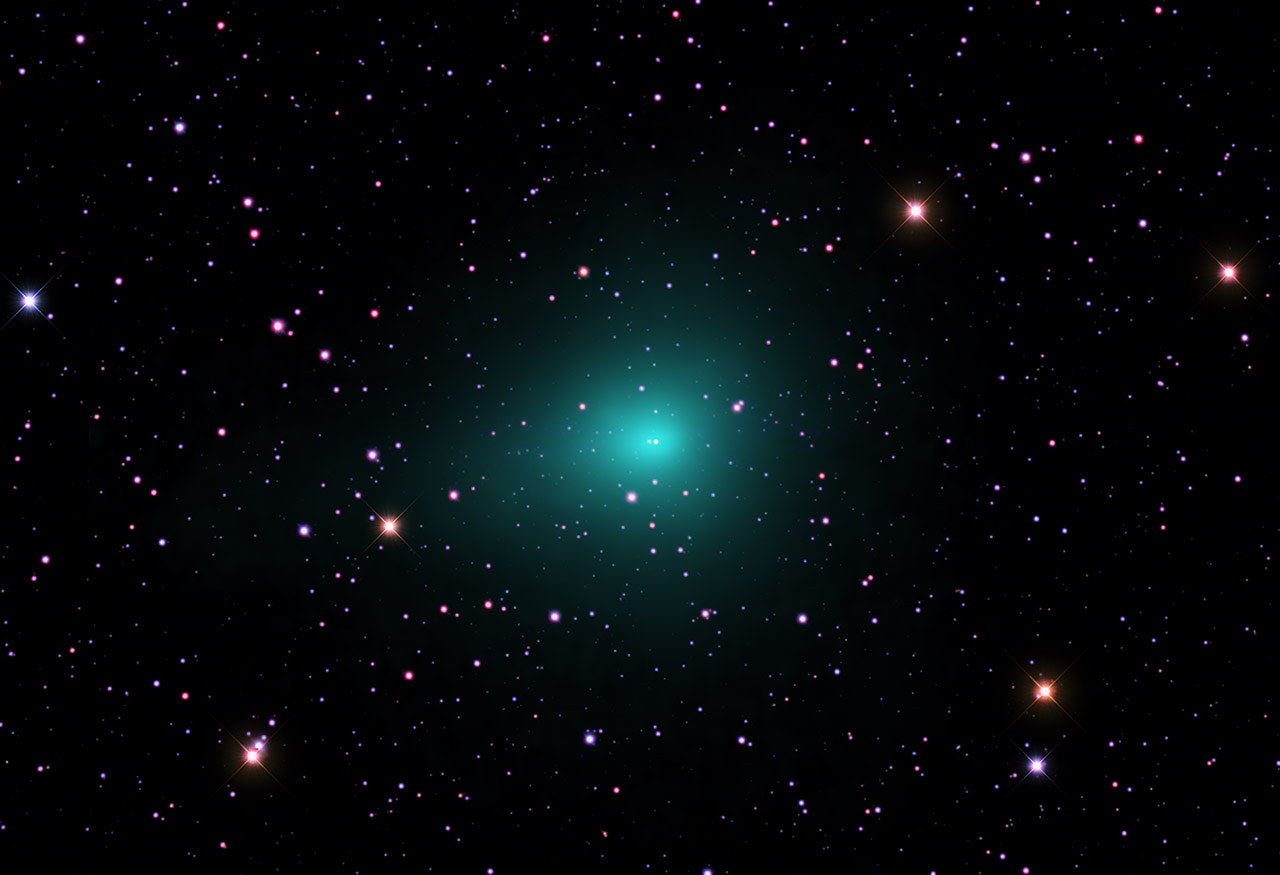 |
Comet Iwamoto
|
|
1st March 2019Globular Cluster, Palomar 1 |
Very poor weather in December meant it took 4 nights to get enough images for this very faint globular cluster. Positioned in the halo and possibly in the Outer Arm of the Milky Way galaxy. First discovered by George O. Abell in 1954 on the Palomar Survey Sky plates. Located in Cepheus. Palomar 1 (Pal1) is a very odd globular cluster with a very young age - around 4-6 billion years (Sarajedini et al. 2007) - note this is even younger than previous estimates. It also has a high "metallicity" ie not formed from original pristine material. Its location is also a bit odd with extended tidal tails (ref: Niederste-Ostholt et al., 2010)) either side of the cluster centre, with roughly as many stars in the tails as in the central cluster region. Thoughts are that it may have been once associated with a dwarf spheroidal galaxy which was later destroyed by tidal forces.
Image Details
|
Sloan SDSS Image |
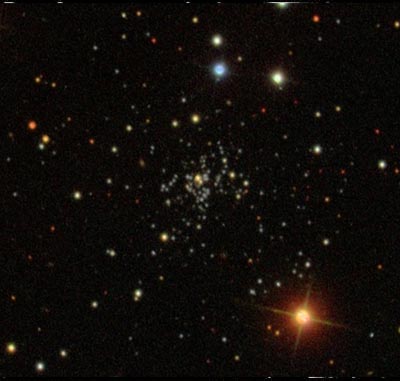 |
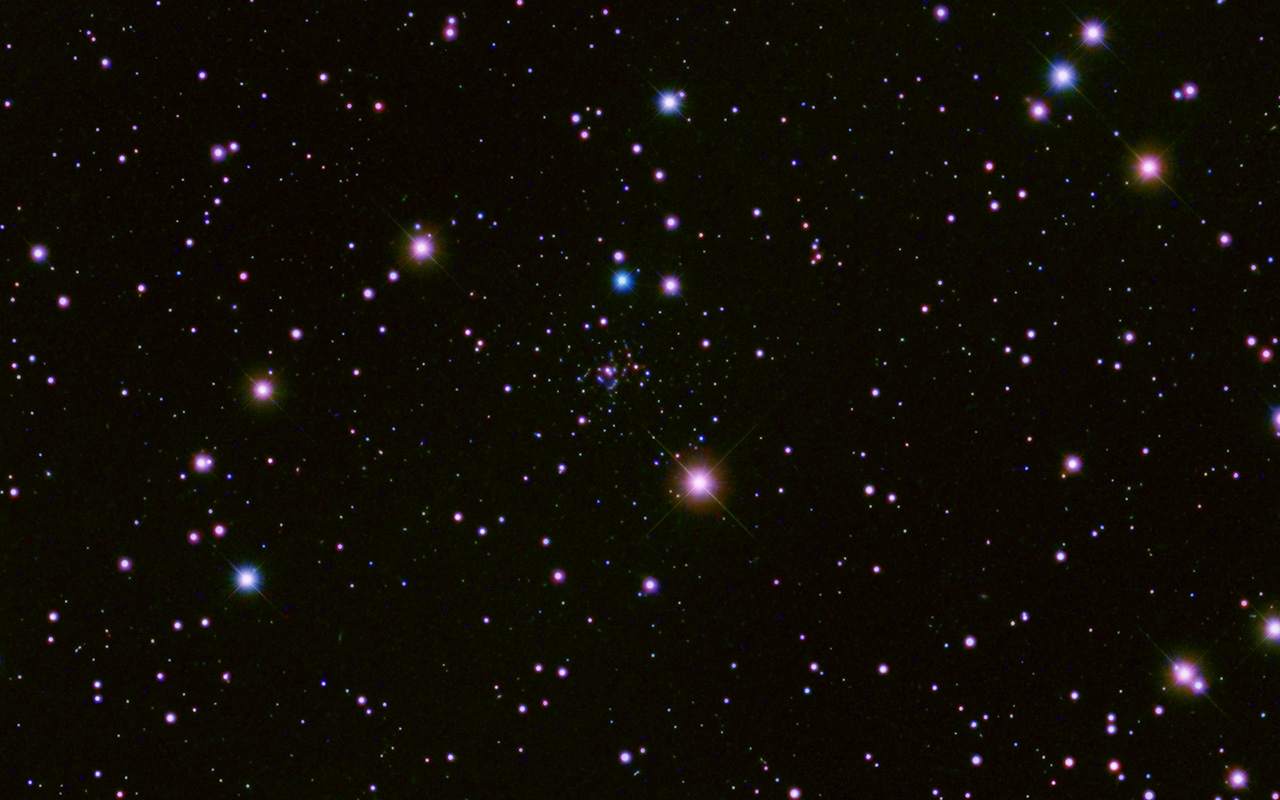 |
Palomar 1
|
|
7th February 2019Mirach's Goblin |
Mirach's Ghost (NGC404) is relatively well known but Mirach's Goblin has only recently (2016) been discovered although details were only published in 2018. It was discovered by an Italian amateur astronomer, Giuseppe Donatiello. This very faint dwarf galaxy is located about 1 degree south of Mirach - see widefield image below. It is more properly known as Donatiello 1 after its discoverer. Donatiello (the astronomer) was searching for faint tidal streams between M31 and M33 and spotted this faint smudge. It's distance and that of NGC404 are the same at 10 million light years so probably associated. The deep image at right is by Martinez-Delgrado et al using the 3.58 metre telscope on La Palma. It looks like they were struggling with light over-spilling from nearby Mirach. Reference: Mirach's Goblin: Discovery of a dwarf spheroidal galaxy behind the Andromeda galaxy - David Martinez-Delgado et al., 10 Oct 2018. Image Details
|
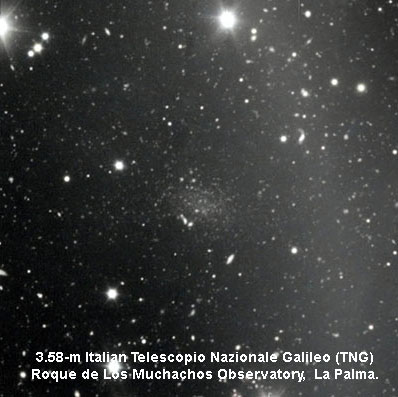 |
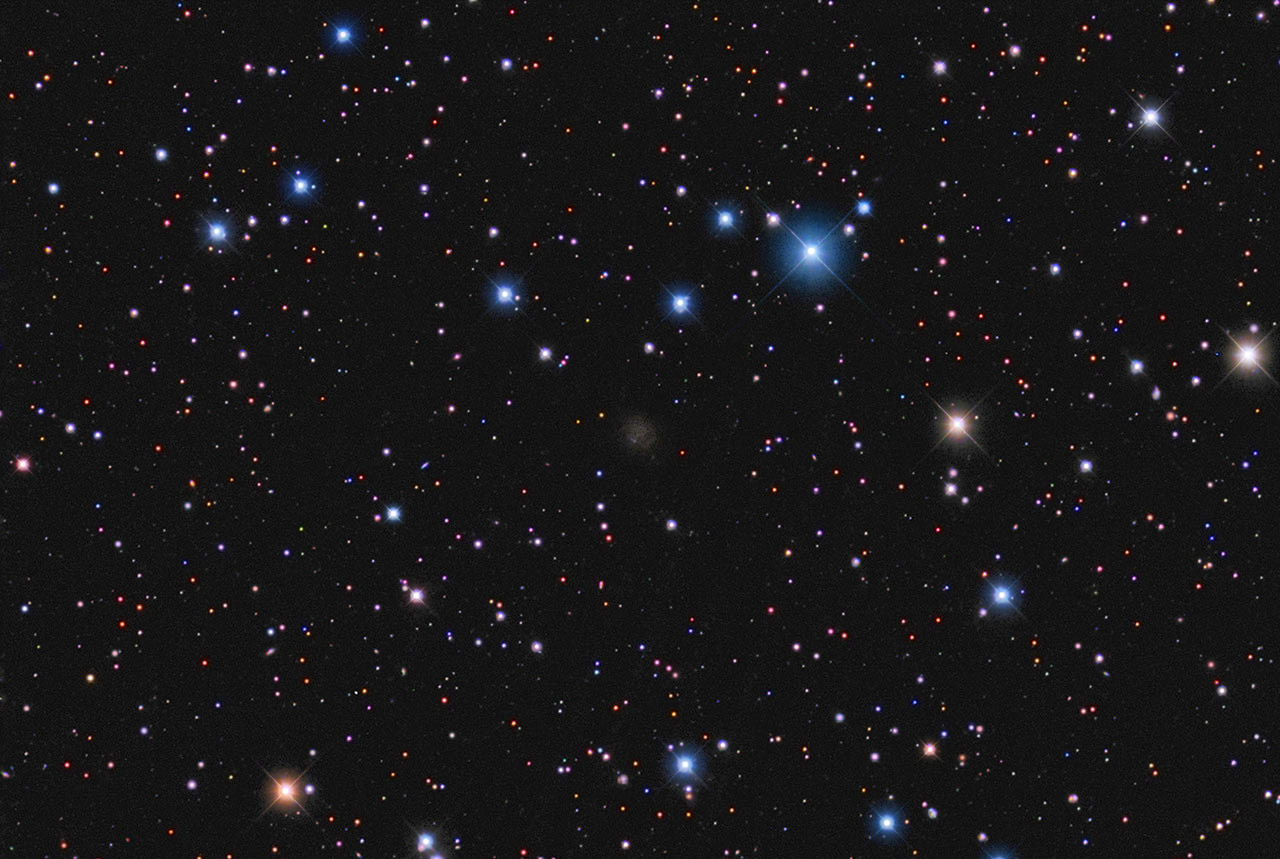 |
Mirach's Goblin |
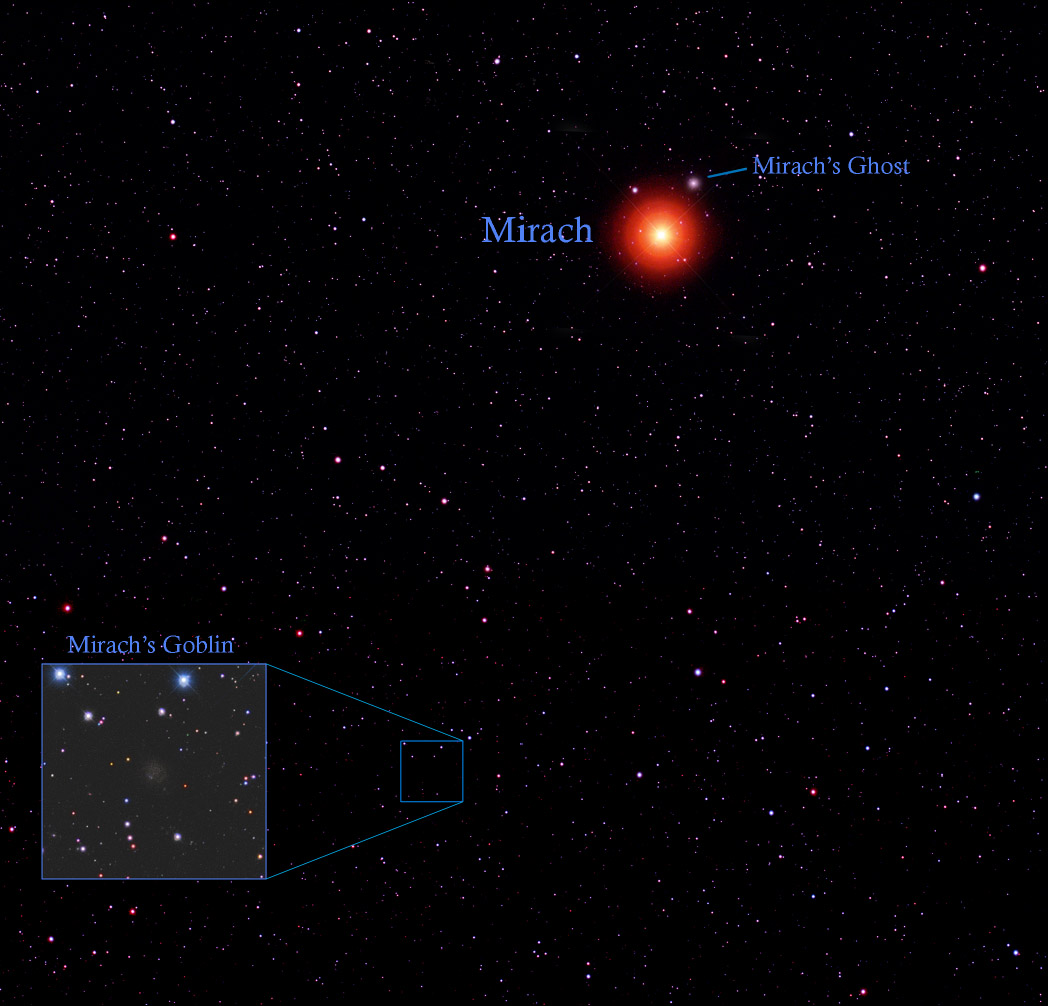 |
Mirach's Ghost & Goblin - widefield
|
|
29th January 2019Supernova 2019np in NGC 3254 |
Discovered by Koichi Itagaki on 9th Jan 2019 in the spiral galaxy NGC 3254 in Leo Minor. It is a classic type Ia and was discovered early - probably before its maximum. I estimate it to be around 14th mag on 27th January but my estimates are somewhat approximate as light pollution filters were used. It appears to be located at the end of a spiral arm on the outskirts of the galaxy making it easy to spot and presumably it is not very obscured. NGC 3254 has a redshift of 0.004 and is estimated to be around 100 million light years away. So the star exploded 100 million years ago! Image Details
|
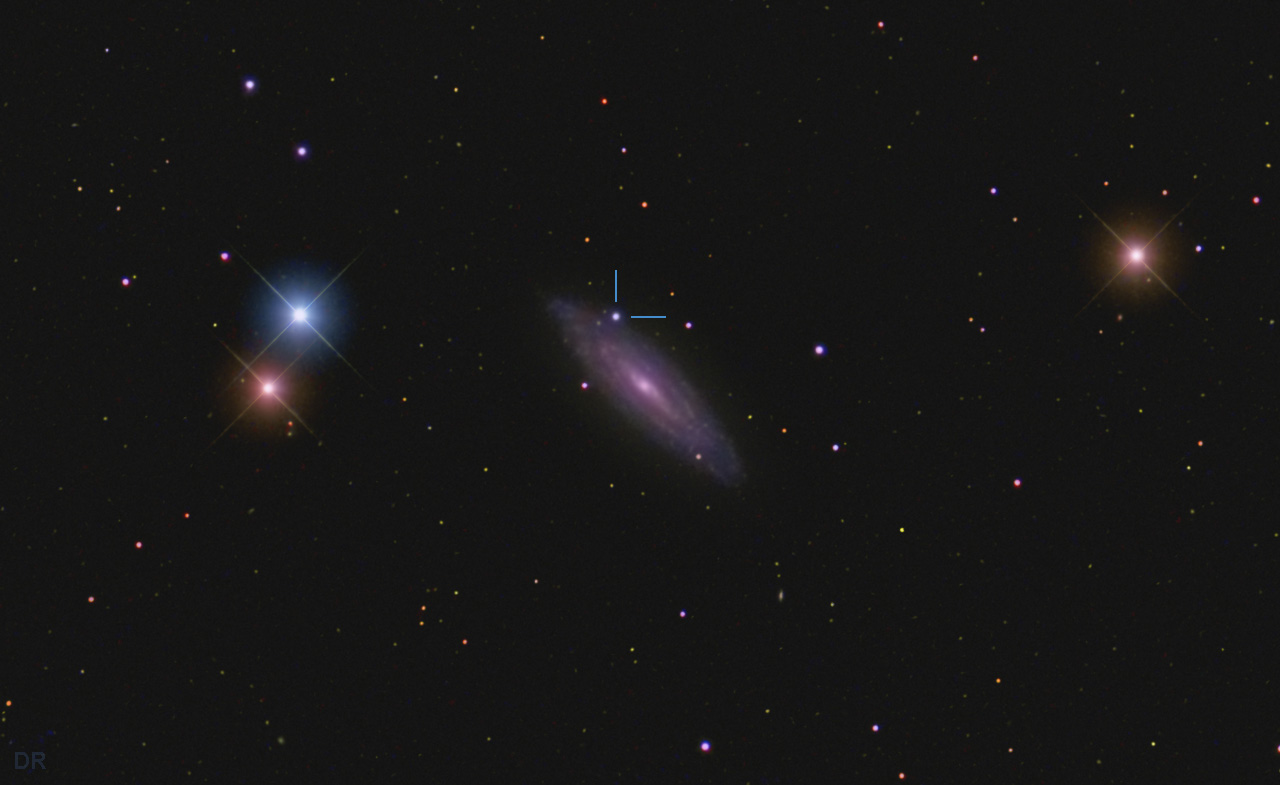 |
Supernova in NGC 3254
|
|
23rd January 2019Mirach's Ghost, NGC 404 |
The instructions with my camera (Apogee Alta) strongly advises against shooting bright objects but I was determined to give this one a go. Yes there was a residual image that took some time to dissipate but it was a poor night so faint targets were not an option. The reflections from Mirach were troublesome but in the end were removable. NGC404 is a nearby (10 mly) dwarf S0 galaxy almost certainly harbouring a Massive Black Hole (MBH). Massive in this case is relative as at 150,000 solar masses this makes it the galaxy with the lowest-mass central MBH known. A number of lines of evidence suggest that the putative MBH in the centre of NGC404 is currently accreting material so it is still active. This central activity has resulted in NGC404 being classed as a Liner (low-ionization nuclear emission line region) Galaxy and is the nearest known. Image Details
|
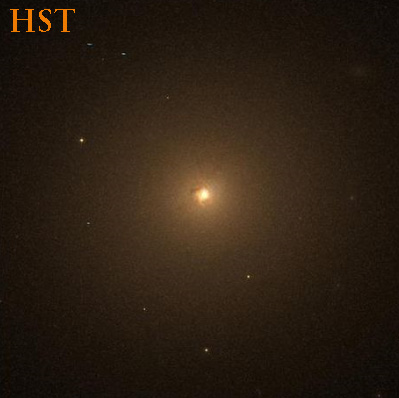 |
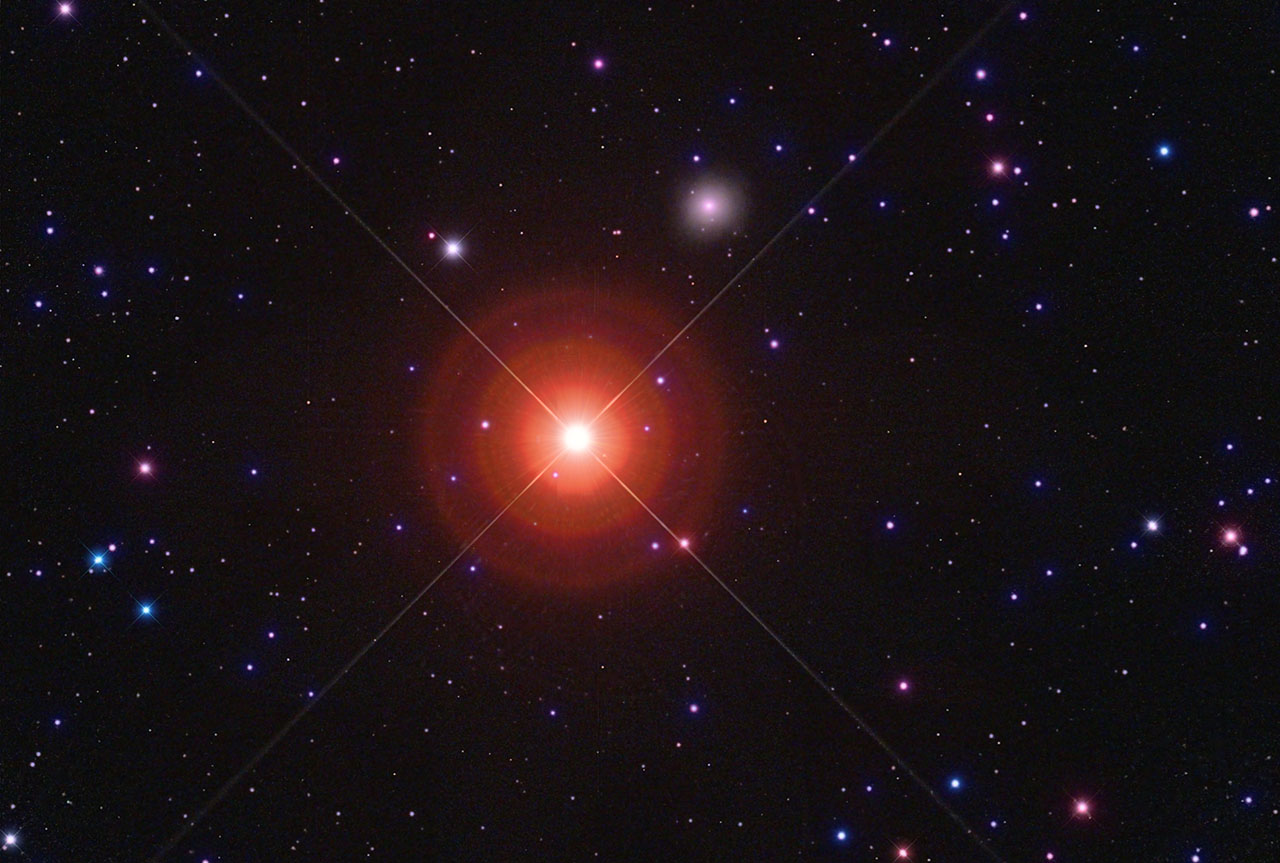 |
Mirach and NGC404
|
|
11th January 2019Open Cluster, Messier 34 |
A poor night and I wanted to check tracking which had been misbehaving recently so I chose a bright object - open cluster M34. The issue I was trying to overcome is the joystick hand control on the Paramount - it can stick slighly on and cause drift. Seemed ok tonight though. Must remember to give it a bang before the next time. In cluster research, M34 is an important cluster with an age of 250 million years which places it between the Pleiades at 100 million years and the Hyades at 800 million years. Its distance is around 1500 light years. Despite its relatively young age it has 19 known white dwarf stars - giant stars that are reaching their end of their lives having already exhausted their hydrogen fuel. Image Details
|
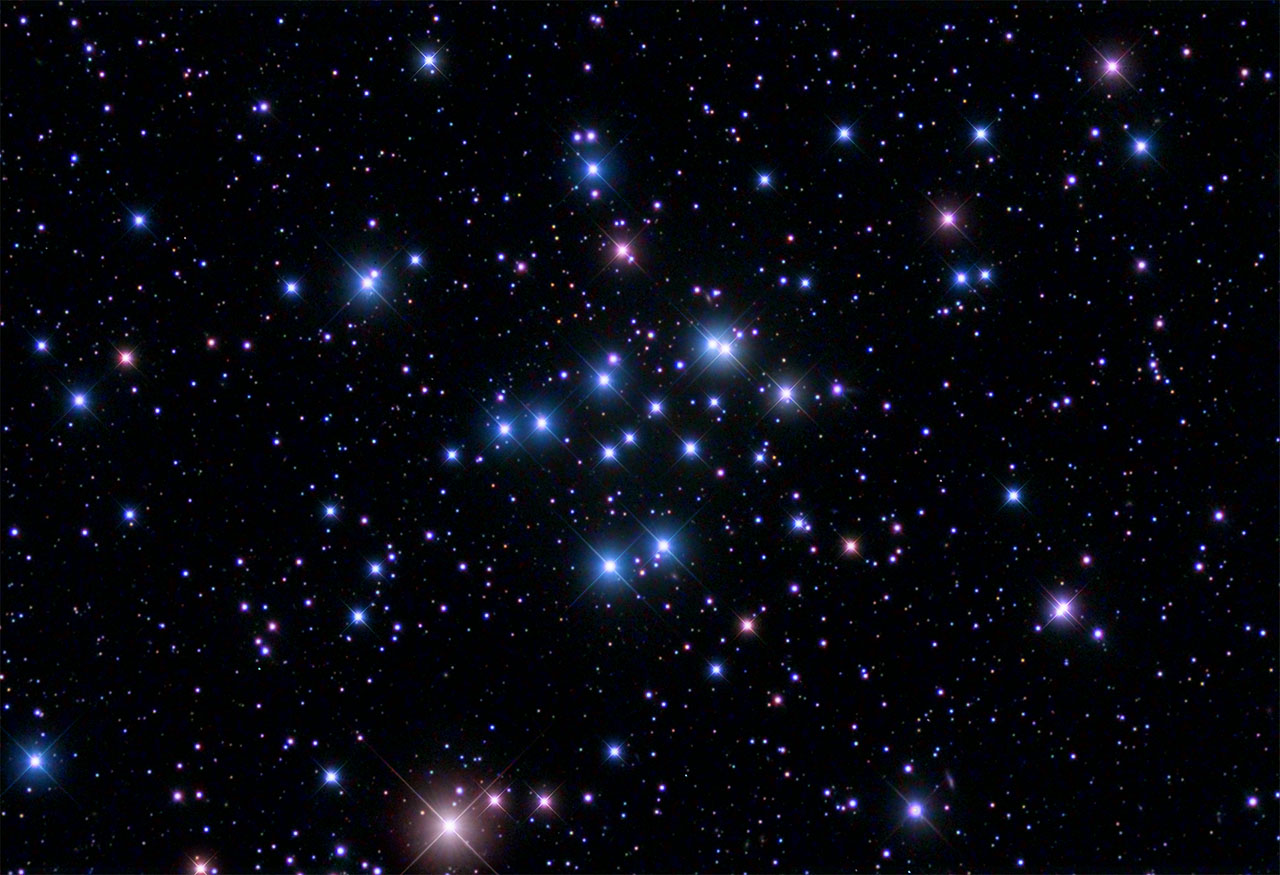 |
Messier 34
|
|
1st January 2019Clusters of Cassiopeia |
Cassiopeia is really cluster land with over 100 of the open type. It was a windy night and with the Moon present a simple target of the open clusters around Epsilon and Delta Cassiopeia was the order of the day. The prominent cluster is NGC 663 and this is the one you notice first if sweeping the area with binoculars. It stands out much more than M103 and many suspect that it is actually Messier's number 103. His description is not precise and either cluster matches his location but to me it has always seemed that the brighter NGC 663 is the much more likely candidate. Two of the clusters are Caldwell Objects, NGC 663 and NGC 559. Cluster IC 166 is heavily reddened - presumably by obscuration. It is pretty faint with only a couple of stars brighter than 15th mag (ref. Martin Burkhead). It is about 1 billion years old. Image Details
|
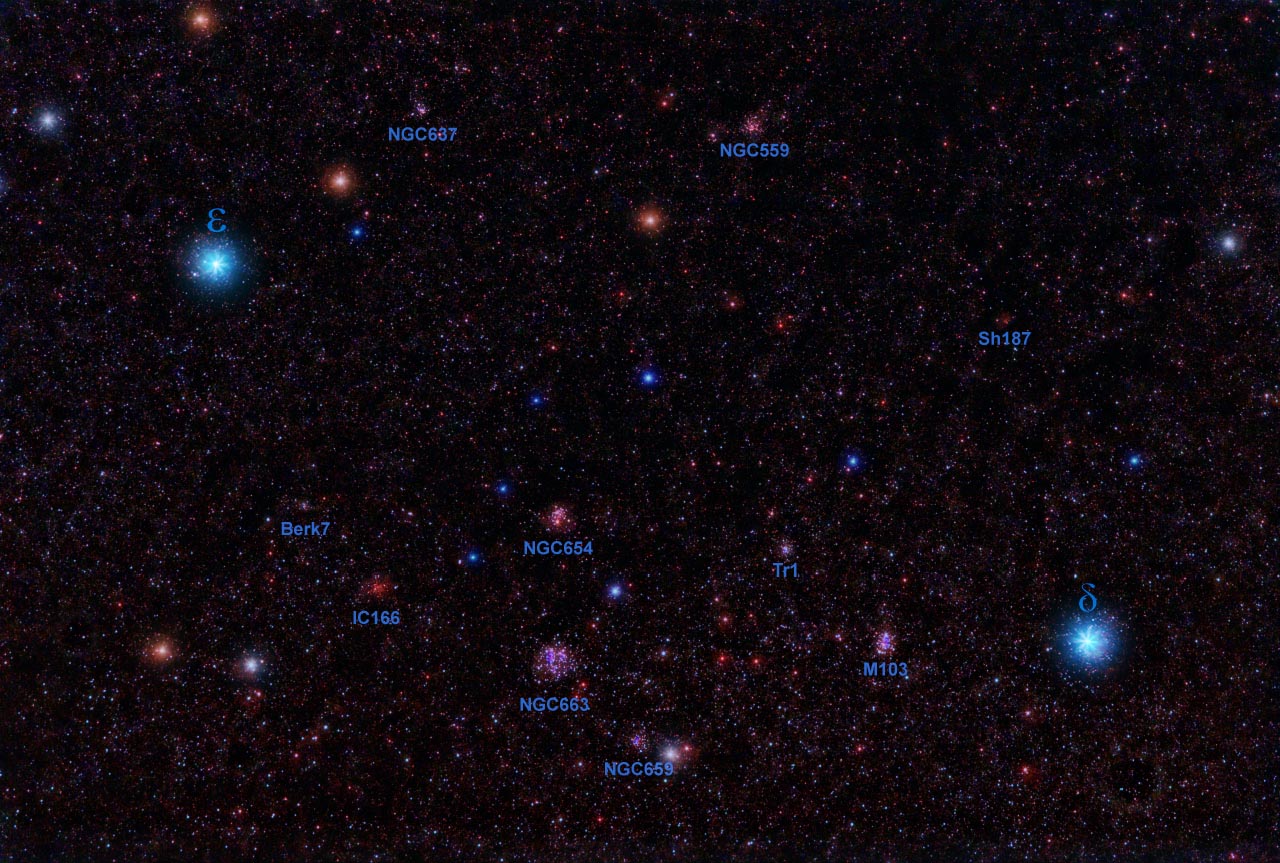 |
Cassiopeia Clusters
|
|
The imageBLOG continues at Archive 2017-18 Click Here
Recommended full colour book covering all aspects of digital imaging: "Digital Astrophotography - The State of the Art" edited by David Ratledge Order Online |
Please remember these images are copyright David Ratledge. Contact me before any use is made of them.
